This is a blog written by Yuuki Blakeney, ゆ(Yu) う(U) き(Ki), a forest school leader, researcher and parent in the school. Here she captures some of the learnings and benefits that she witnesses for one group of 3rd class children over the summer term.
It was a warm summery day on the first day of the 3rd class’s forest school. As soon as the children arrived at the meeting point, we could see their excitement and enthusiasm from the sparkle in their eyes.
The meeting point was an open field so we could make the most of this gorgeous season. We enjoyed seeing the seasonal flowers, such as dandelions, daisies and cowslips which are more likely to be found in sunny open fields than in our base camp within the woods. The forest is very busy in this season – the trees changing day by day with their new green leaves growing, the birds singing loudly and raising their chicks high in the trees. Some migrating birds are returning from the South too. Bees are getting busy visiting flowers and more insects are coming out from the ground.
Normally, children are allowed to explore the meeting point when they arrive until everyone gathers. So in the beginning, we went around to check the boundary together. It is very important to set a clear boundary in Forest School for children to safely explore within.
Even though forest school gives children a lot of freedom, there are certain rules that they need to follow in order to avoid serious accidents. We call them the Golden Rules (Keep yourself safe and happy, keep each other safe and happy and keep nature safe and happy) and we remind ourselves every time before starting forest school. In this way, children learn how to act responsibly and respectfully in the natural environment.
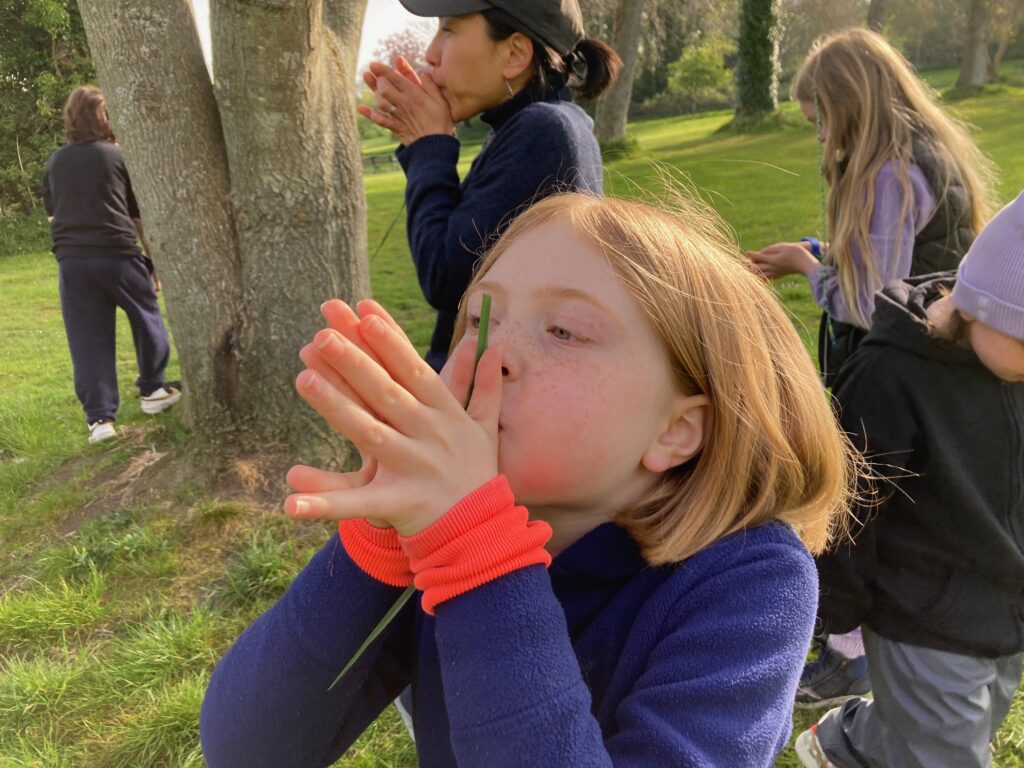
The children in this class had participated in forest school when they were in senior infants and in second class, so that they already seemed to have a good sense of nature. They found a larch tree with new fresh green needles, and first they wanted to know what kind of tree it was. The teacher didn’t tell the name straight away, and let the children observe the tree first. The children noticed the cones on the tree, and asked “Are they acorns?” Then the teacher explained “Acorns are only for oak trees, and pine cones are only for pine trees. But you can call them cones. This is a larch tree.” The next thing the children did was to touch the needles gently and say “Oh wow it is so soft!”.
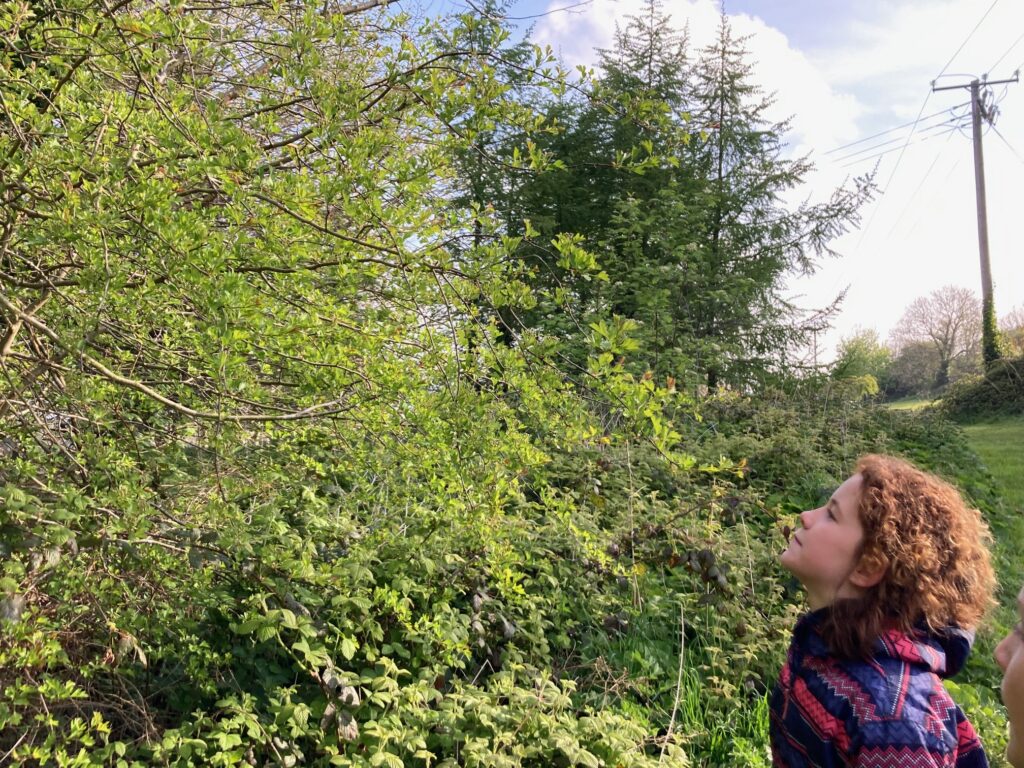
Nibbling the larch needles like a deer
Then another child asked “Can we eat the needles?” (It is hard to imagine that many other children look at a tree and try to eat its needles!) The teacher first reminded them that “Remember, never eat things from the forest unless adults say it is OK.”, and then, “Yes, you can eat larch needles”. Then the children tasted the fresh larch needles and shared their experience; A child said “It tastes like lemon!” Another child also smelled it and said “It smells like a christmas tree.” In this way, the children got to know the larch tree.
The next tree they noticed was a hawthorn, and with this tree, some of them already knew the name from previous Forest School sessions. They remembered the tree because they observed, touched, smelled and tasted it – some of them even remembered that it had a bitter taste.
During Forest school, children are encouraged to use their senses to get to know places and natural objects, and their knowledge about nature accumulates with their senses and their memories. Also, this fun way of getting to know the trees and plants seemed to encourage their curiosity about new trees and unknown plants.
After walking the boundary of the meeting point, we made a circle, remembered the golden rules and introduced ourselves with animal names and movements.
Then it was time to move to our basecamp. On the way, we stopped at cherry blossom trees, and picked some flowers and leaves for today’s nature tea. The assistant was from Japan, and the teacher realised that it could be a nice cultural experience for the children. Cherry trees are culturally significant in Japan, as they bloom all at once and scatter in an instant. People in Japan see it as a symbol of the beauty and fragility of life, and make the most of the moment by having picnics, parties, drinking, singing and dancing under the cherry blossom. So of course, that we did. The children and adults enjoyed making noises, singing and dancing under the cherry blossom trees.
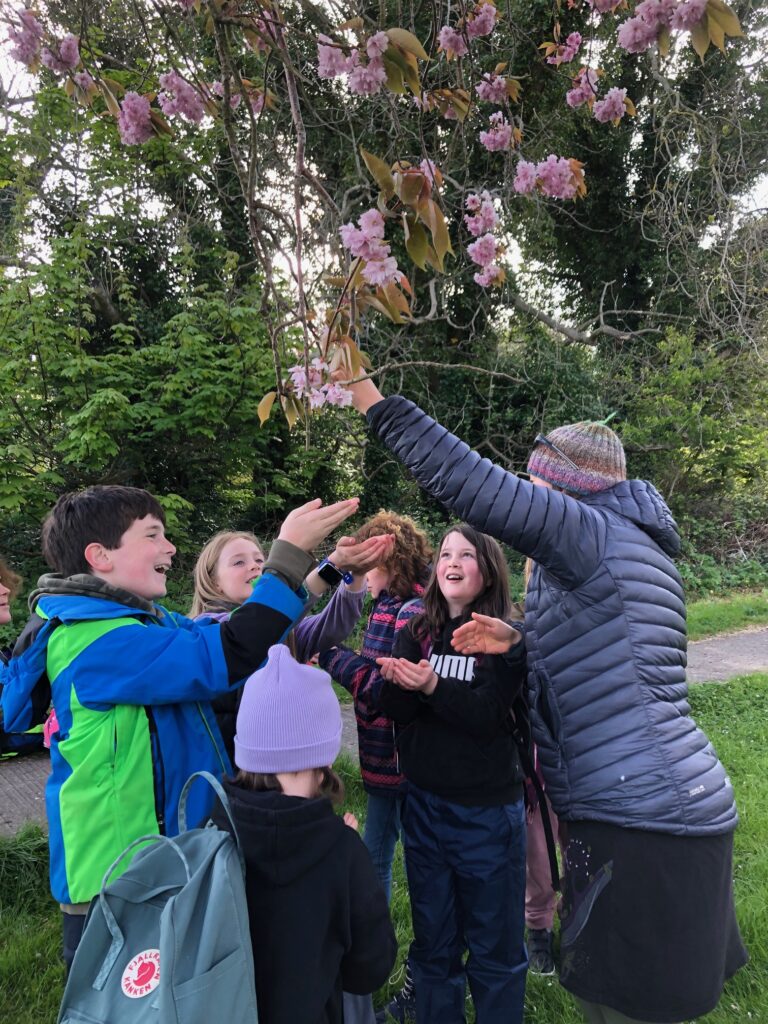
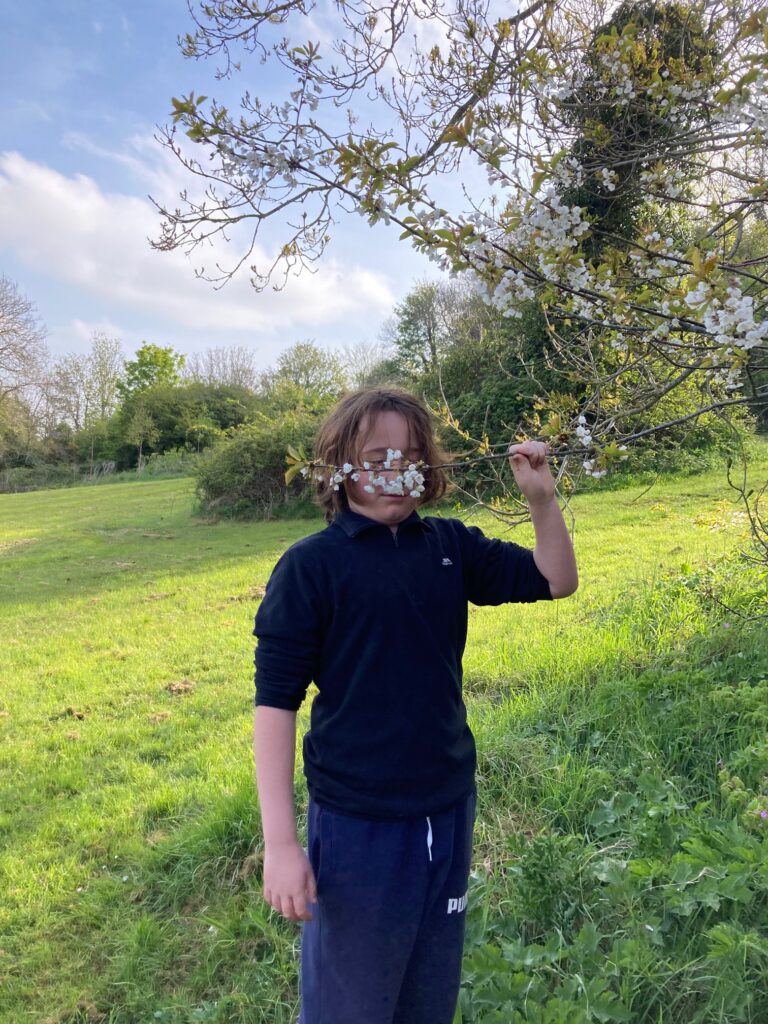
Also, on the way to the basecamp, we picked up some dandelion flowers. In forest school, usually children are not encouraged to pick up the living plants, but the teacher told them that if there were abundant species in Ireland and here, they can pick up only a few.
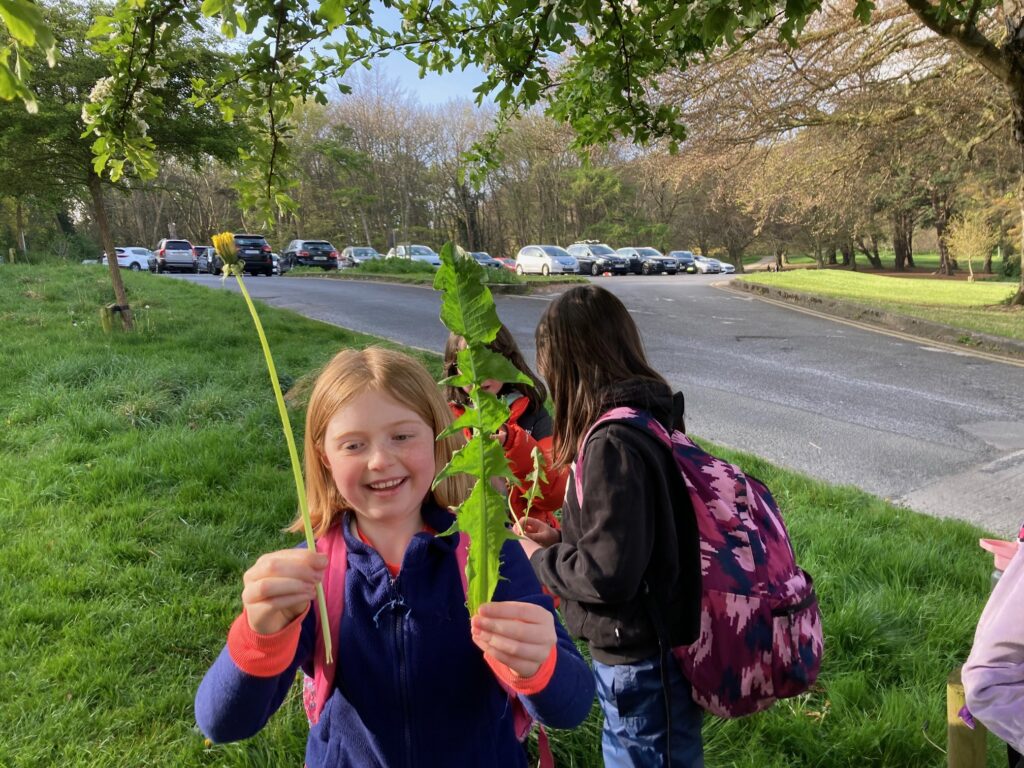
The children kept finding interesting places and things, and finally arrived at their basecamp.
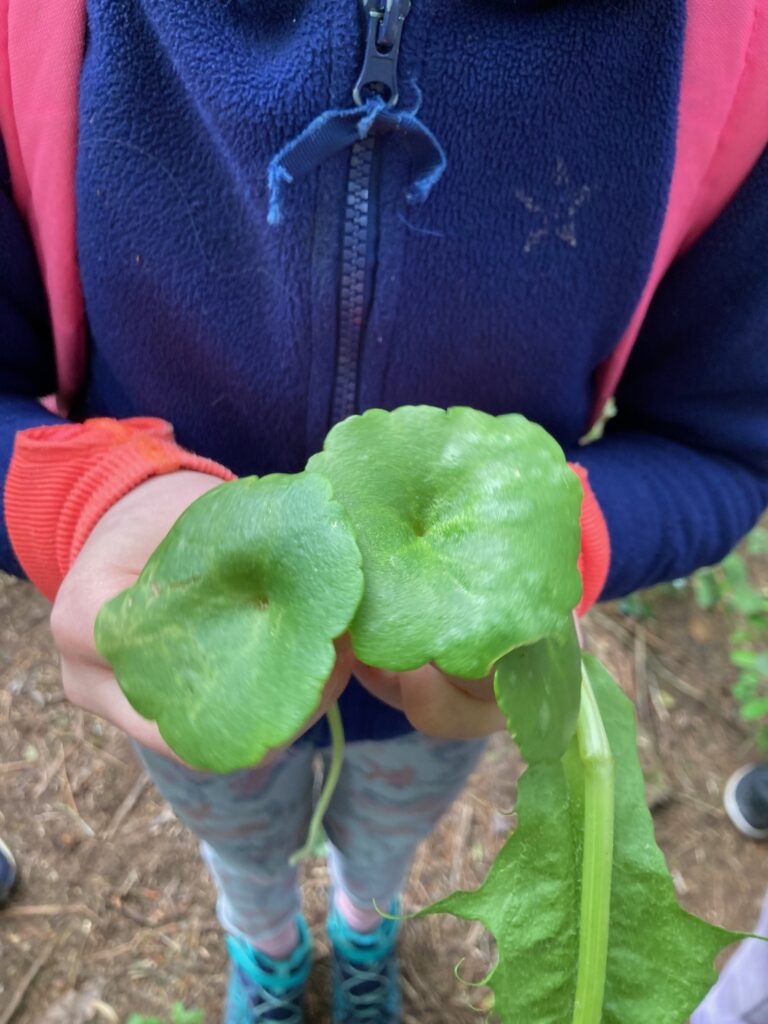
At the basecamp, we first conducted a site risk assessment, which involved the children in naming any risks and how they might keep themselves and each other safe. The children looked at the sites, and shared their opinions. From their previous forest School experiences, they were aware of most of the potential risks such as getting branches in eyes, gorse thorns, falling because of uneven ground, getting hurt by sharp objects like broken glass etc. The teacher also made sure the children understood the potential danger of climbing trees, by asking them how to check if it was safe to climb, and how high they could climb (They have to check if the branch is alive and strong enough, and they can go to the height where they can reach by their hands).
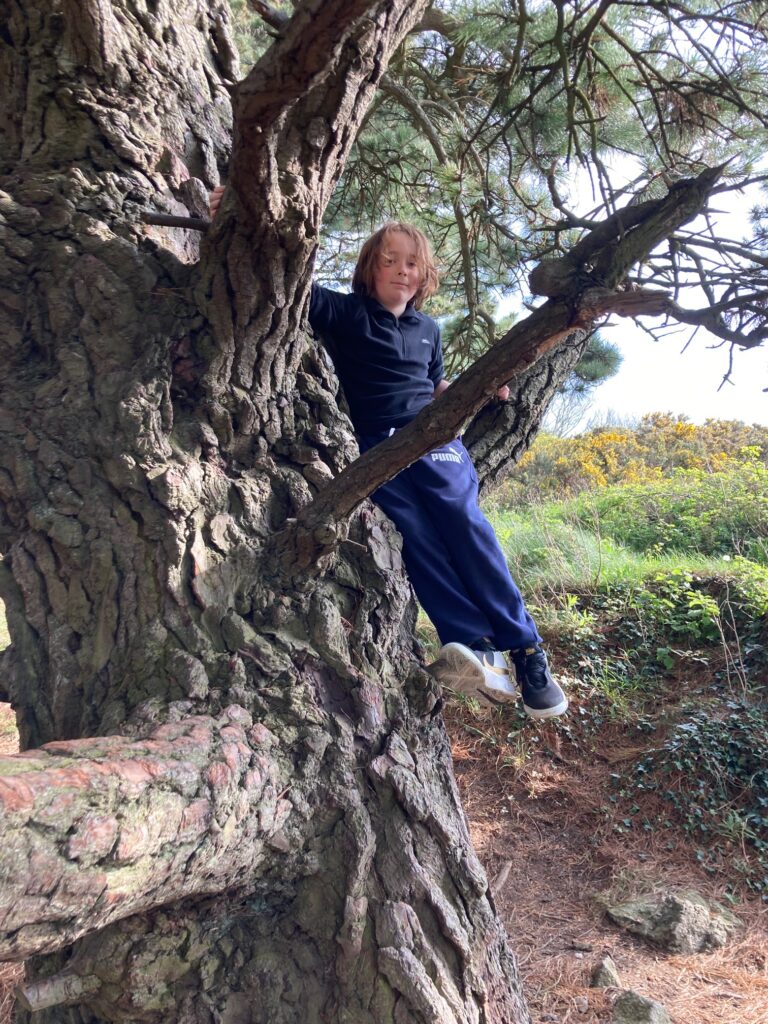
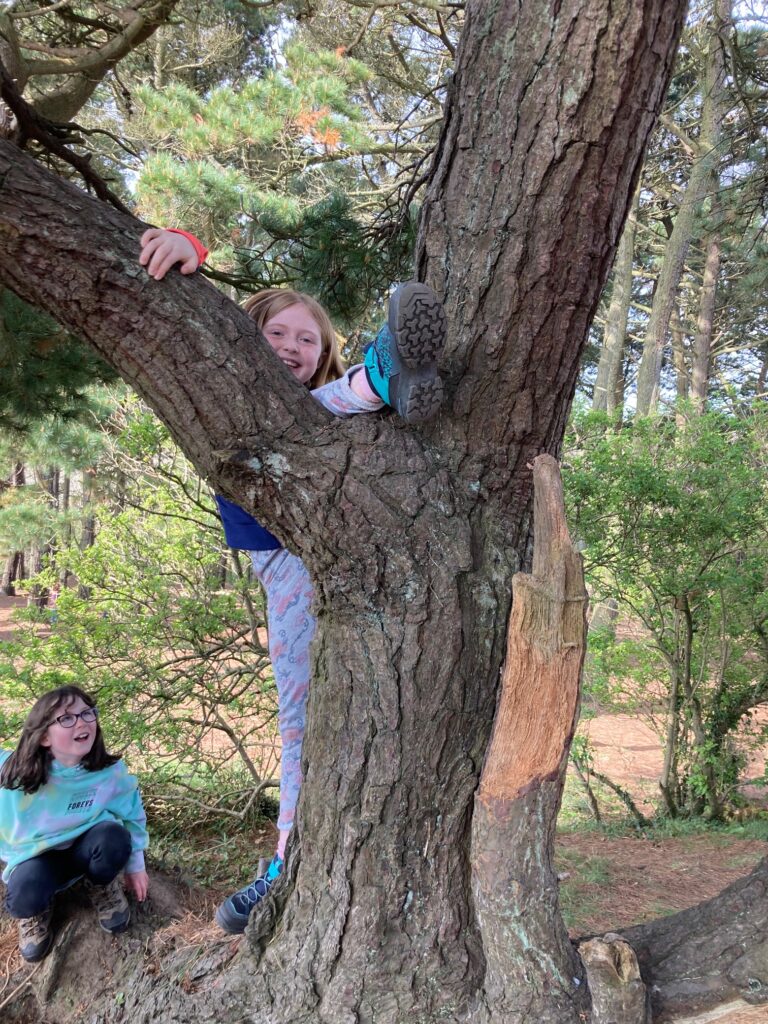
A core principle of forest school is to learn to take appropriate risks. In supporting the children to be aware of hazards and risks and how to approach them in a safer way they learn to build confidence and keep themselves safe. If we don’t give children space to learn to take appropriate risks all through their childhood they will be much more likely to take inappropriate risks in later years.
We confirmed our boundary by walking around it together, and then it was time for free play. As soon as we started the period of free play, everyone dashed away to do whatever they wanted to do. This age group (9-10 year old) of children seemed to play in groups more than the younger age group (6-7 year old), and more verbal communication was observed within the group, and they seemed to use more cognitive functions during their play.
For example, a group of children was digging a hole. Some of the children in the younger age group (6-7 year old) also loved digging holes, but they seemed to purly enjoy the action itself, which eventually led to the findings of living roots and dead trees turning to soil. However, the children in this age group (9-10 year old) had a purpose for digging. They wanted to find out why some parts of the ground under pine trees were so soft. They were digging the ground gently so that they wouldn’t harm living roots, and they found out that the roots were acting like hammocks to avoid the soil hardness. The assistant encouraged them to look at the soil more carefully, and they found that the soil was made of decayed pine needles, which were providing their organic matter to the tree as well as protecting the roots.
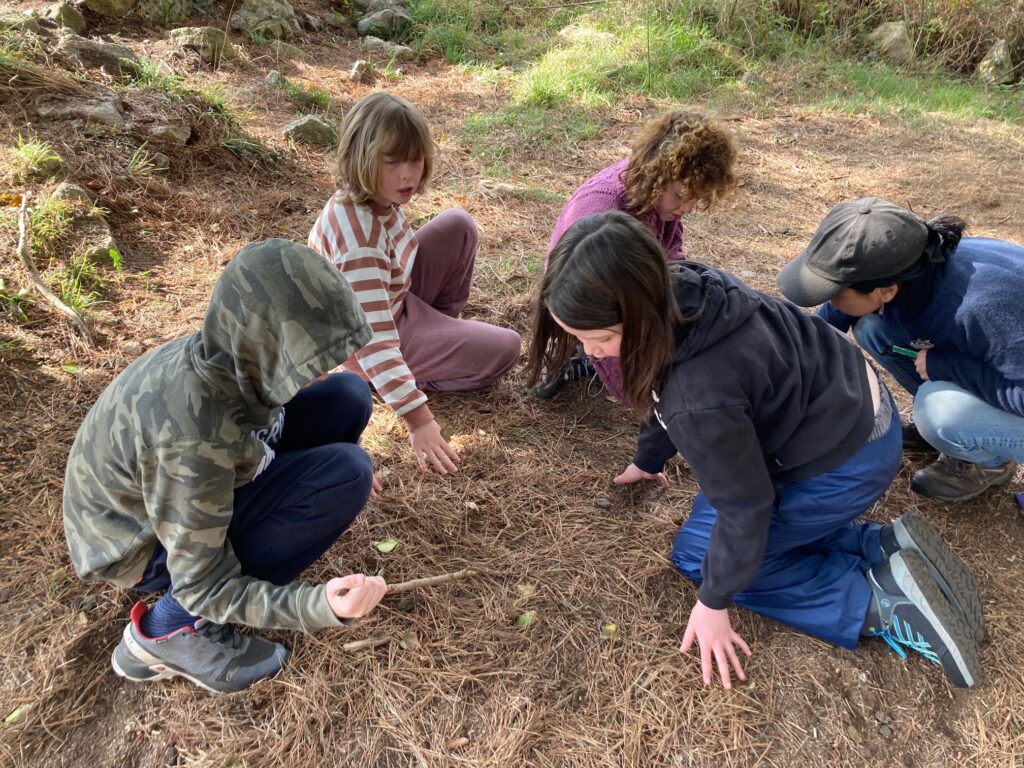
Also this group of children were trying to find “ground trolls”, and they were looking for the signs of their existence. For example, the ground trolls turn into rocks when they are dead, and they build their huts. They explained that there were signs everywhere in this basecamp, so they tried finding the signs and communicating with the trolls by giving presents. The imaginary world in this age group seemed much more in detail compared to that of the younger age group, the contents were more complicated like a story, and importantly it was shared between friends.
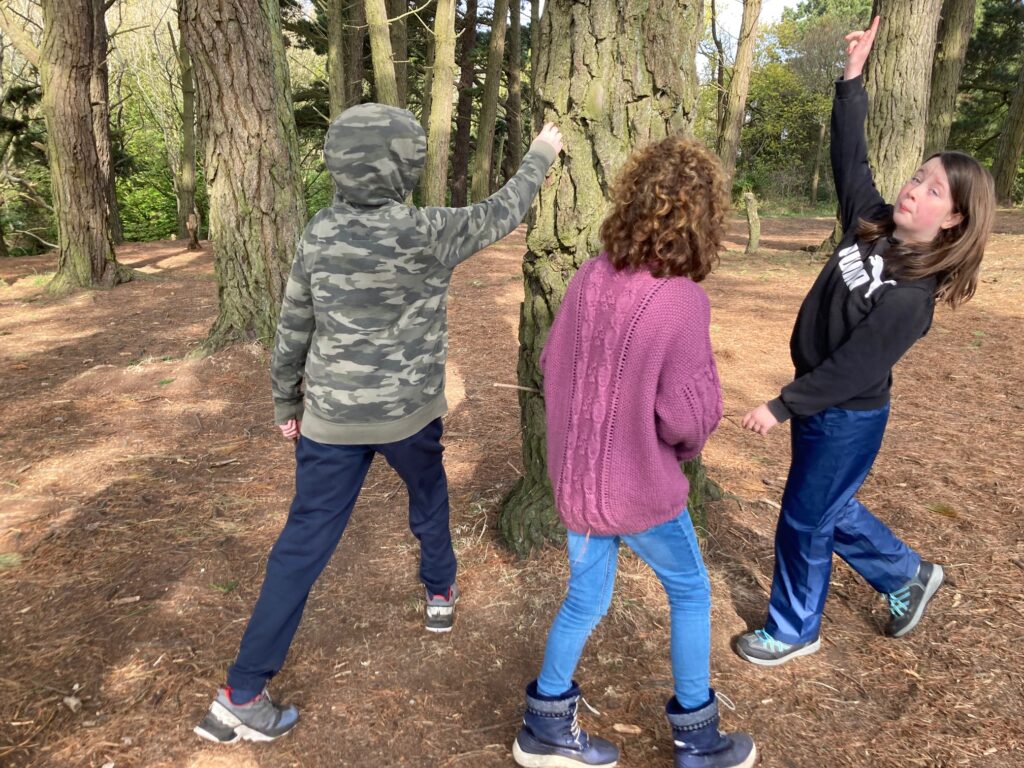
Forest school allows children to escape into their imaginary world. The world they created together might be based on games, books or movies, but they use their full imaginations and physical actions – they run around, shout, discuss the characters, create new story lines, and use natural objects such as stones, sticks, corns as key items for the story. Having free time in nature with their friends seems like something they need in their everyday life, and forest school seems to play an important role for them to enjoy most of their childhood.
Another group of children was working on making a hut. It was the same hut that the younger children also liked building. However, this time, the construction work was more strategic. First of all, they had a clear aim for the construction work, which was to build a “Green Tea Cafe”. So, they took all the branches away, and tried to build from the beginning. They called it a “Renovation”. They lined up the branches on the ground, and discussed which were the suitable branches for the foundation of the building. One of the children was struggling and frustrated because it was difficult to make the structure as he wanted, so he asked the assistant and the teacher for help. But the teacher said “I think it is much more fun to figure it out by yourself, but I can listen if you want to talk things through.” So he started to think again.
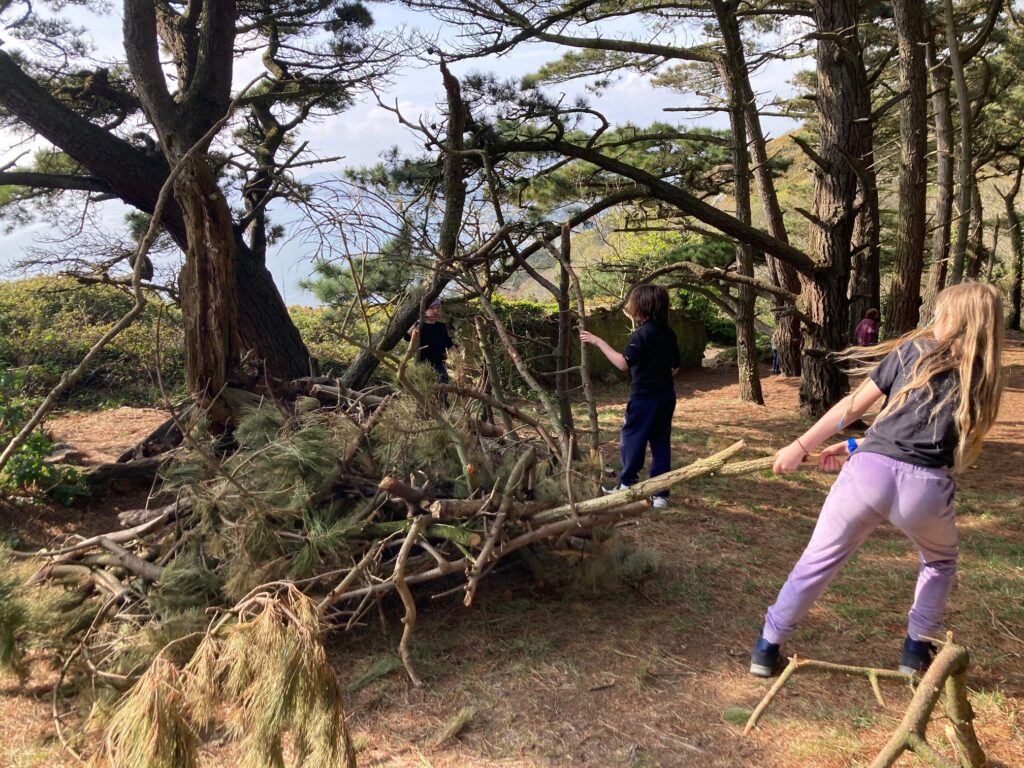
Another group of children loved climbing trees and challenging themselves. A child climbed quite high (up to the height she was allowed), and called her friend to look at her. She managed to come down safely, although it was tricky and she had thought carefully about the safest way to come down. She must be so used to climbing trees with her own trial and error from their previous forest school, so she was confident as well as sensible. Her friend was watching her, and wanted to go up next. So she asked “How did you do?” and the first child told her friend how to safely climb the tree. It was great to see the children teach each other.
In forest school, we constantly encounter new life and death. It could be trees, plants, insects, and other animals, and the children are able to learn life and death in a gentle way as well as interdependence and the circle of life in the natural world. This week, a child found a dead bird. It was lying at the bottom of the tree, in relatively undisturbed form, as if it was sleeping. Everyone gathered including the teacher. One of the children instantly started to dig a hole to make a grave. They discussed whether it was ok to touch dead animals but decided it could be infected, so they used sticks to move its body into the hole very gently. It was still soft, so the teacher said it would probably have died very recently. Some of the children discussed how it was dead. One child thought it had bumped into a tree and fallen; another child thought some other animal had attacked him.
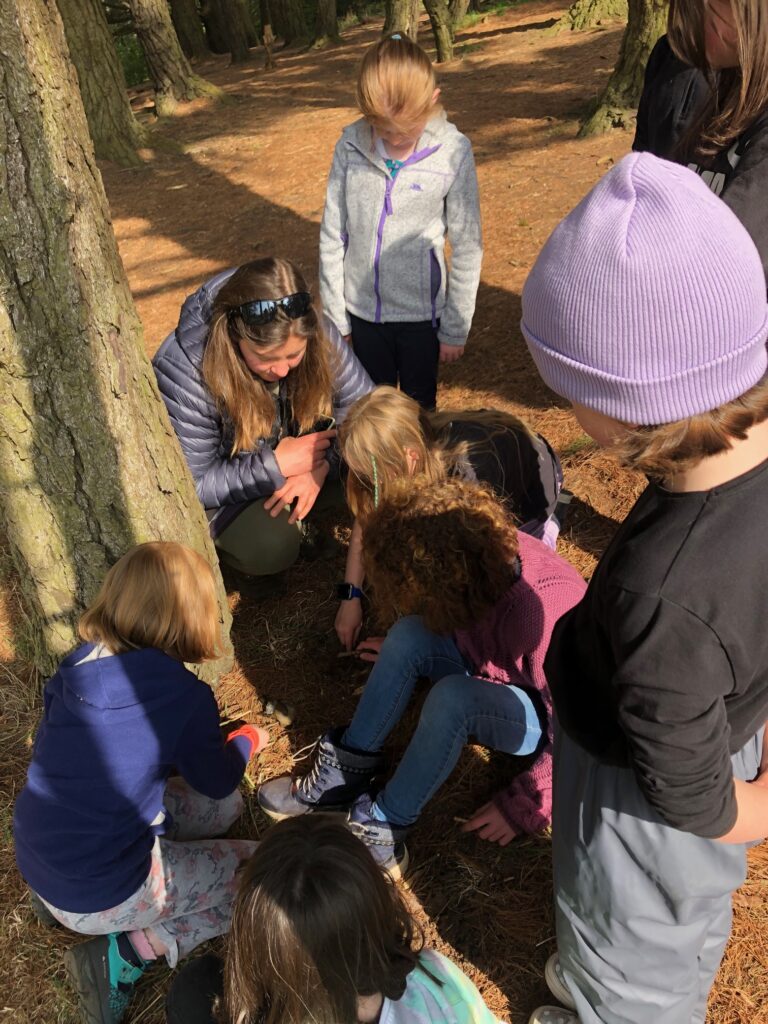
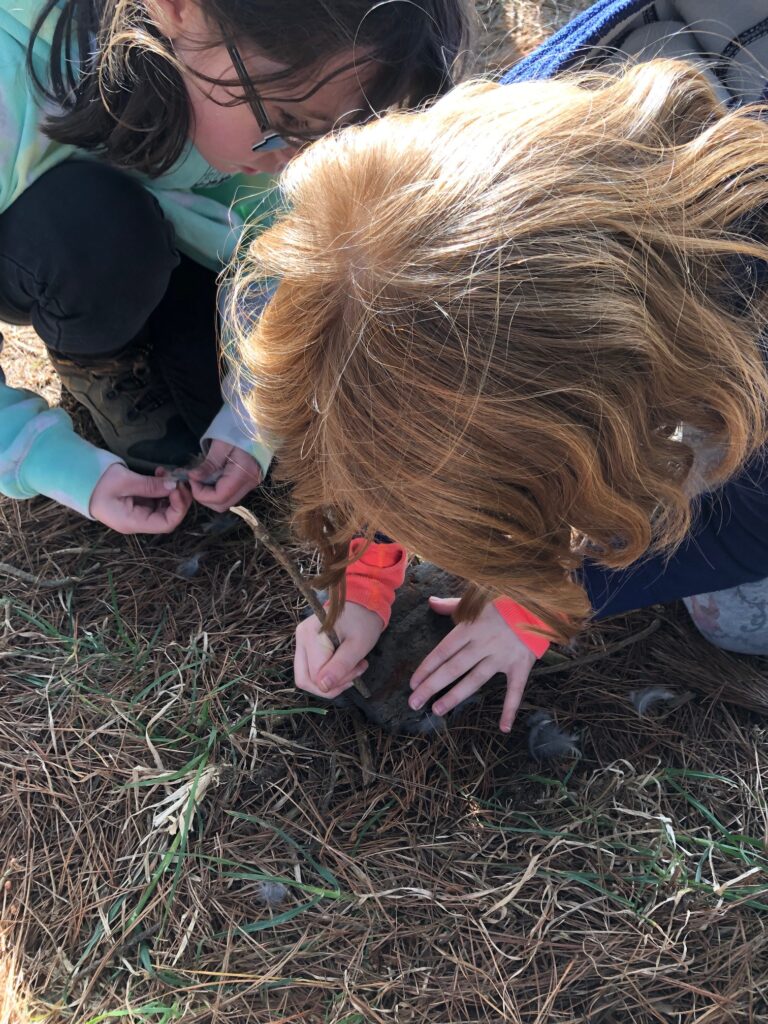
One of the children said “We shouldn’t bury him because the foxes will eat him anyway.” And the teacher said “That’s okay too, it is a part of life.” We make a grave to respect its death. The children eventually scattered away to go back to what they were doing, and some of the children continued decorating the grave and giving a ceremony.
Then it was time for lunch break. We always gather in a circle during lunch break, because this gives us a sense of unity by sharing our experience of eating lunch together in nature. The teacher told a dandelion story, and gave a dandelion to the circle to make a wish that they want to come true during forest school. Their wishes were “I want to find out the mystery of ground trolls”, “I want climate change to stop”, “I want to have fun with friends”, “I want to climb high in trees”, “I want to have a new school bag for forest school”, and “I want to finish building the Green Tea Cafe”.
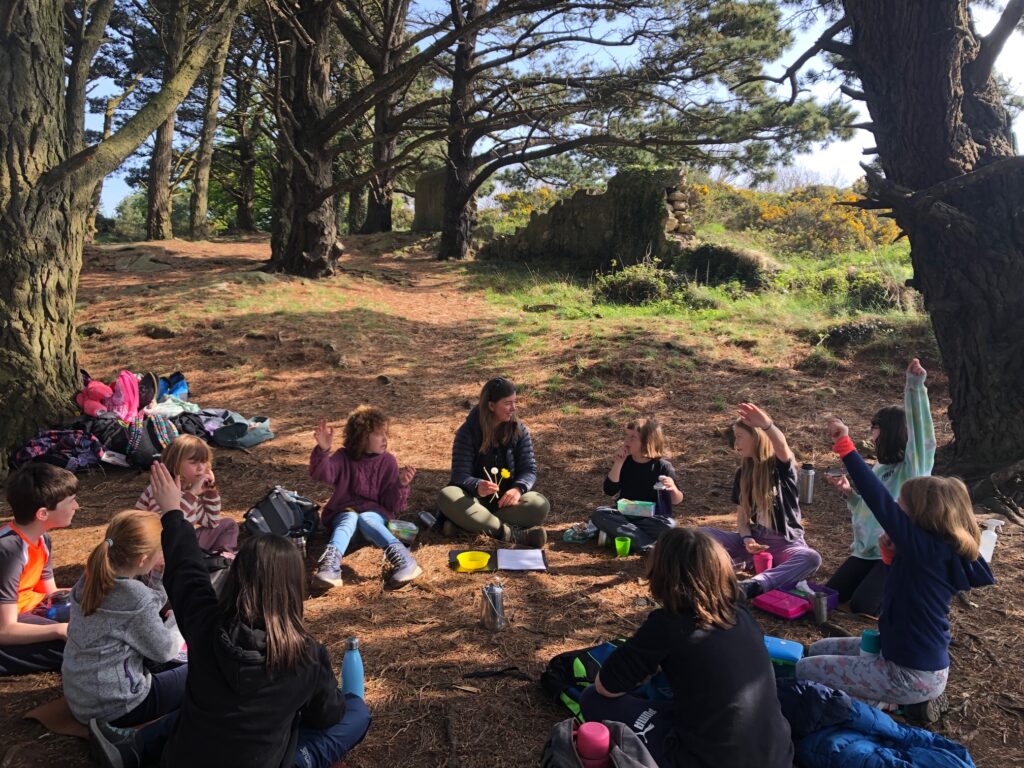
Then we had a Cherry Blossom Tea Ceremony. The children learnt that the Japanese traditional Tea ceremony is the art of serving, receiving and drinking green tea. It developed in the 16th Century when the society was divided by hierarchies, but inside of a tiny Tea Ceremony room, everyone was equal and they could also be apart from real life. The door is small so that guests have to bow to come in (bowing is an important gesture to show respect). So we bowed, and each of the children were given tea one by one. They admired the smell of the tea and then we shared what we are grateful for and drank the tea.
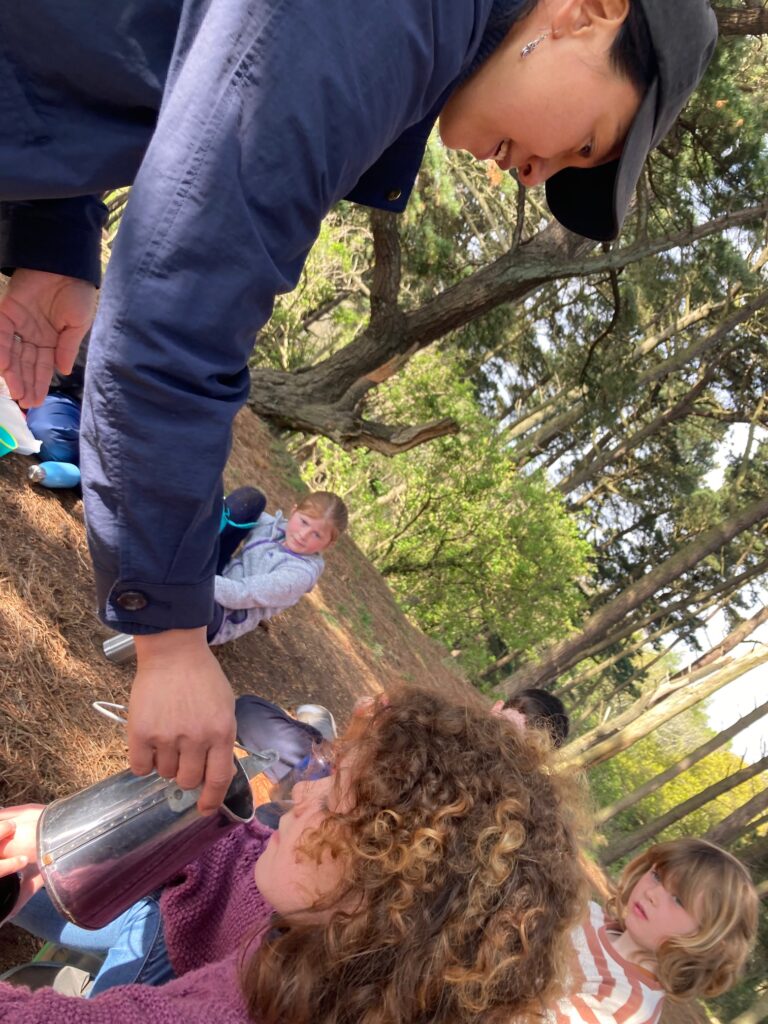
After this, we played a quick Eagle Eye game, and it was time for the sit spot. Sit spot is an important element in forest school which gives children a moment to be in nature. Before the sit spot, we gathered in a circle and the teacher asked the children to share what they can see, hear, feel and smell and send them to the quiet spaces and stay still for a few minutes. We shared what we found in the circle after that, and left the basecamp.
There was so much happening in only two and half hours. Because of the previous forest school experience when they were younger, they already seem to have an attachment with nature and with the place, and they have receptive antennas to what they can take in from forest school – their senses are awakened, their mind in motion, curiosity drawn out, constantly trying to find something new or different to do, which they always do. Because of the experience they had when they were younger, they don’t miss the opportunities that present themselves to learn from nature, from friends, and from surrounding adults.
On the day of this second session together, the sky was grey with thick layers of clouds. While waiting for everyone, some children started to play with Ribwort plantain. This is a native plant in Ireland, and the tiny flowers in terminal spikes were just in bloom. Because this plant is widespread in Ireland and in Killiney Hill, the children could pick some of them and play with them. One of the children knew how to make the flower head fly with its bending stem, and she proudly shared her technique with others. The children also enjoyed a soldier game, fighting each other with the plantains’ long stems. Some of the children were brave enough to taste its leaves, which the teacher told them are not poisonous but have a bitter taste!
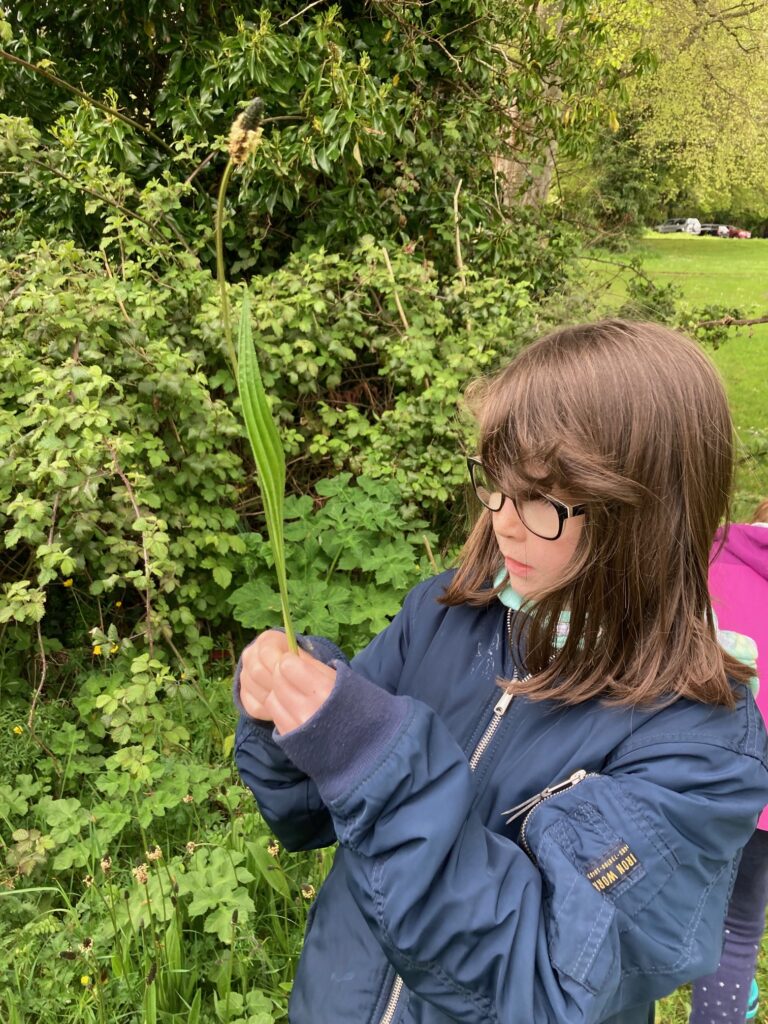
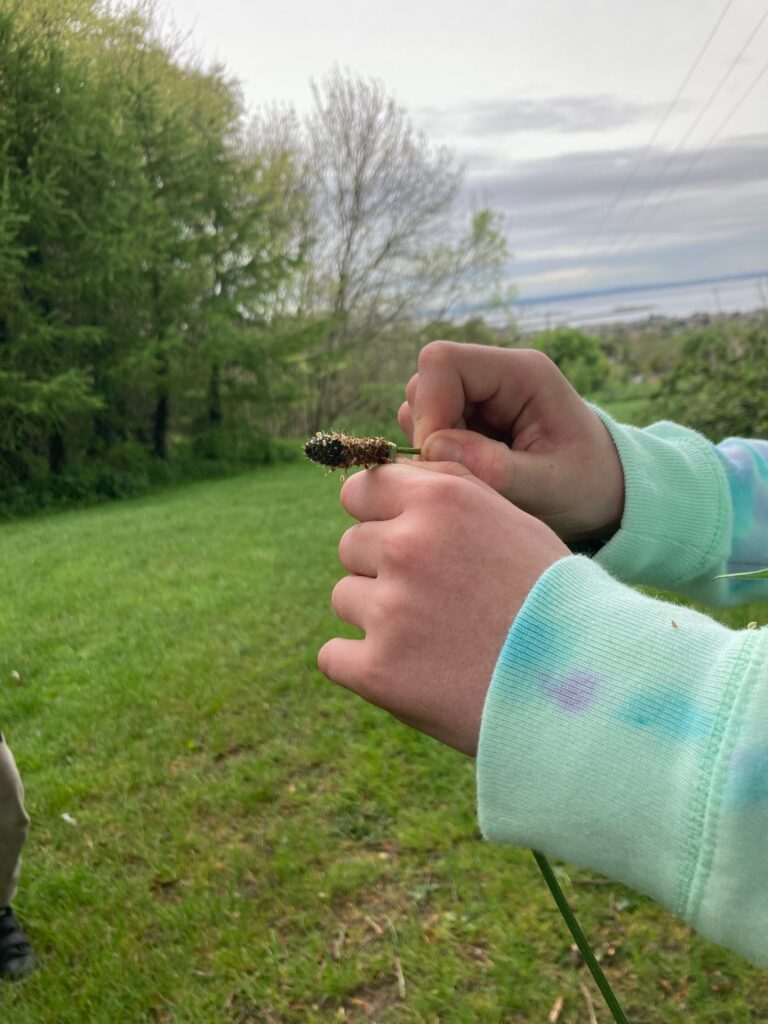
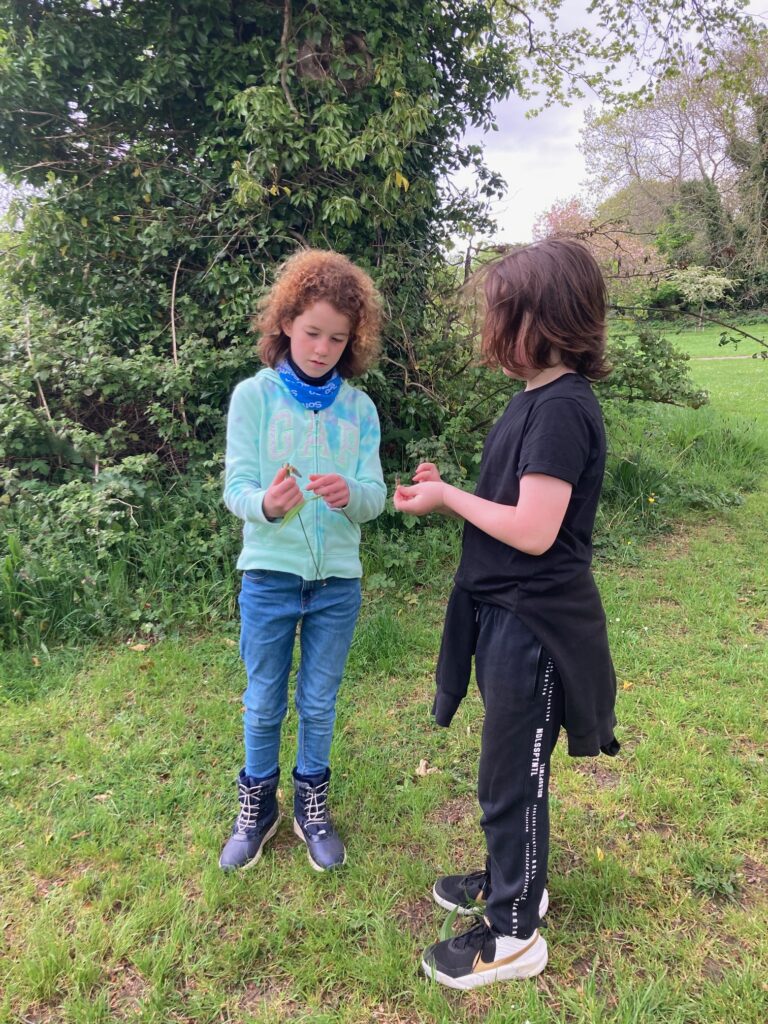
When everyone gathered, the children were invited to look at Ribwort plantain carefully in pairs, and to pick something that other people wouldn’t notice and discuss their findings. A pair of children noticed that the bottom of the stem was red, and the shape of the flowers looked like oats. Another pair noticed that the stem was hairy and its section formed a star shape. Another pair peeled a leaf and noticed that the veins were strong and coiled up when they were exposed to the air. It was a great activity to encourage the children to look at the plants closely and learn about them with each other. They noticed things, which even the adults didn’t know.
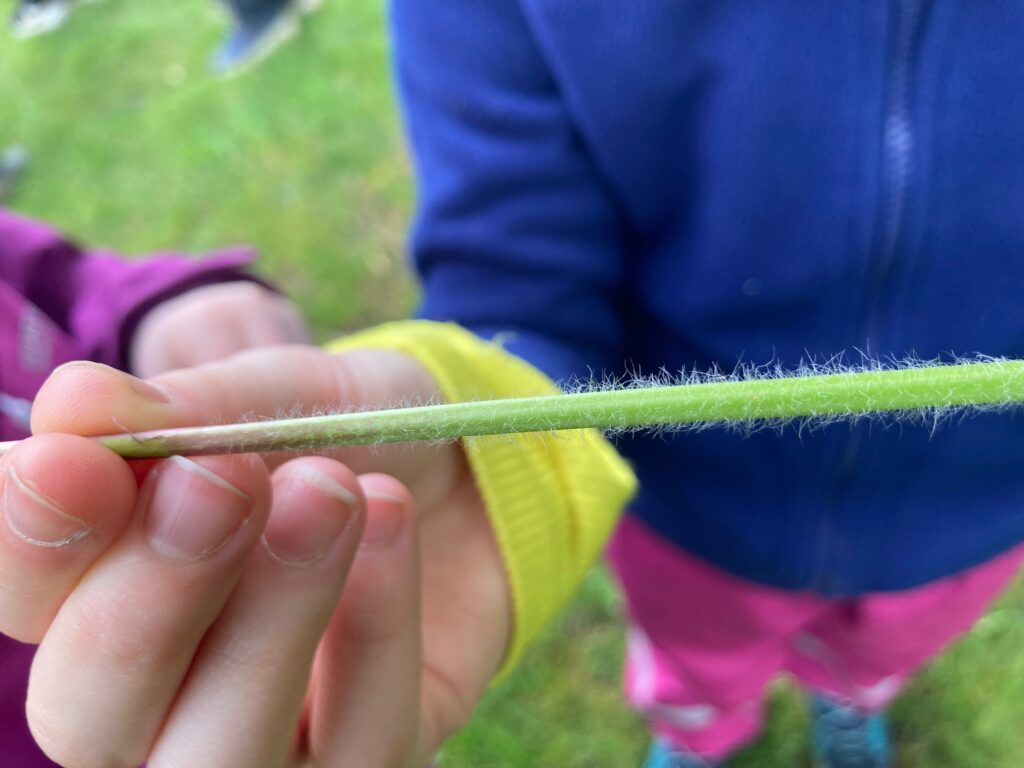
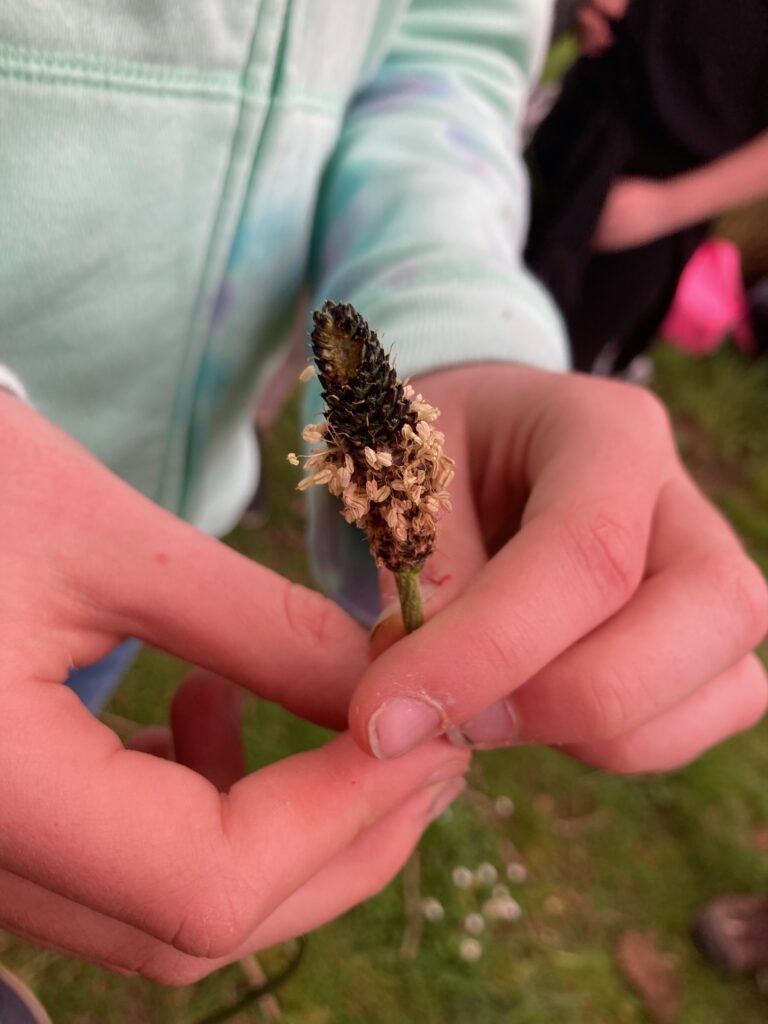
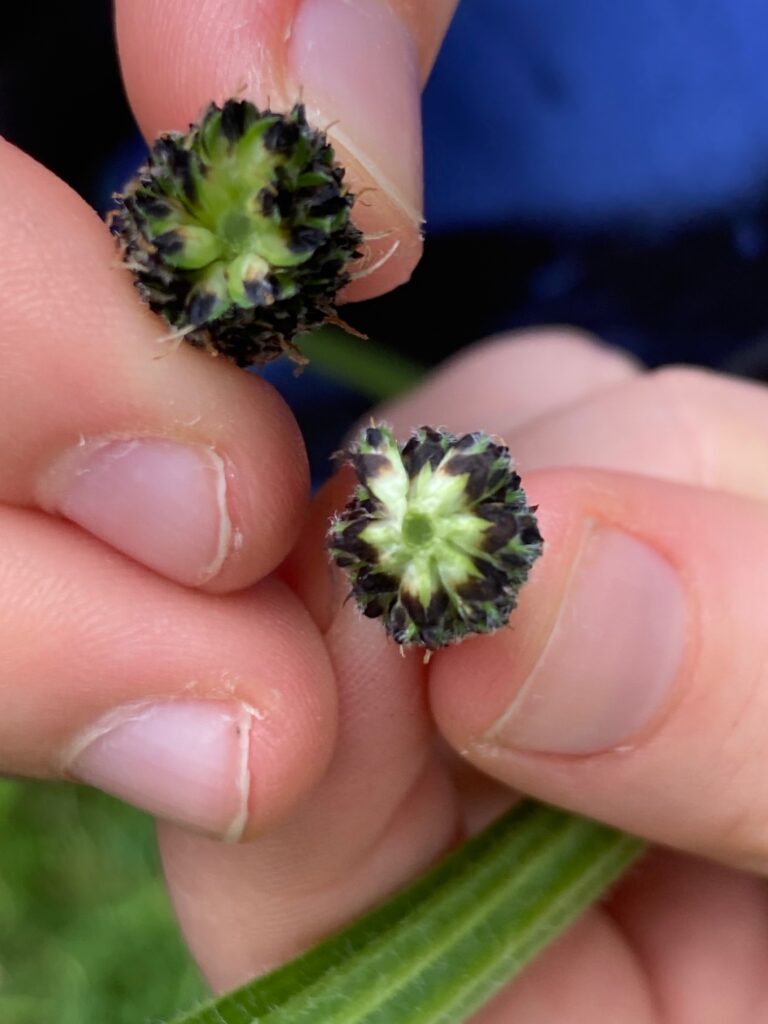
After everyone shared their findings, the teacher introduced more about this plant. For example, this was called “Ribwort plantain” perhaps linked with the way the veins of the leaf can look like a human rib. In Irish it is called “slánlus”, which is translated as ‘health herb’ as it was used as a medicinal plant in the past. It can still be used as a cure for nettle sting.
Soon after the teacher explained this, one of the children was stung by a nettle, but luckily she knew what to do. She immediately put a plantain leaf on her finger, and felt better. A bad experience like being stung by nettles led to development of knowledge about the properties of Ribwort Plantain, and an understanding that being stung by nettles is not such a fearful thing. These little nuggets the children get from forest school are a form of wisdom that they can pass on to others, and even to the next generations.
Having forest school at this time of the year is great as we can see so many changes week by week. More and more leaves are growing, the flowers of some trees have gone, and some berries or seedlings have started to form. On the way to the basecamp, the children were encouraged to pick out something which had changed from the previous week. Under an ash tree, children noticed that more buds were bursting and more leaves were growing. One of the children also noticed that there were more leaves growing on one side. Then the teacher asked them why this could be. They didn’t have a good answer, but when the teacher introduced them to the sun’s movement, they learnt that the side that had more growing leaves was the south facing side.
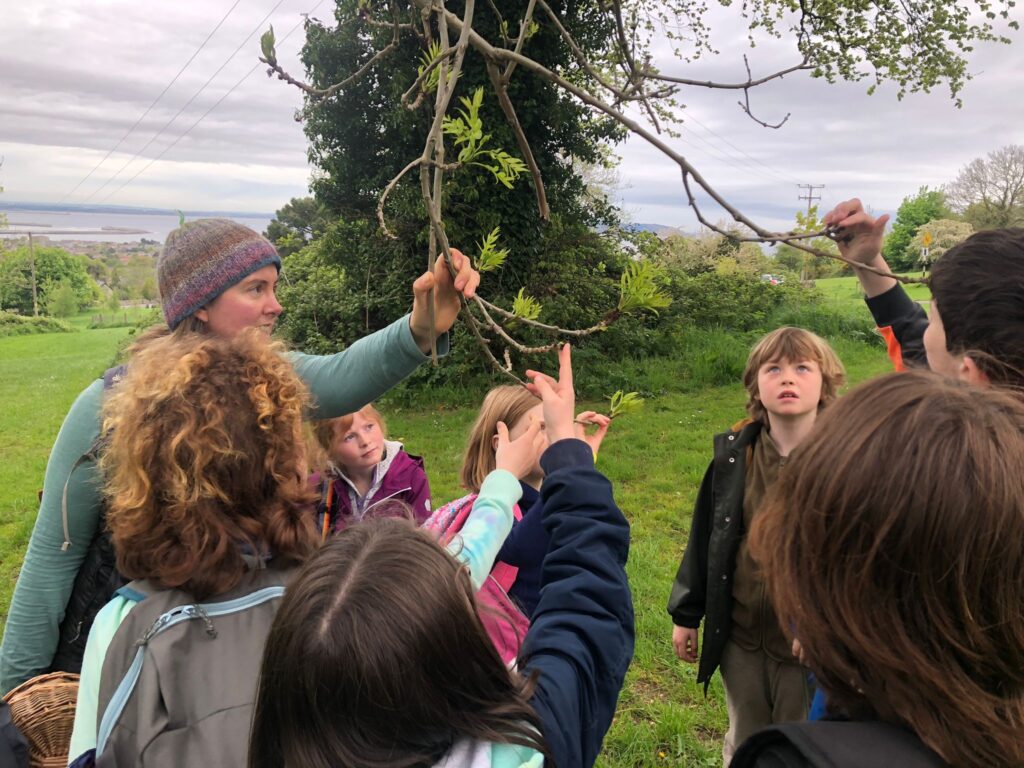
Forest School learning is so organic that the content of the sessions is formed by how the group of children act and interact, and how the forest school leaders and other adults react to their questions, actions, curiosities, findings and needs. In this case, without this curiosity coming from the children, and without a teacher who picked up on it, the group of children wouldn’t have learned about the relationship between tree growth and aspect.
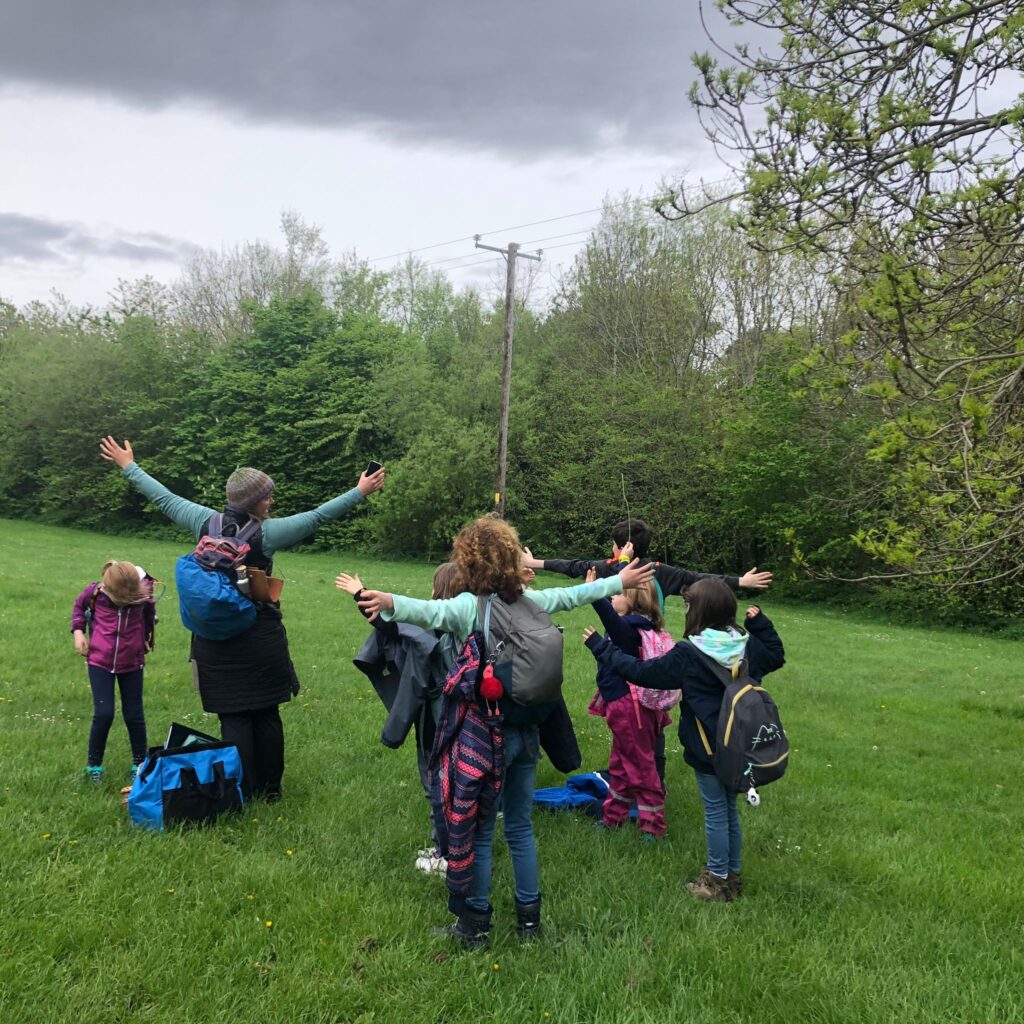
After that, we moved to the cherry tree where we had danced in the previous week. The children noticed that the blossom had almost gone, and the leaves were bigger. The ash tree bore tiny ash keys which will become like helicopters in the autumn. The children then could not help rolling down the hill, which looked so much fun.
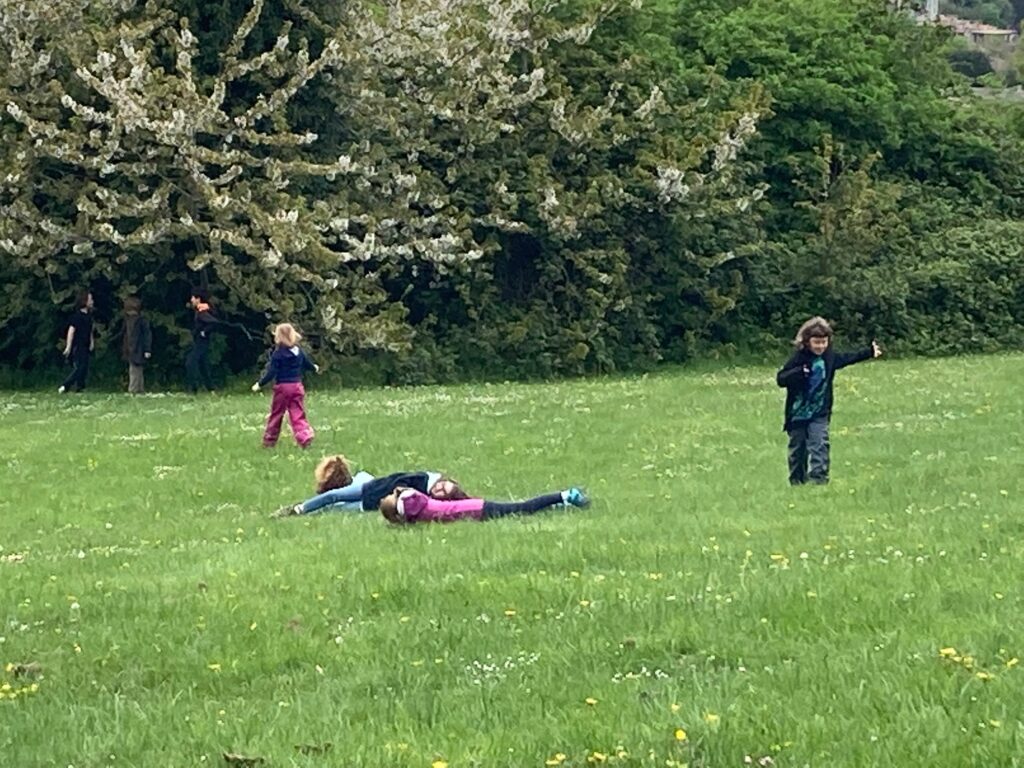
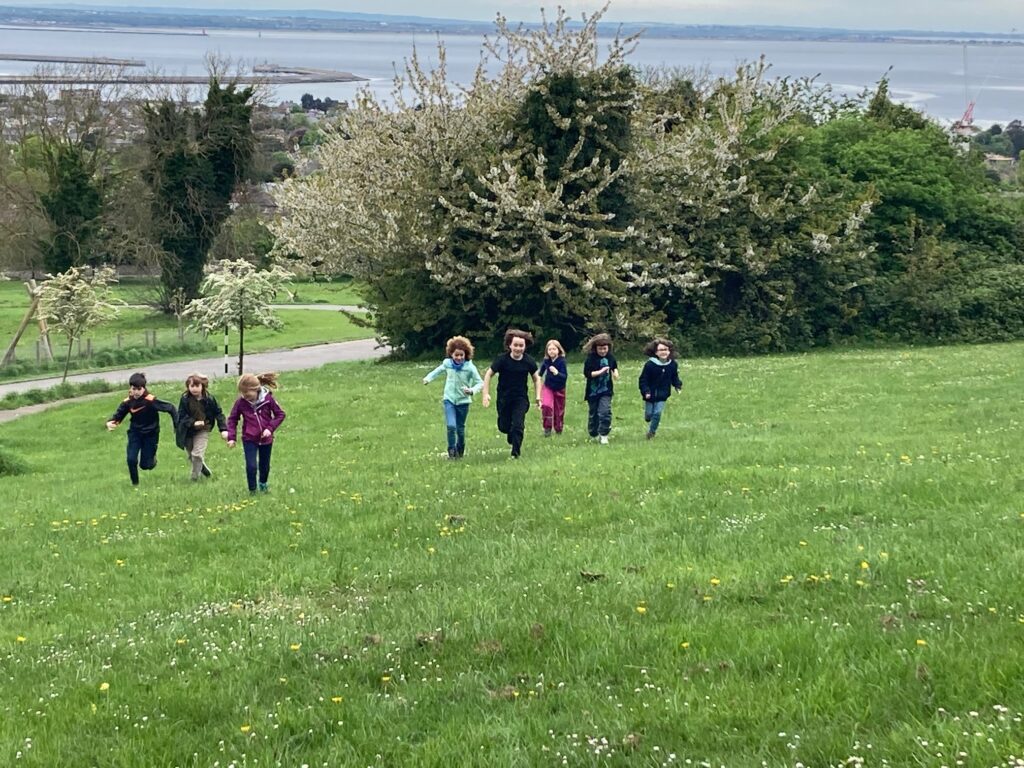
Children need to move and play outside on a regular basis in order to develop healthy sensory systems. Rolling down hills is one way to increase our body awareness and sense of space. Our vestibular or balance system is challenged by moving in all directions while rolling down grassy hills. Rolling also helps provide necessary stimulation to the muscles and ligaments in the body. This helps improve the proprioceptive sense and sensory processing.
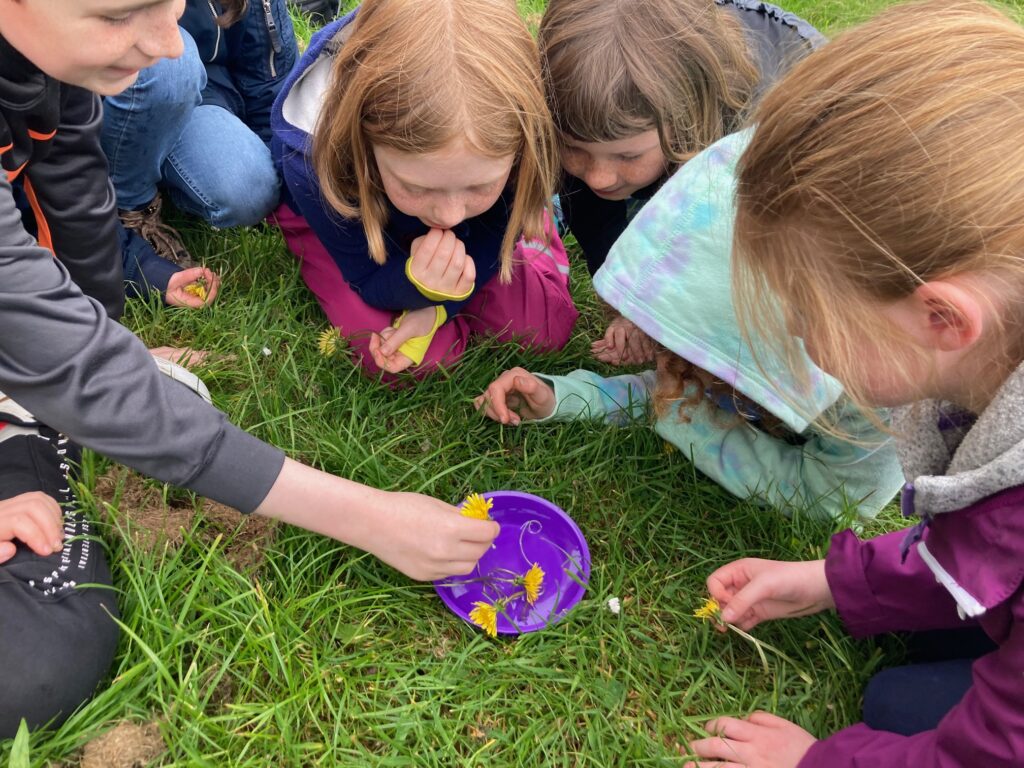
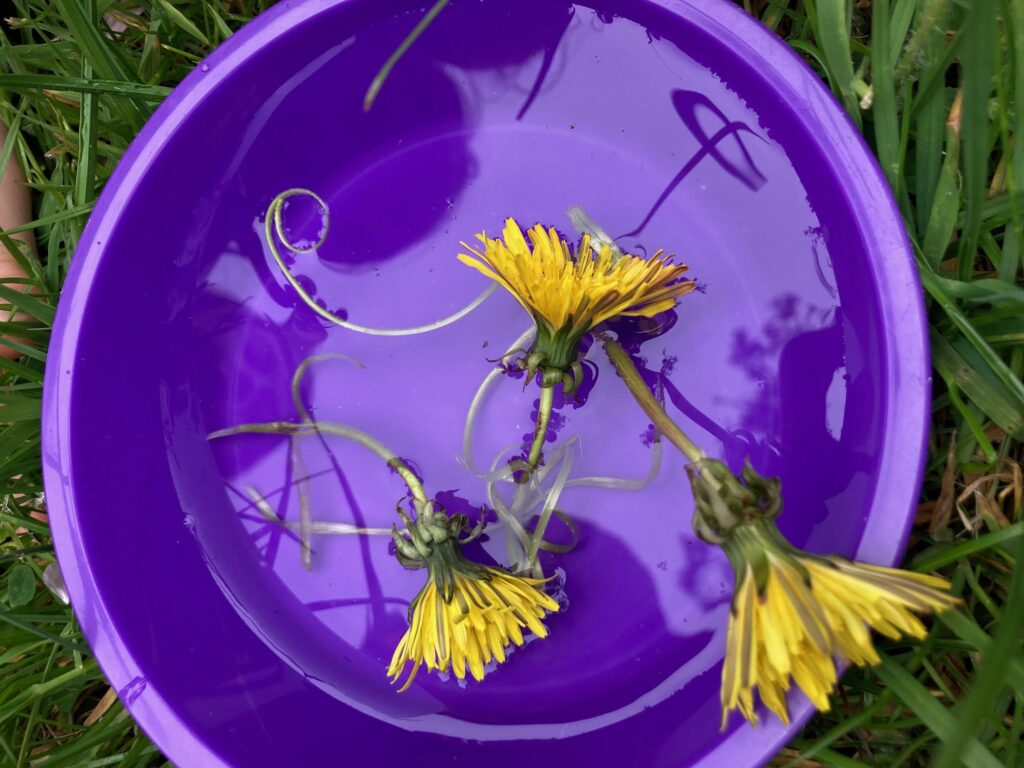
Because there were so many dandelions in the open field, we picked some dandelion flowers from the bottom of their stems, and carried out an experiment. The children peeled the stems of dandelions in a few strips and put them in the water. Then they watched the stems curl up. They discussed why this happened, and learnt that the inside of the stems were “hydrophilic” (water-loving) and the outsides are “hydrophobic” (water-hating), so that the insides absorbed so much water that they swelled, while the outsides remained the same size, which forced the strips into curls. In this way, they learnt about the structure of the dandelion stems and the mechanism of how they absorb the water from the ground. A child put a clover leaf in the water for another experiment, and found that the leaves were waterproof.
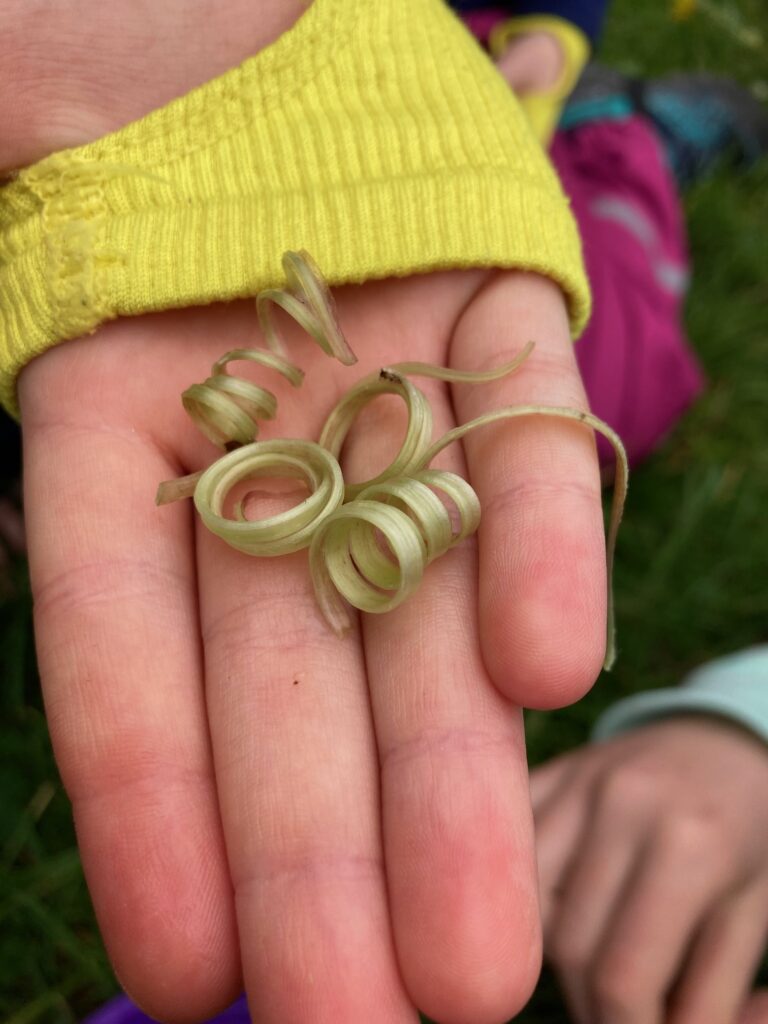
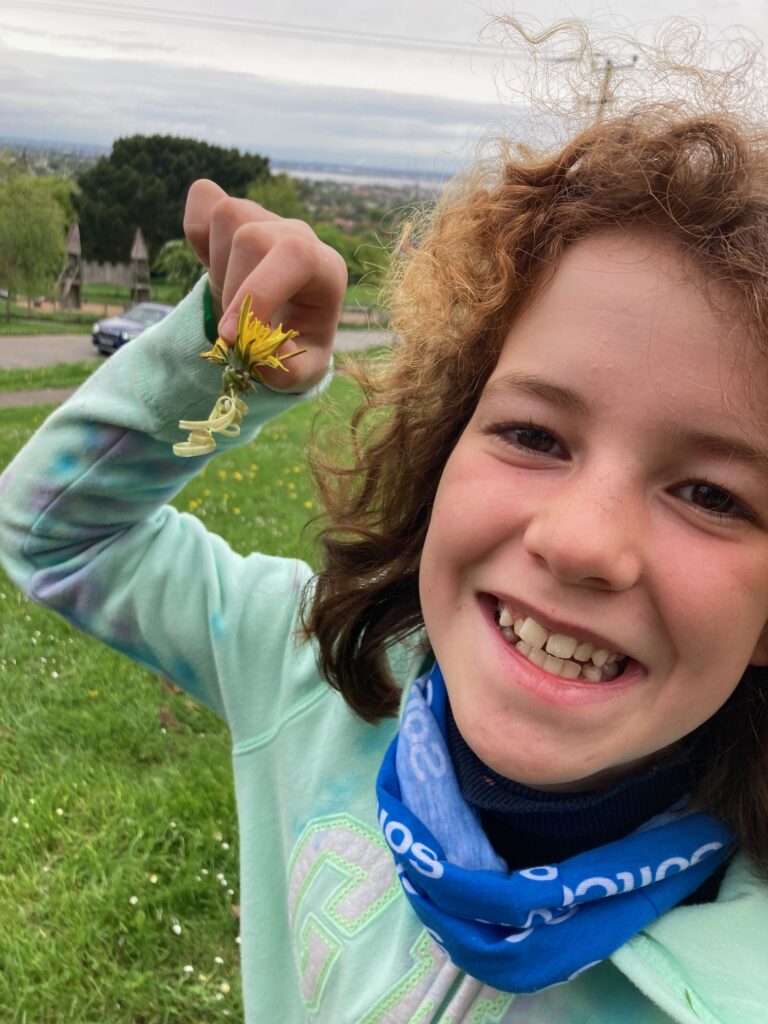
When we arrived at the basecamp, it was time for free play. Some children built a den, which they wanted to use as a café, and they used a bundle of pine leaves as a duster to clean the floor. Others were trying to find signs of ground trolls.
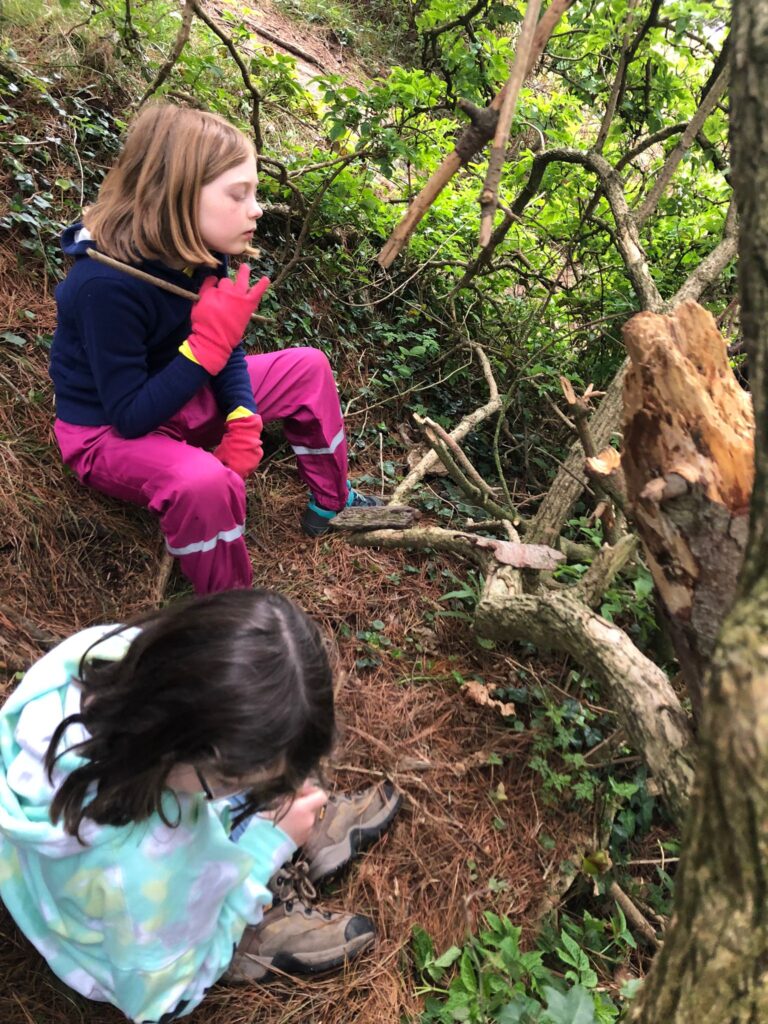
Some of the children in this group were so curious and knowledgeable about trees and plants. From the previous forest school, they knew the inside of elder tree branches have white soft parts. A child questioned why some of the elder leaves had strange patterns, which the leader had never noticed and didn’t know the answer to.
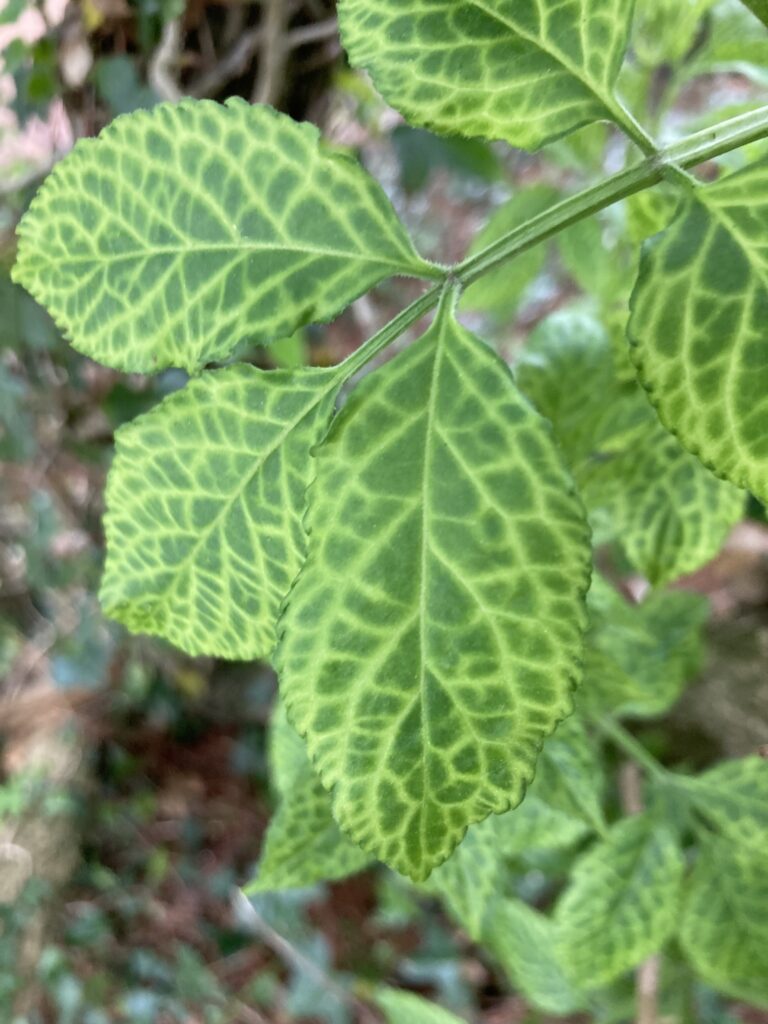
Compared to the younger age group (6-7 year old), this age group of children (9-10 year old) seem to have more desire to know the plants’ names, and why and how certain natural phenomena happen. They enjoy finding out facts, carrying out scientific observations and conducting experiments together. They absorb knowledge like sponges.
After the free play, the teacher introduced a “bird game”, in which a team of three people act as parents and a chick, and the parents need to collect food without being caught by predators. It was a great game to understand how hard it is to be a bird and protect chicks as well as collect food for them. They developed more empathy for our non human friends through play based learning.
At lunch time, the assistant (i.e. me!) talked about forest bathing. This word came from Japan (“Shinrinyoku”) and it is embedded in Japanese culture. When we walk in the forest and are immersed in nature, our body and mind are so relaxed and refreshed, and the healing effects of nature have been used by medical professionals in some parts. Knowing these effects might give children resilience in their life when they feel stress and have inner problems. Having this in our mind, we went to have our “sit spot” which is a few quiet moments we take in nature each session, and experienced forest bathing.
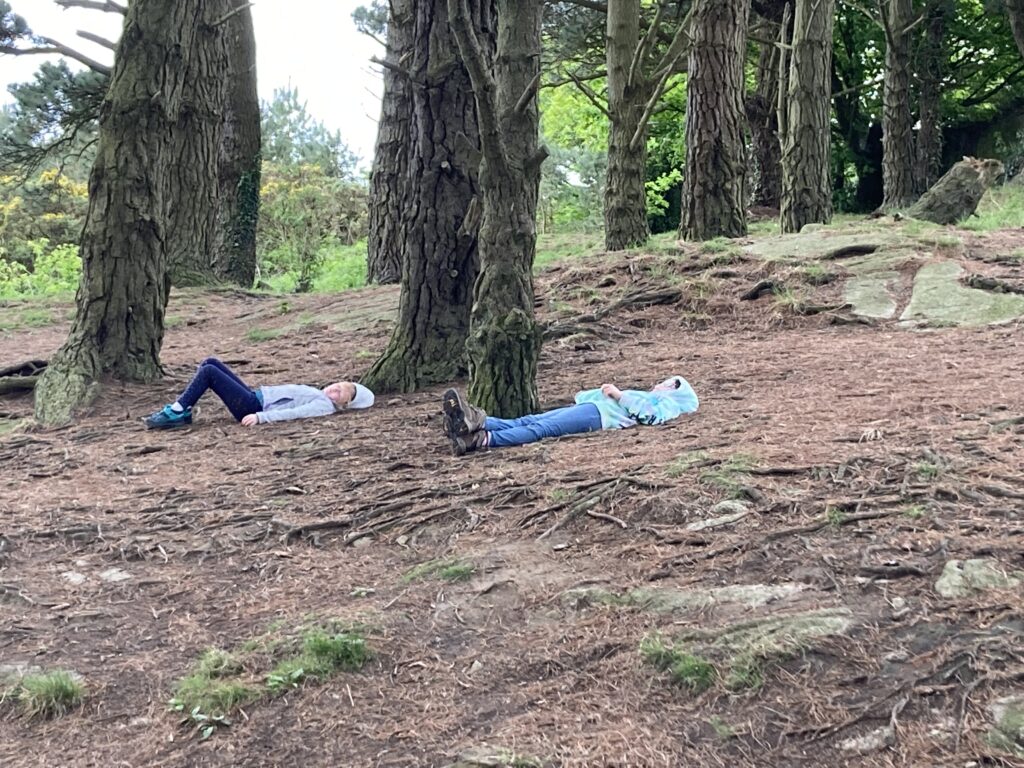
The closing circle is an important part of forest school where we share what we noticed during sit spot and what we were grateful for from today’s forest school. Everyone in the circle has the opportunity to speak out about their feelings and findings. By doing this each session, the children get used to reflecting upon their experiences, thinking about what attracted them, what gave them joy, and sharing these thoughts with the group.
Forest School is not only a place where the children have a fun time in nature and learn about plants and animals, but they also learn so many life lessons – what it means to be alive, how trees, plants and animals strive to live and why all living things including us die and how we can contribute to other lives. They also learn how to reflect on their feelings and what it means to share our time, space and feelings with others, and many other things besides. These, I think, are important lessons that we as adults can share with our children.
It was a sunny day with a bit of a chilly wind for the third forest school session for 3rd class. We gathered at the meeting point, and the children enjoyed rolling down the hill while waiting for everyone to gather. We started the session by looking for things which had changed from the previous week.
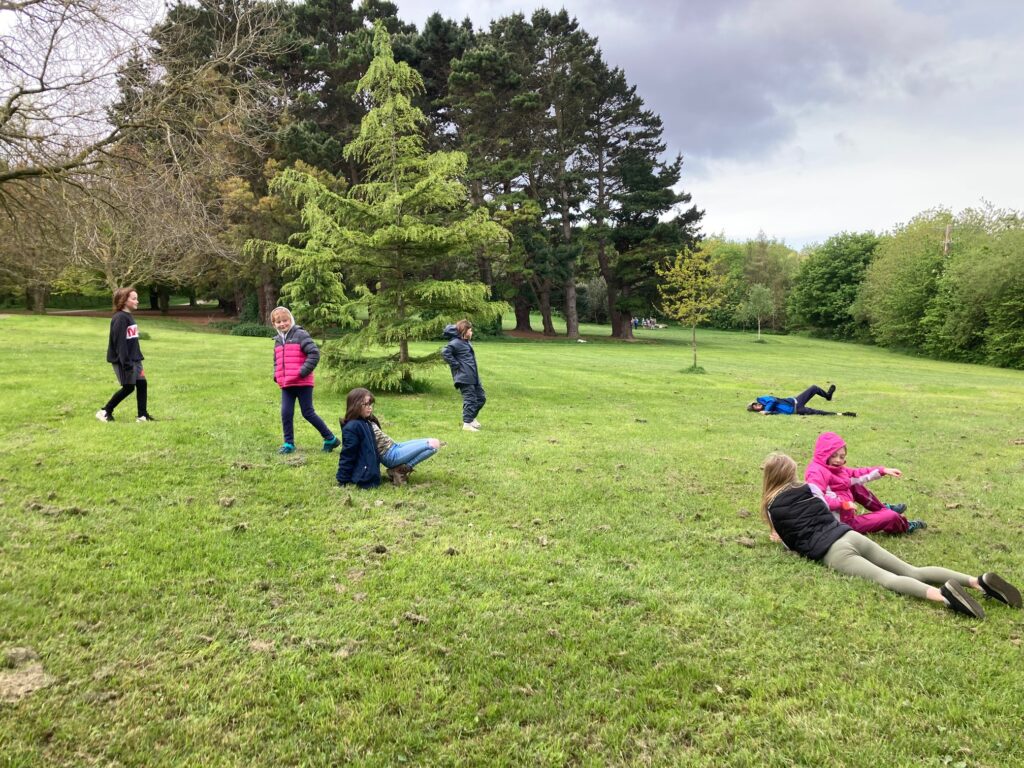
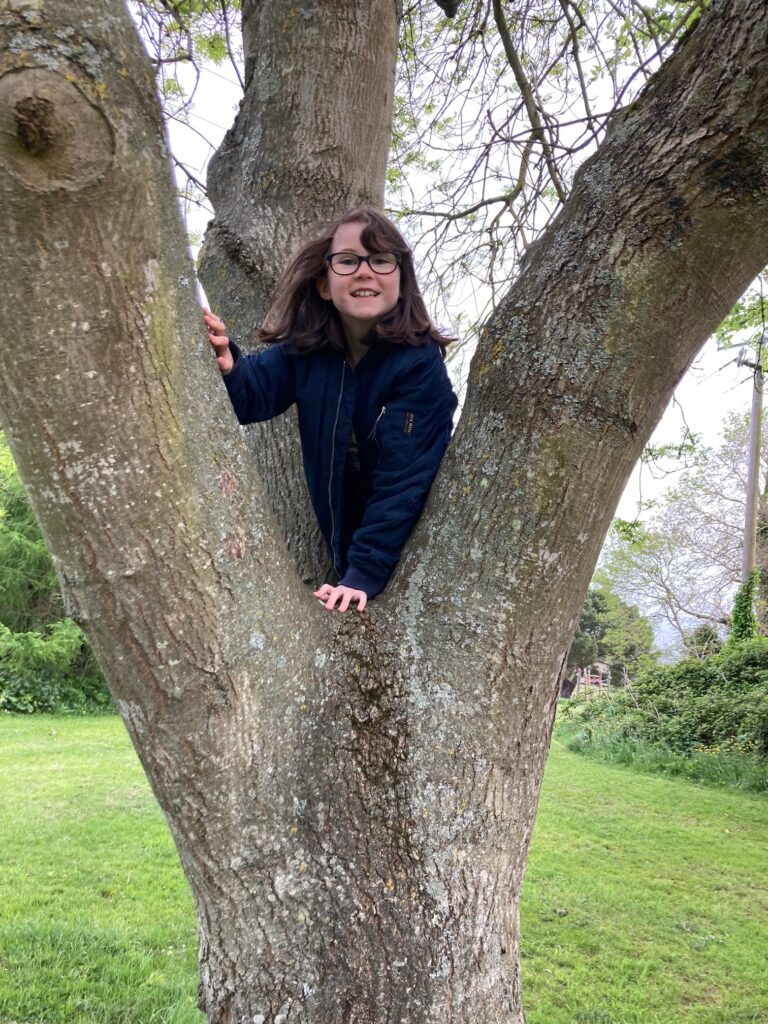
The ash tree at the meeting point had a lot more leaves. A child noticed that the ash keys looked brown and dead. Then we went to see an Elder tree, and noticed that the flowers were almost in bloom. The teacher encouraged the children to touch the buds, and let them guess when they were going to bloom. A child said, “I remember building a den under this elder tree!” so she tried to get inside the bush, but soon said, “I can’t get in, I am too tall!” When we went around to see the tree from the other side, they noticed that the tree was quite old.
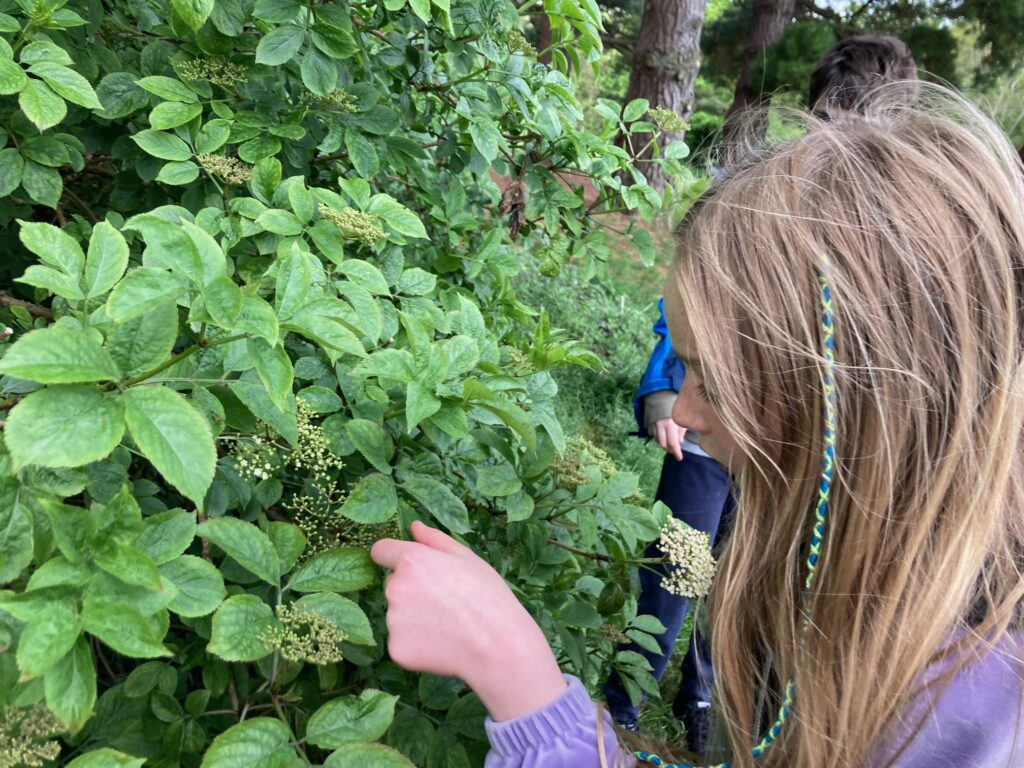
Everyone then came up with names for the tree such as “old nugget”, “elderly tree” and “red spider tree (because some parts of the branch were red)”. Then they found that there were a young oak tree and a young holly tree growing under the elder tree, so that they changed the name to “kindly helping tree”, “oak and holly sitter”, and “elderly sitter tree”. Giving a name to a particular tree helps children to look at it carefully, and provides them with an attachment to the tree. They will recognise the tree when they come back and be able to notice changes through the years.
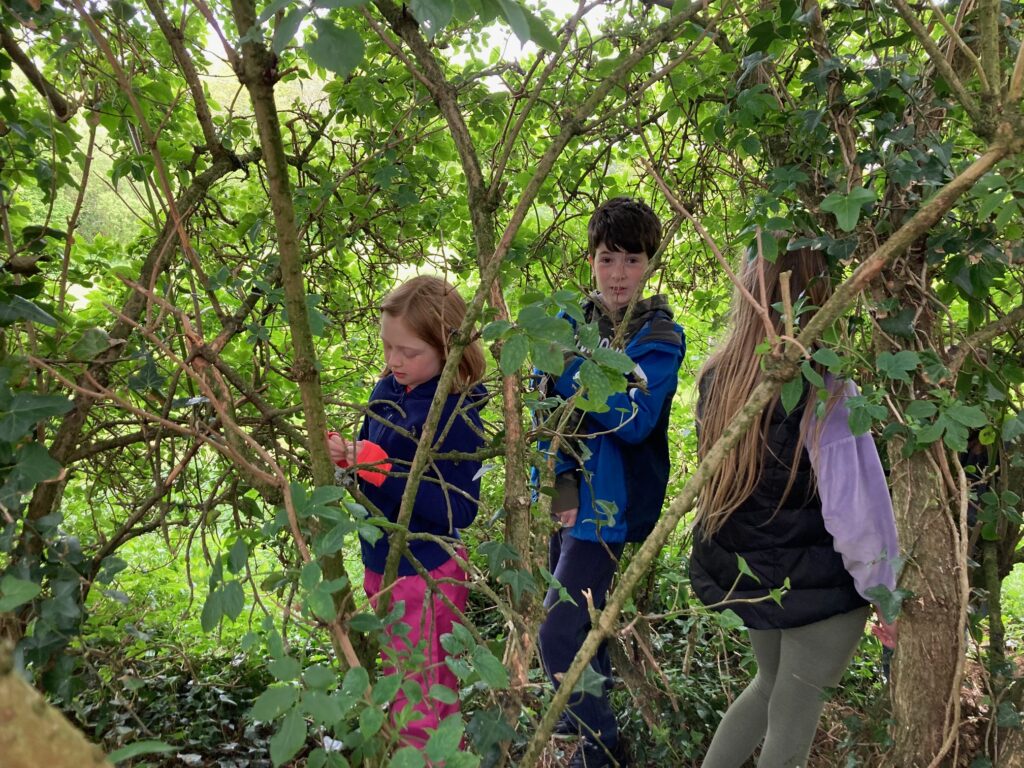
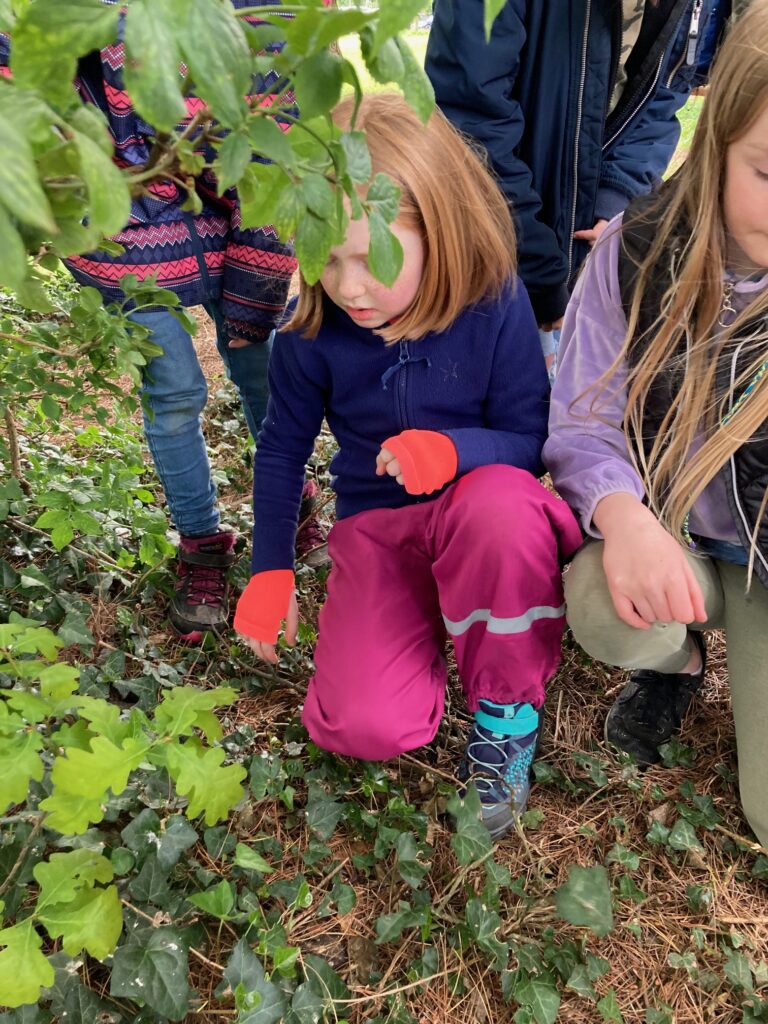
The leaves of horse chestnuts were almost at full size, and their flowers were in full bloom. The children enjoyed its sweet scent. The teacher told them it is called “cnó capaill (horse nut)” in Irish. Another child noticed the next tree, which has oval, pointy leaves, and it was so soft. The tree was hazel, but the children could not find the nuts yet. The children kept finding different trees and plants, smelt the flowers, tasted the leaves with the teacher’s allowance, and shared their experiences.
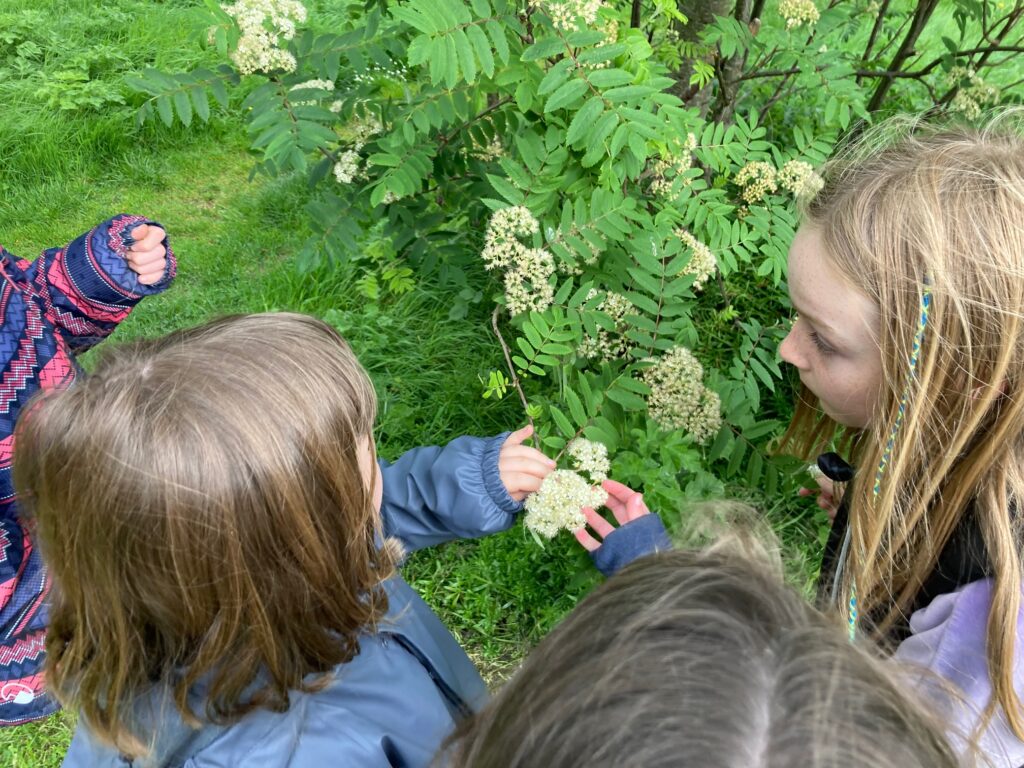
For example, they found willow and wanted to do weaving, so the teacher said that she would bring some from home. They found wild garlic that was in bloom. They picked 1-2 flowers and tasted the flowers, and found the garlic flavour to be quite strong.
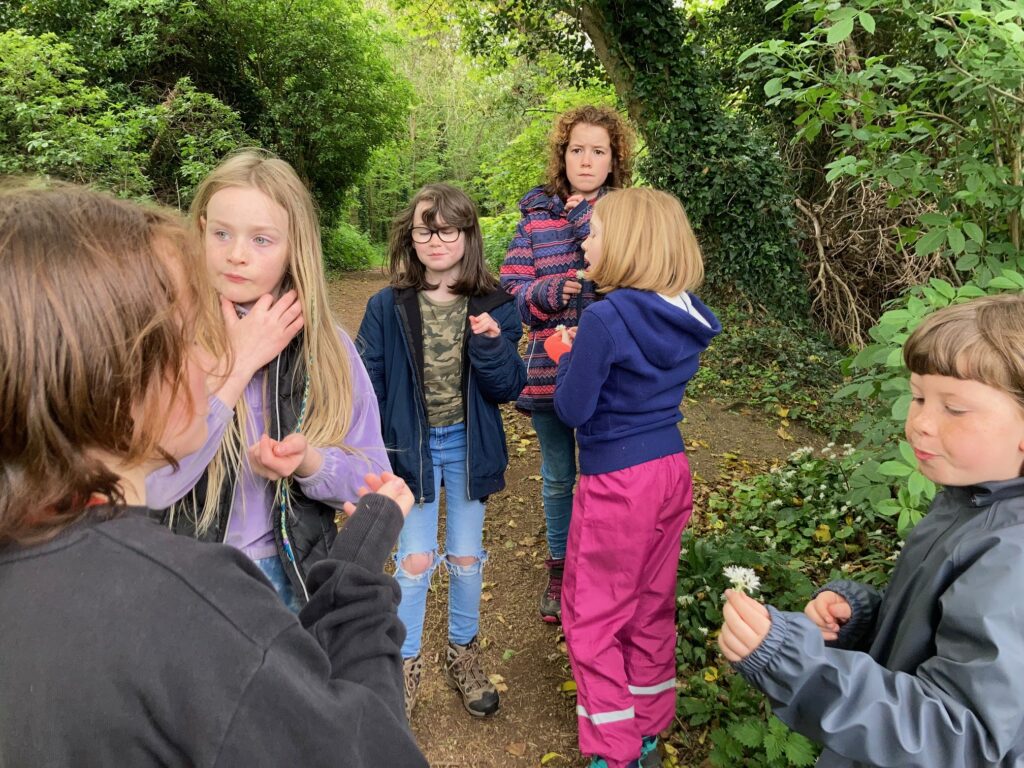
The teacher spotted “witch’s broom” growing on a birch tree, which is likely caused by a fungus.
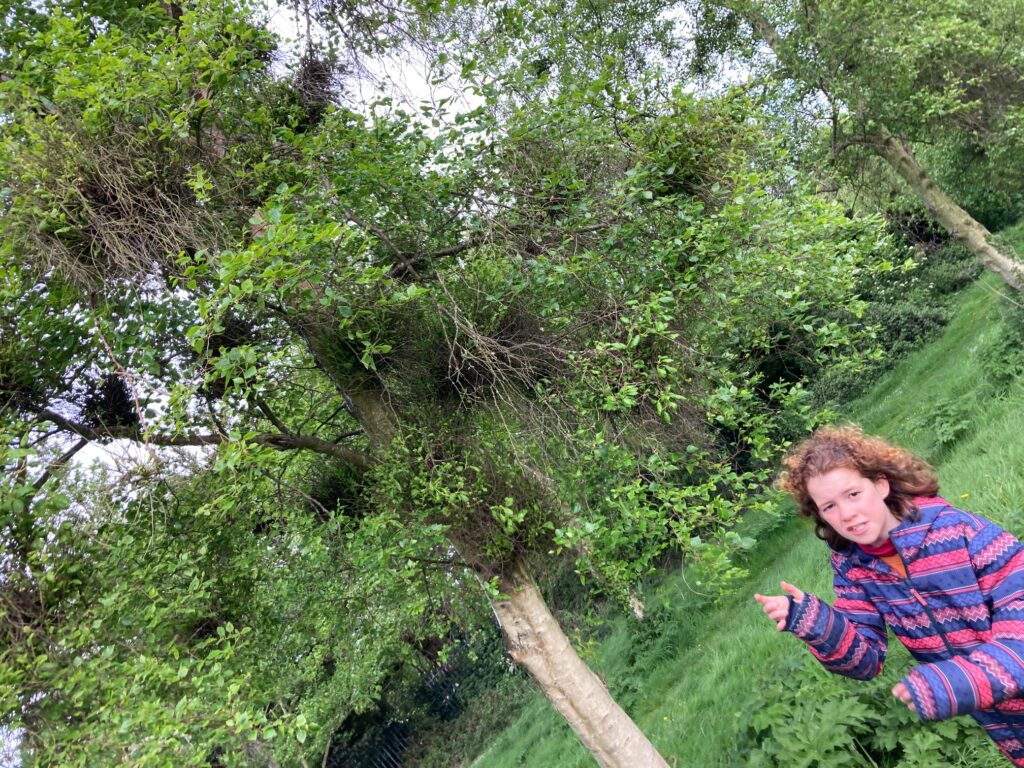
They also noticed samaras on an Elm tree, which emerge before the leaves, giving the branches a frilly appearance. The samara consists of a seed surrounded by a papery, round covering about 1cm in diameter, and it is quite tasty to eat.
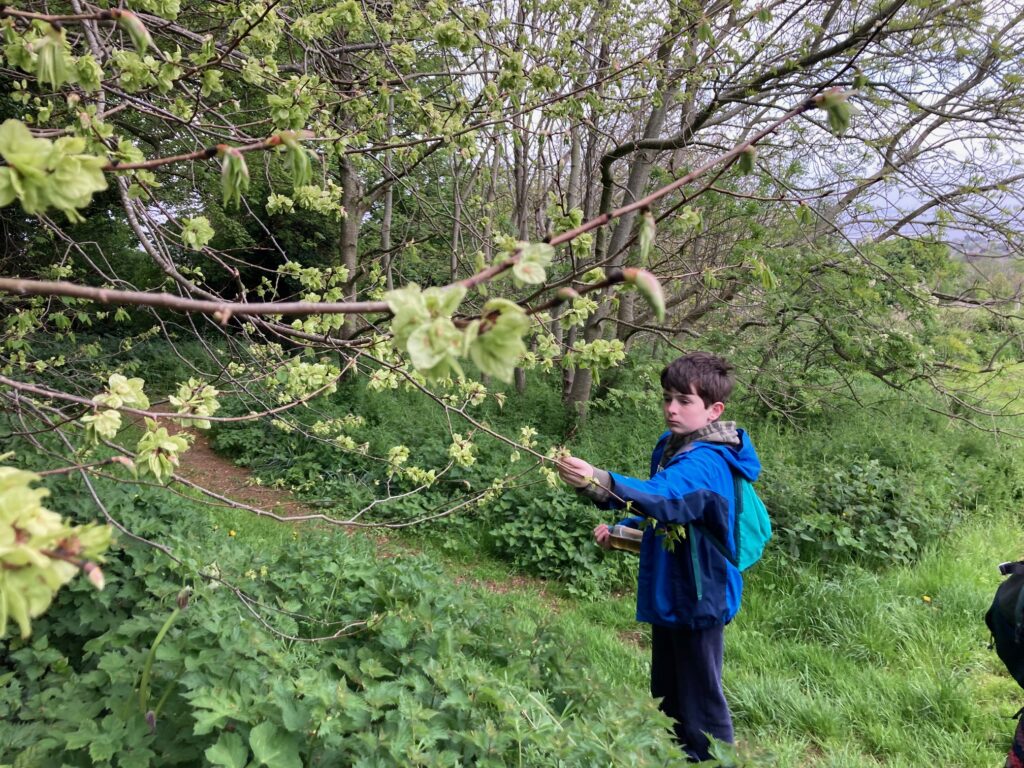
A relatively small number (10 children, 2 adults) and a few very enthusiastic and knowledgeable children made the group so open to learn so many things. When they found tree species they already knew about, or something interesting or they had never seen, they wanted to share them with their group and the teacher, and the teacher was happy to have the opportunity to share her knowledge.
After the exploration, we went to an open field next where there were many dandelions, buttercup and daisies. The teacher had black ink and paper and the children enjoyed making marks and patterns using different flowers. They noticed different shapes, patterns and textures in the petals, and different effects they could make when printed on paper.
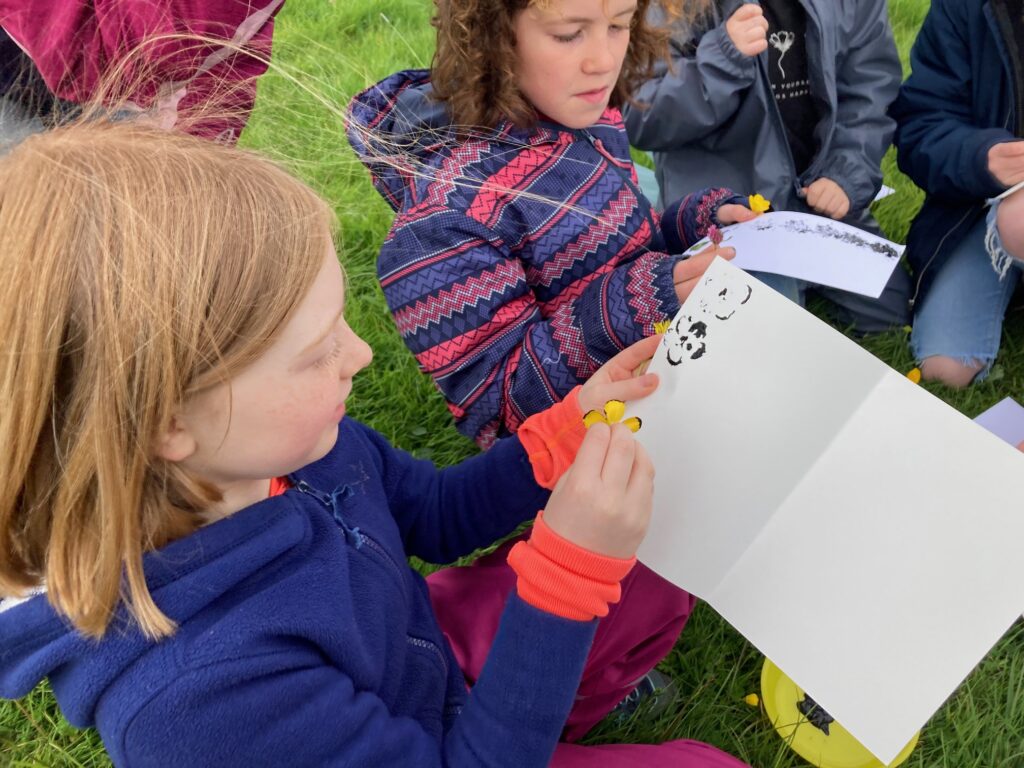
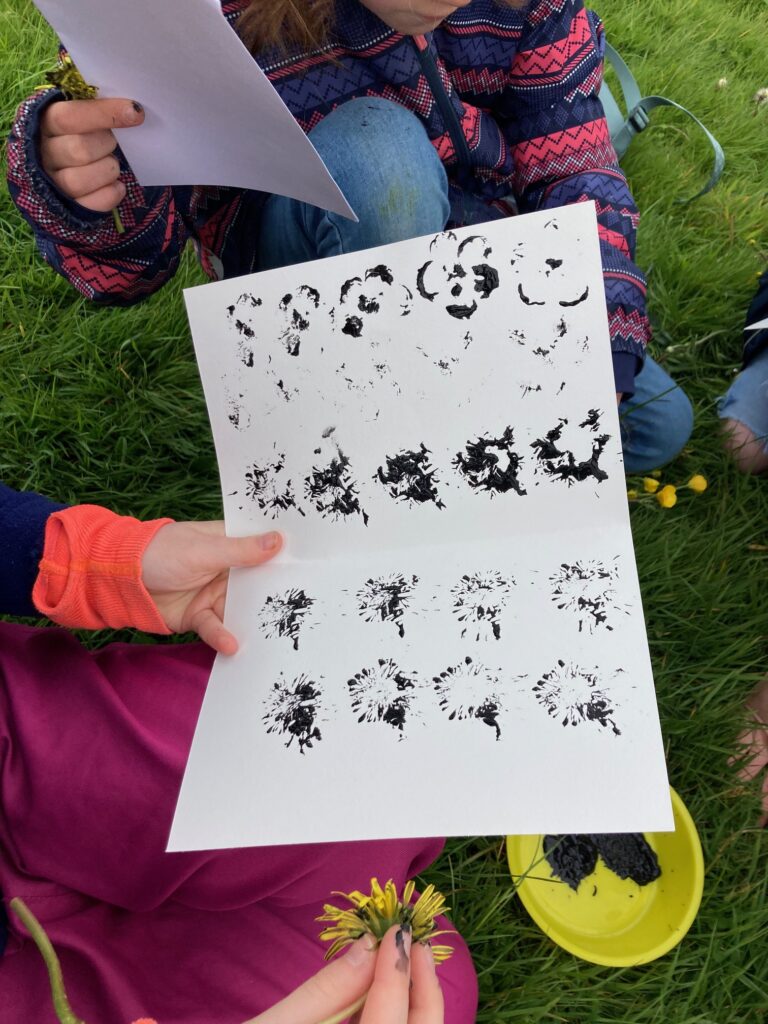
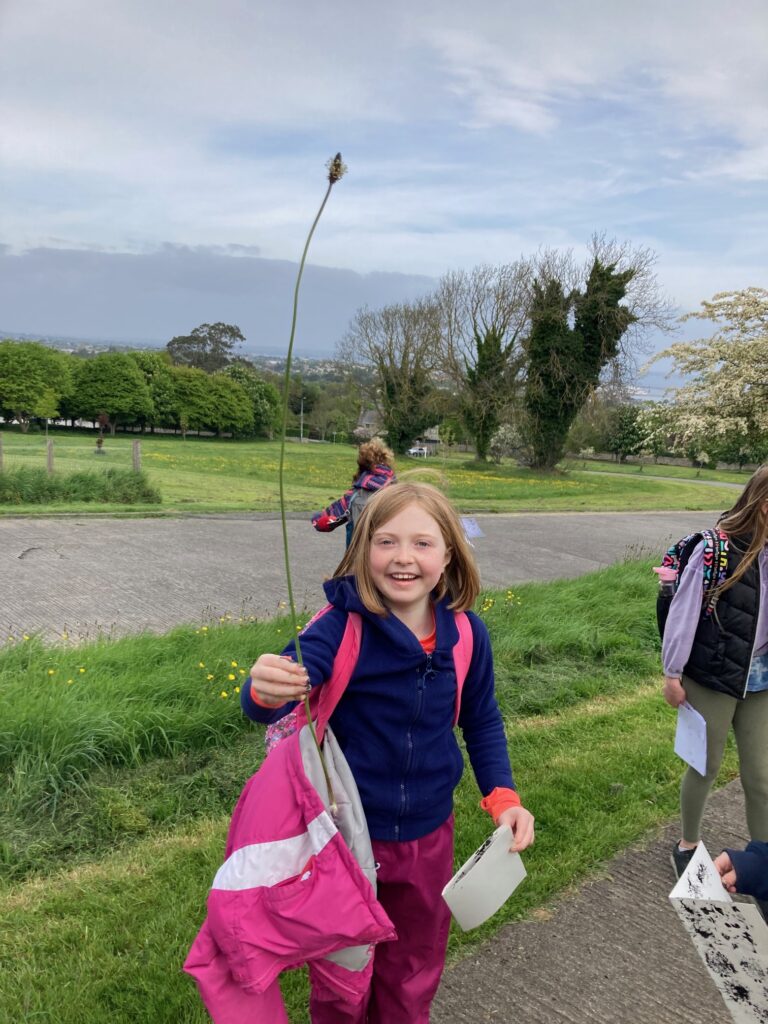
When we finally arrived at the basecamp, we had lunch while the teacher told a buttercup story. The teacher also explained that the buttercup is not edible for humans. During free play, some children enjoyed playing in a den, which they called “Green Leaf Cottage”. They served real edible plants (gorse petals), in a leaf plate with chopsticks which were made of sticks that peeled the skin off for a Japanese customer (me!). A child made a sign for the cottage by making marks on dead bark with a stick.
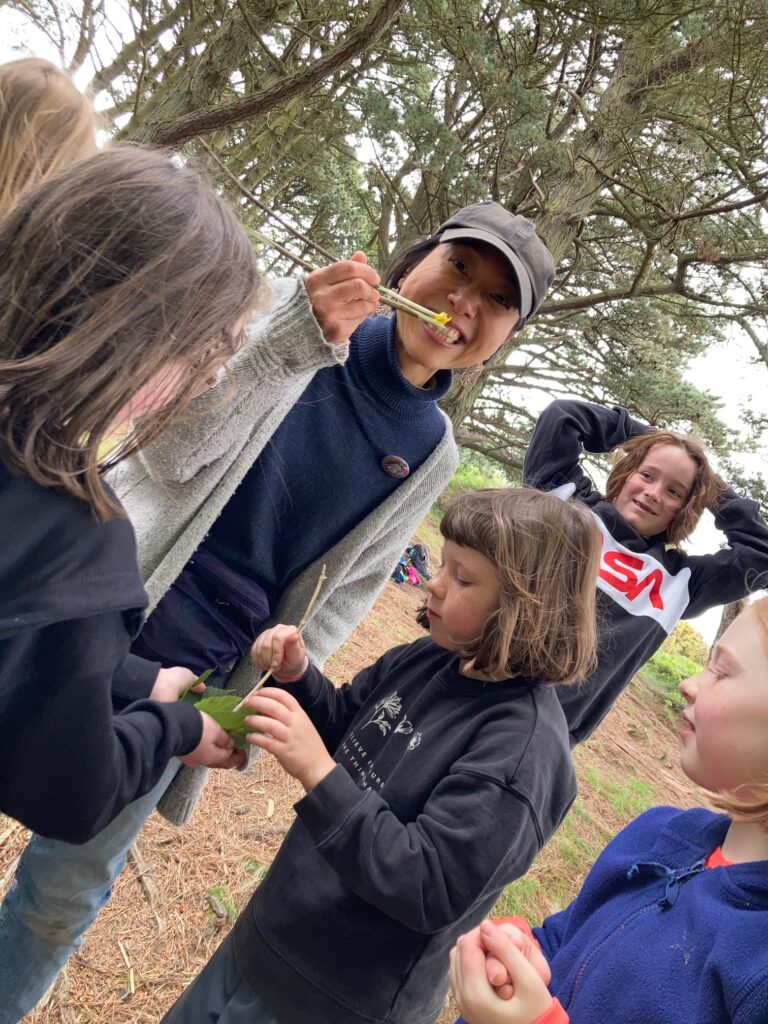
Other children were on ground troll investigations again, and one child was enjoying making different sounds using sticks. Another group of children found some charcoal, and they used it to make some natural face paint by mixing it with water. After that we played the birds’ game, followed by sit spot and shared our findings and what we were grateful for in the end.
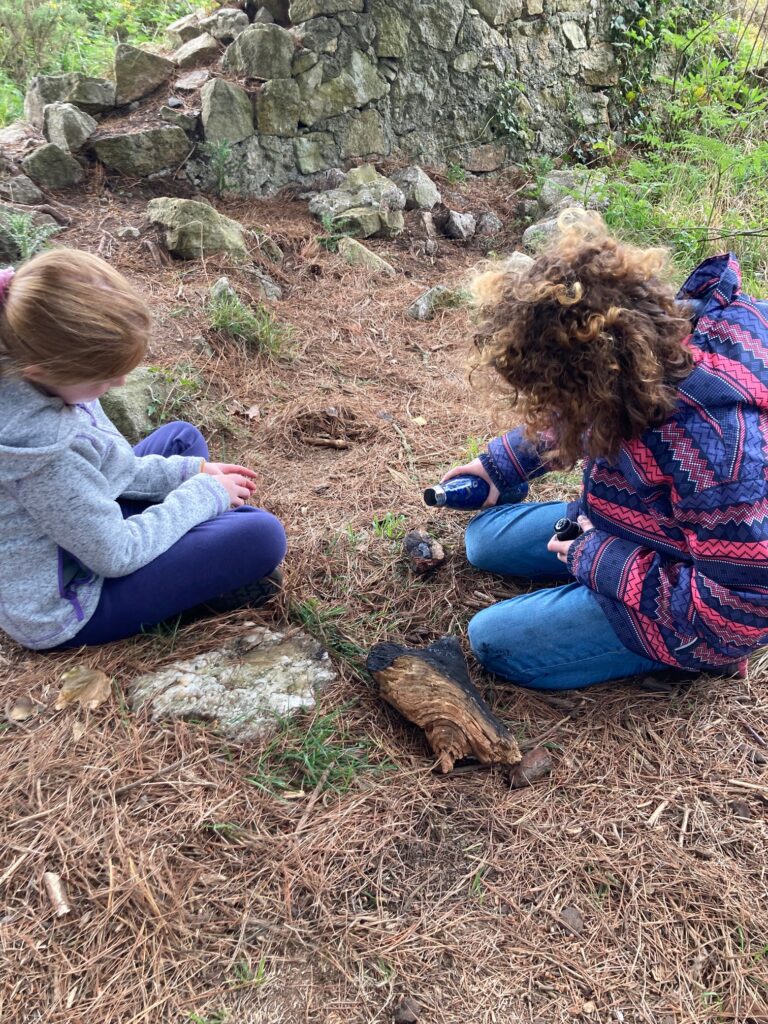
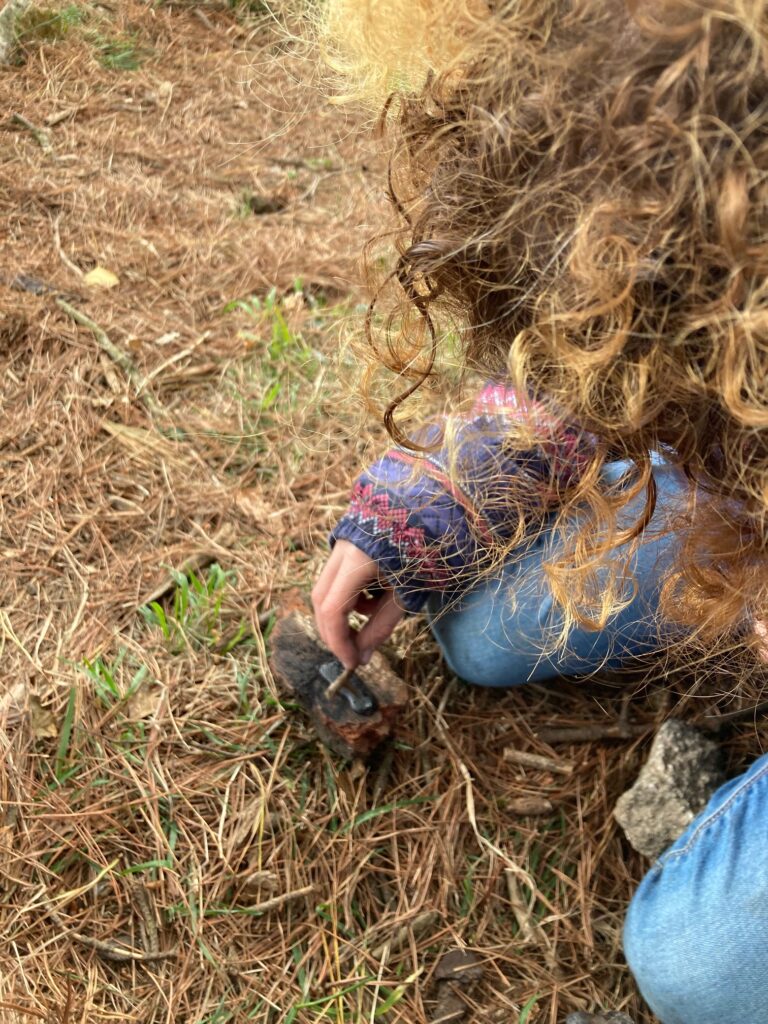
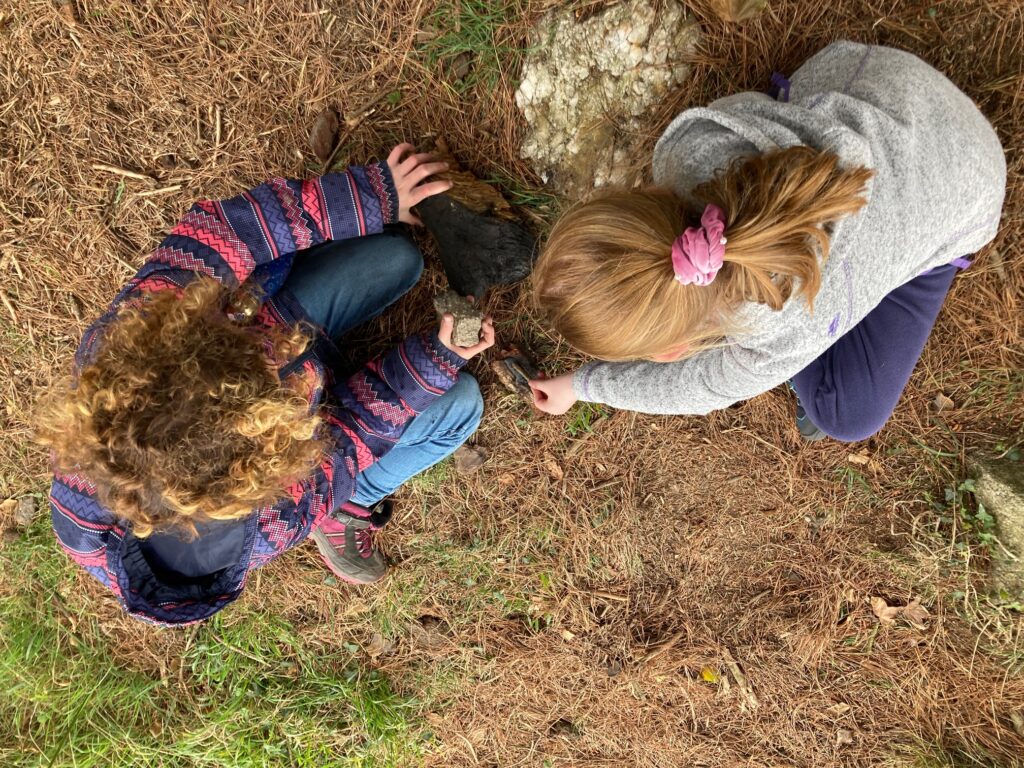
During this session, the teacher noticed that some living trees had been cut and used for building a den by somebody before we came here. She gathered the children and shared her reaction to this. The teacher pointed out that the tree seemed to have been cut very recently, which could be deduced by looking at the leaves. Also the cut was quite jagged, which would make the tree susceptible to infections. It is very important for the children to know that they should never damage the nature found in the site. The children should be able to teach others too if they see somebody is damaging the environment.
Children constantly learn from the attitude of the adults around them, their reactions and how they respond to certain situations. So if adults don’t appear impressed by the beauty of nature, show awe and respect for nature, cherish other creatures, smell and touch them, it is very difficult for them to develop such feelings, especially when they are young. Forest School is meaningful in this sense as well, by providing the children opportunities to spend time with adults who are passionate about nature, are knowledgeable and have faith in what they are doing.
Session 4 – 20 May 2022
It was a grey day for 3rd class’s fourth session. We started with the “Cuckoo bee game”, where a cuckoo bee, that is trying to steal the hive, needs to find who is leading the movement of the group.
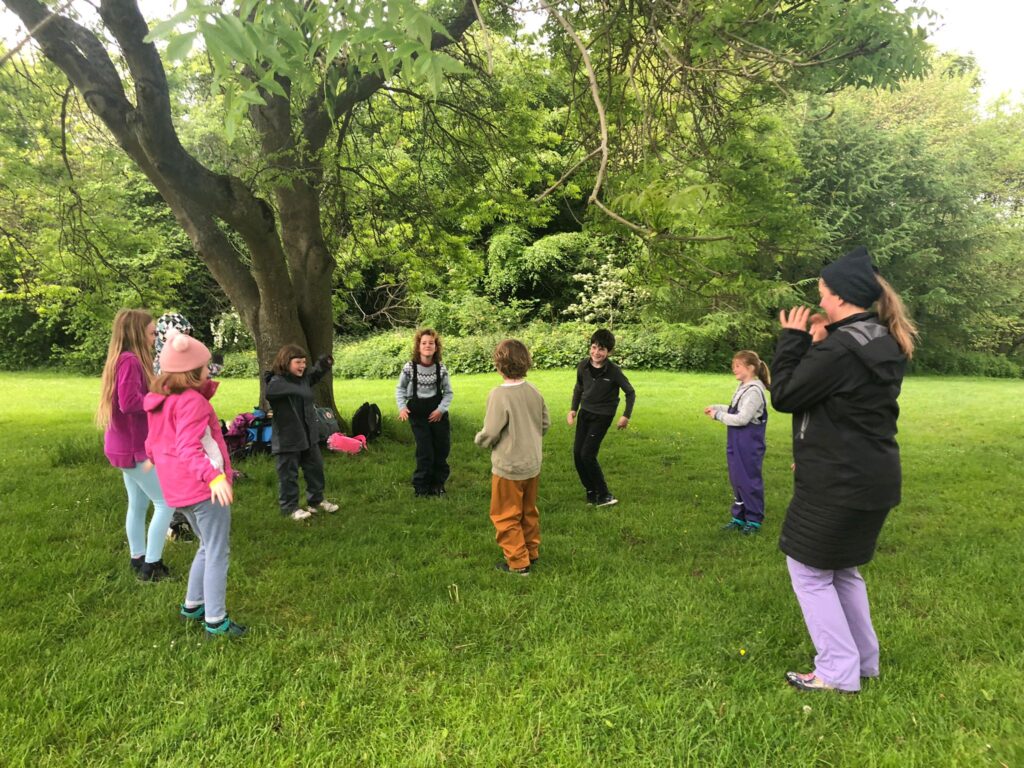
After having a great laugh playing that game, we moved on to take a look at the same trees we had observed in previous weeks, and take note of the differences. There were so many changes in the wood within just a single week. The children noticed that the ash tree had a lot more leaves and there were some ash keys forming too.
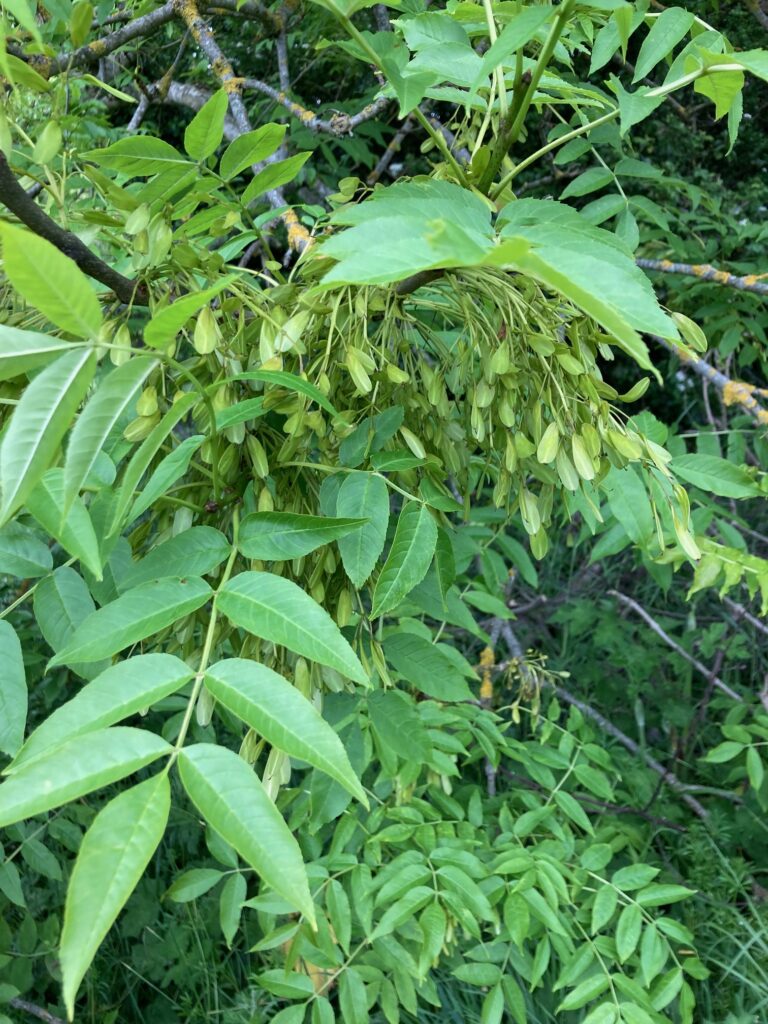
The “elder sitter tree” (an elder tree which has a baby oak and a baby holly tree growing underneath) had more flowers blooming, and the leaves of the little oak tree were bigger than they had been the previous week. The baby holly tree had new leaves coming out, which were light green and so soft to touch. The horse chestnut trees were also forming nuts. The children touched the nuts and found that they were soft.
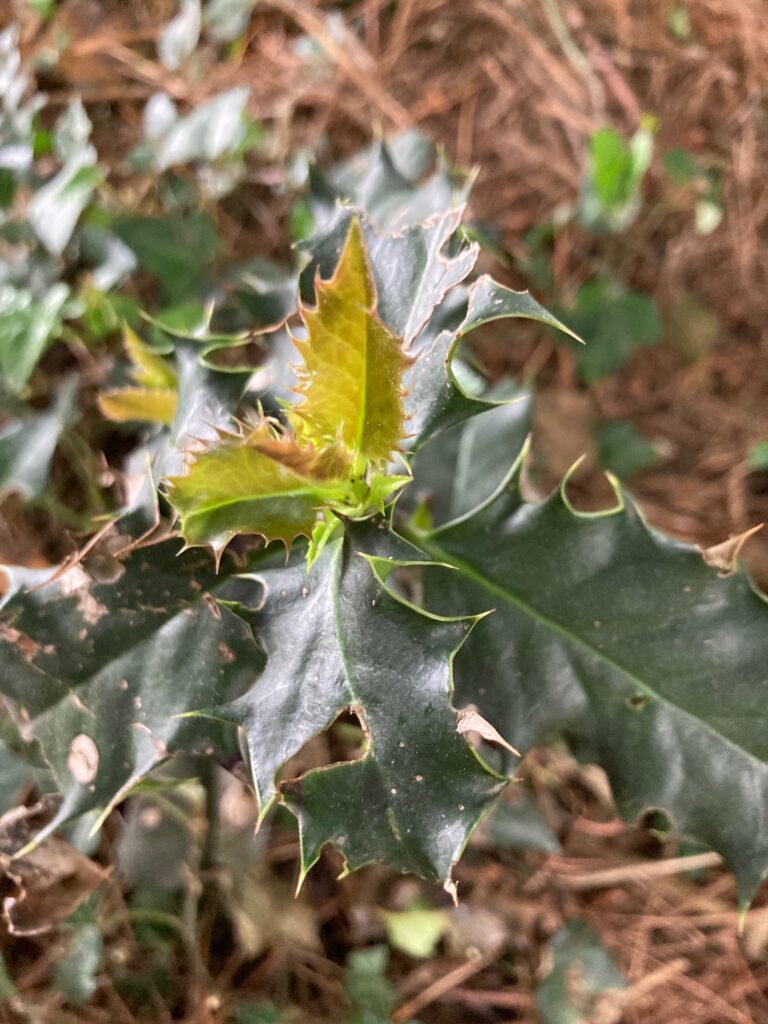
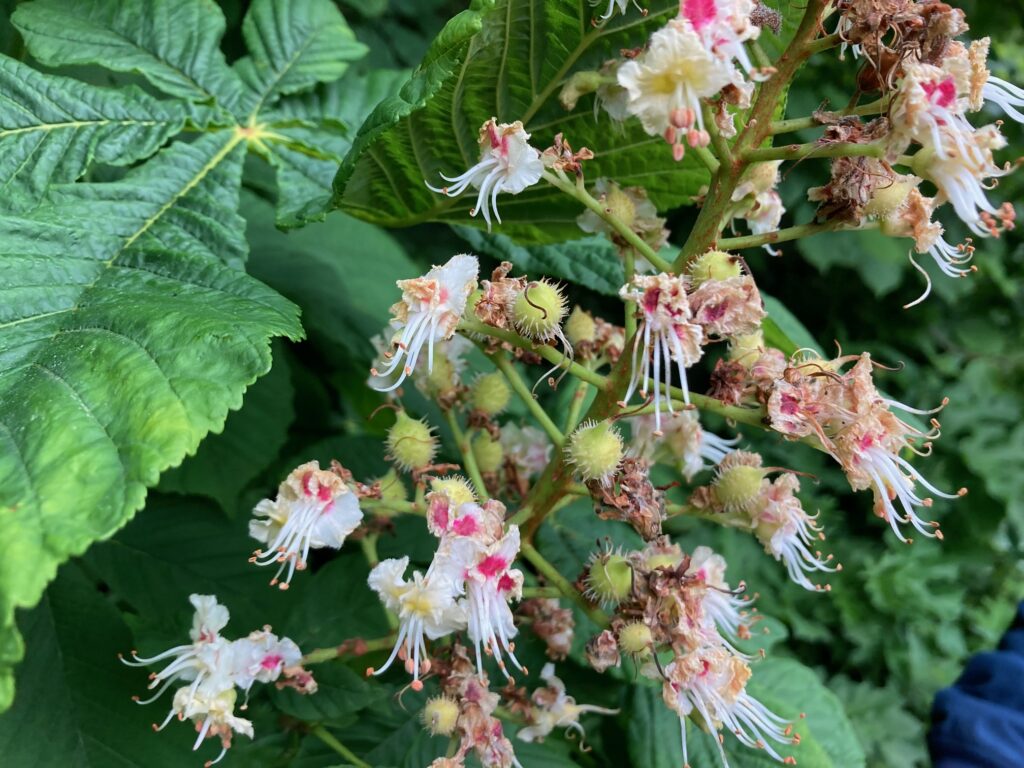
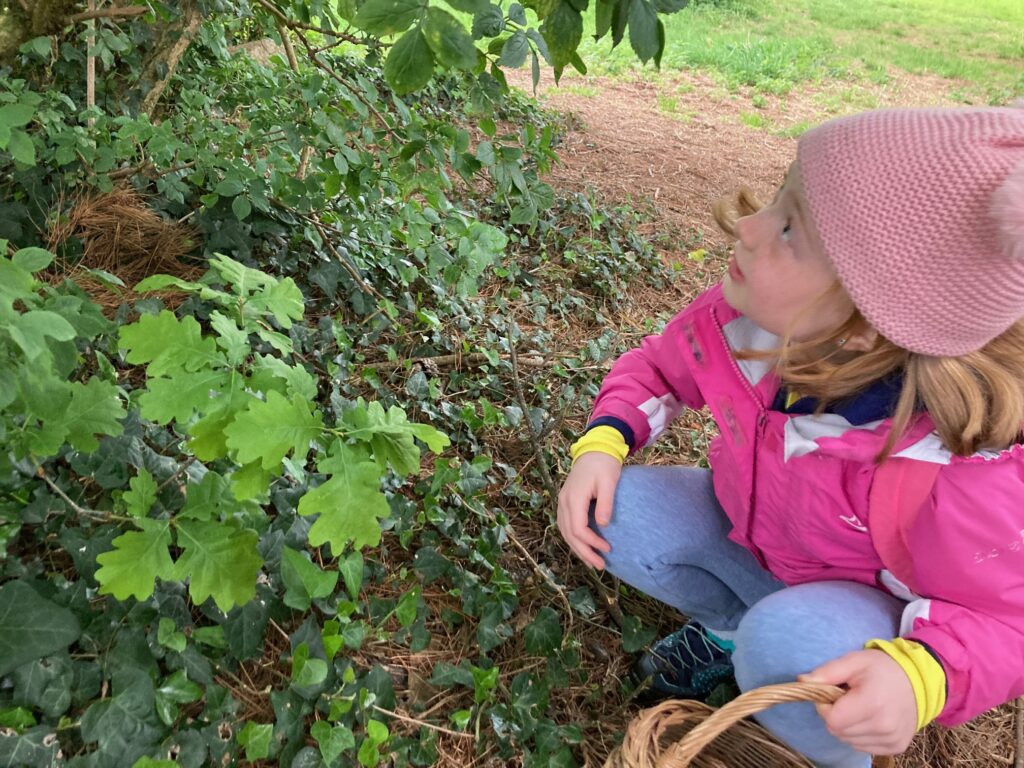
The white and small flowers of the hawthorn tree were still in bloom. The teacher reminded them that the flowers and the leaves of the hawthorn are edible, so that we picked some for our nature tea. One of the children smelled it, and said, “Oh this is so fruity.” The stems of the ribwort plantains had grown very long, and the children compared the length of their stems and their heights. One of the children accidentally picked the plant from its roots, and the teacher said to him, “It is better not to take it from the roots. Put the roots back and it might grow again.” and he did so.
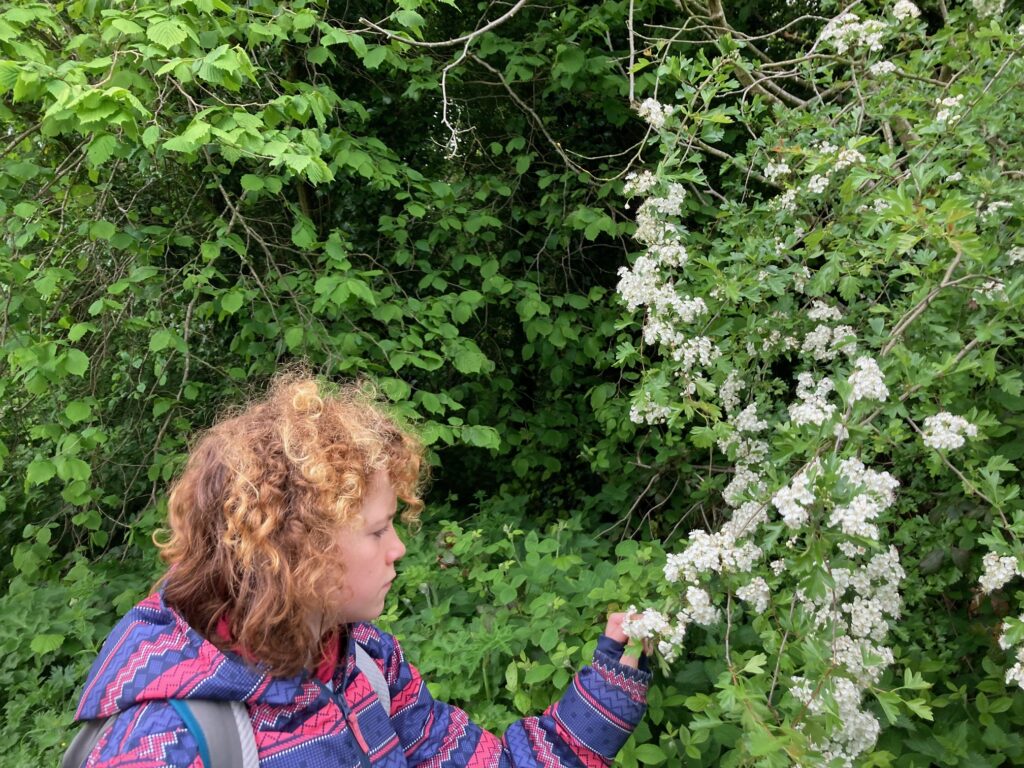
The needles of the larch tree were a bit darker and bigger than in the previous week, and we found that the taste was bit stronger too. It was the same for the beech trees. The children were learning the seasonal changes in trees and plants using all of their senses, and in this way, the natural cycle is becoming part of their lives.
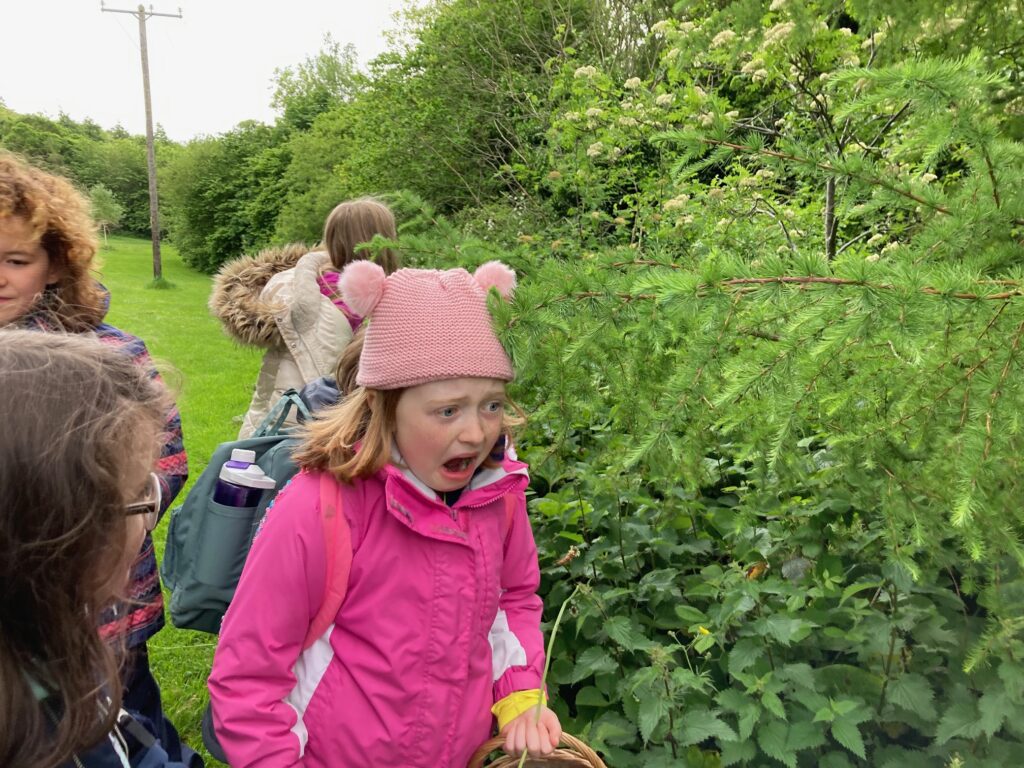
The teacher found a new plant, which appeared more dominant this week. She said, “Do you want to taste a new plant?” and the children said excitedly, “Yes!” It was vetch, a member of the pea family, and is edible. The children tasted the flower petals, and exchanged opinions. “It tastes more bitter than peas, and I don’t like it.” “I don’t like peas, but I like this!”
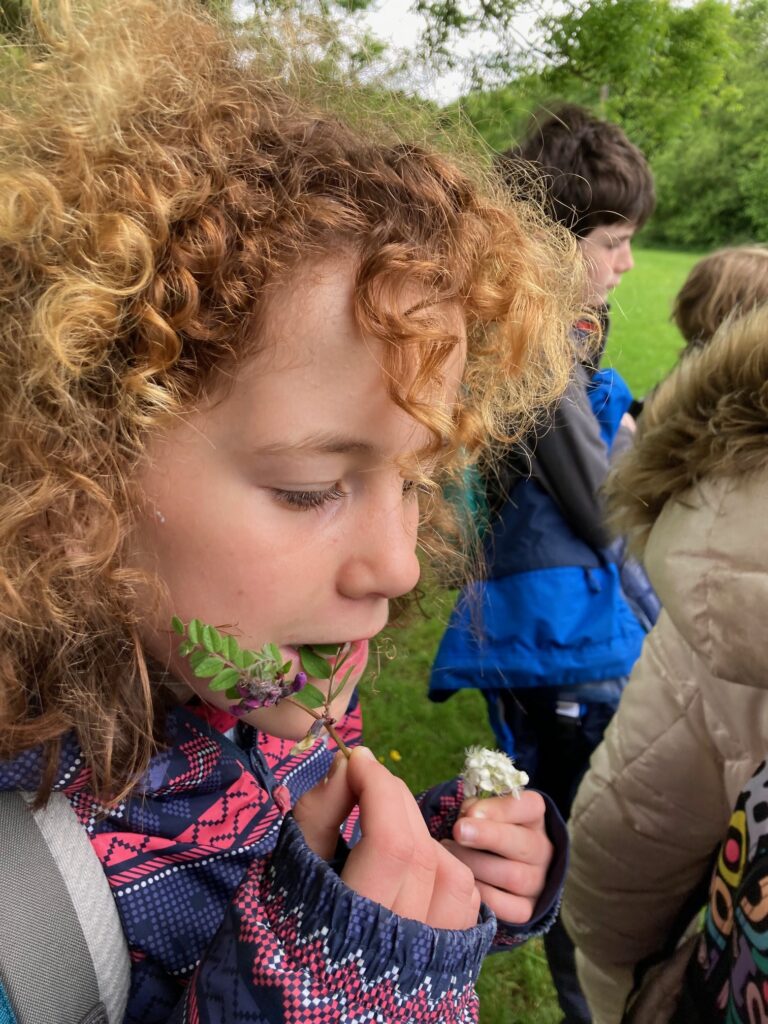
Then we went to the cherry tree, and the children found that it was forming cherries. It was still green and small. One of the children asked “Can I eat it?” and the teacher answered, “The plants usually protect themselves by not being edible before they are ripe, so it’s not a good idea to eat them at this stage.”
It took a long time to get to the basecamp, as there were so many things to observe and appreciate on the way. When we arrived at the basecamp, it was time for free play. This week, the competition of a café and a new restaurant were emerged. A group of children created a café in the previous weeks, but another group of children decided to make a new restaurant in a different setting. They named it “the grey wolf restaurant”, and everyone in the group found a role, such as collecting edible plants, constructing a wall, chopping edible plants, or serving food. Their menu was “wild garlic and gorse spaghetti!” The leaves of wild garlic were chopped to make pasta. The other group booked the restaurant, and eventually they came and tasted their food.
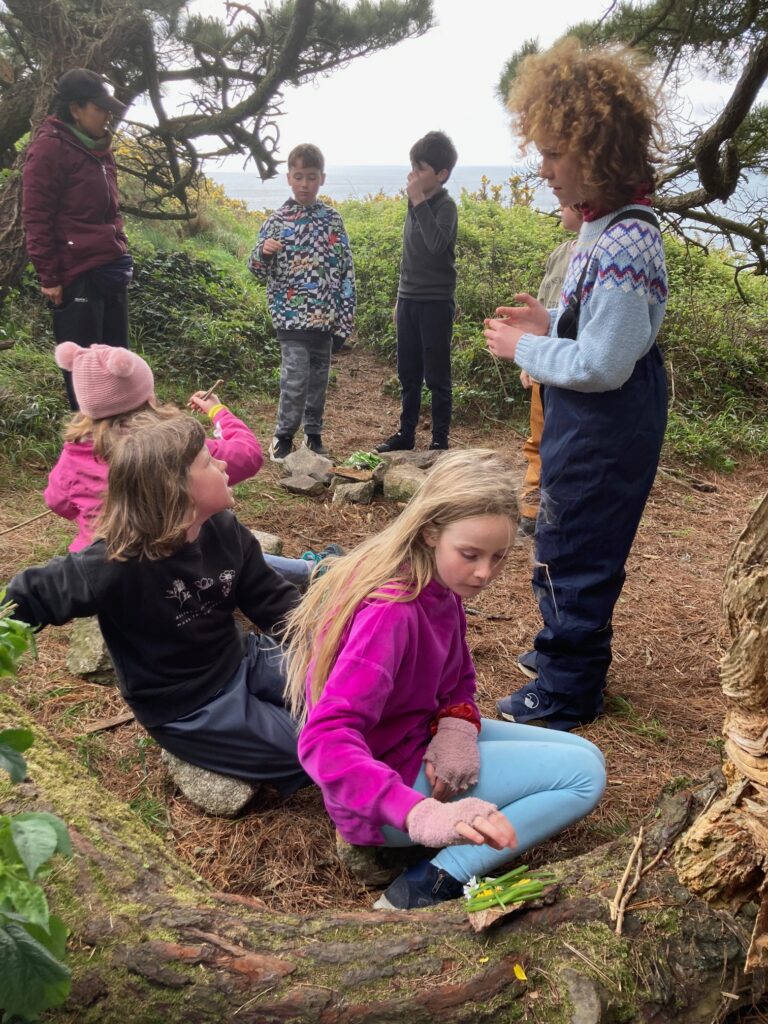
There was a magic in the imaginary play in the woods, because the resources are so rich and limitless in nature. Stones become tables and chairs, logs become a counter and walls, the leaves become money and decorations, sticks become knives, spoons and chopsticks, dead bark becomes a sign board, etc. There is no right and wrong in forest school, and what the children have is the freedom of innovation, creation, imagination and collaboration.
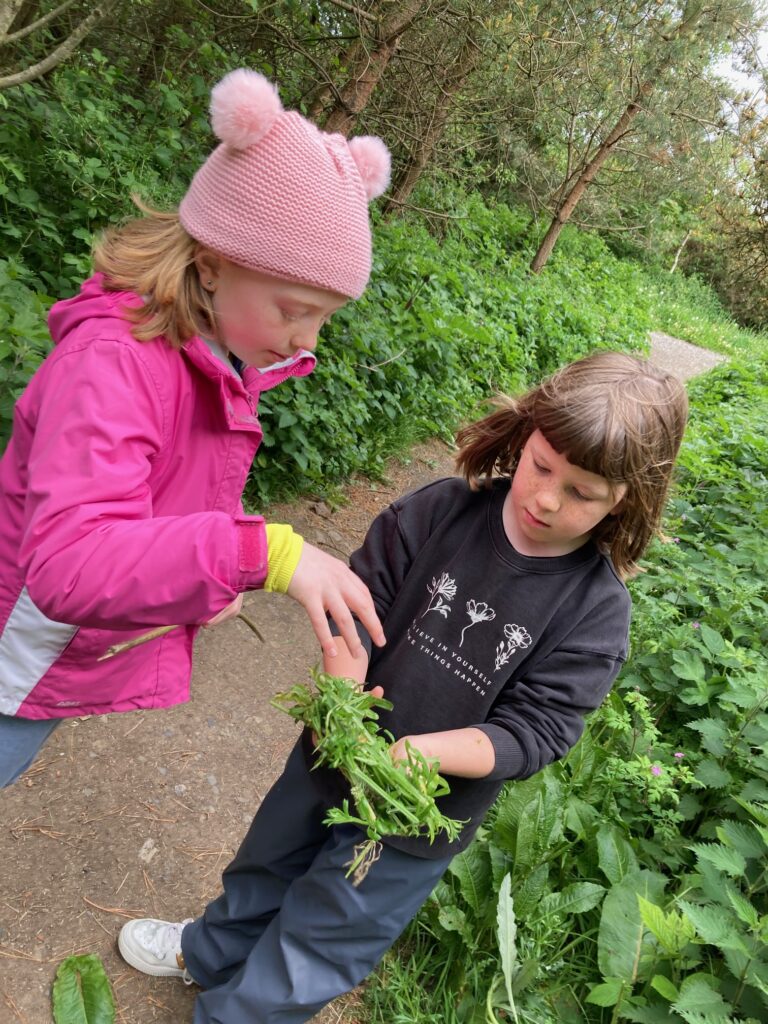
The most fun part was that they were playing together. Imaginary play seemed to give them a feeling of connection with their peers, which is important for their sense of security. They cooperate, watch what others are doing and react accordingly. Everyone was part of the play, in his or her own way.
Because everyone was so engrossed in this activity, the teacher let them decide whether they wanted to continue playing in the restaurant or doing the activity which the teacher had originally prepared for that day. The children wanted to continue playing with restaurant, so the teacher let them have more free play. This is because the role of leaders in forest school is to observe, reflect, assess and plan accordingly and to cater for individual children.
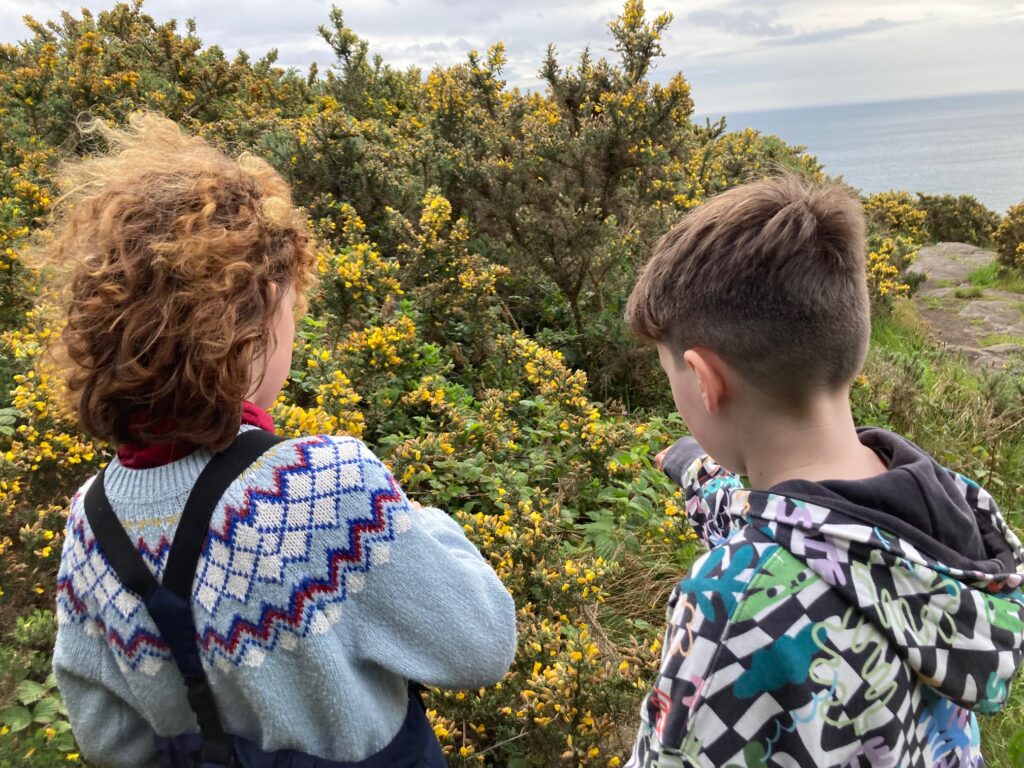
The smaller groups allow the leaders to facilitate more child led learning where they get to choose what they are interested in both individually and as a group. Where possible forest school leaders say “yes” and help them to develop their curiosity and love of learning. Though there is a lot of thought put into plans, it is pleasing if the session takes a different direction because the woods inspired something in the children.
Session 5 – 27 May 2022
It was a lovely summery day for the fifth session. While waiting for everyone, one of the children noticed that the some of the cherries were getting red, and another child discovered that she could stick an ash key to her face.
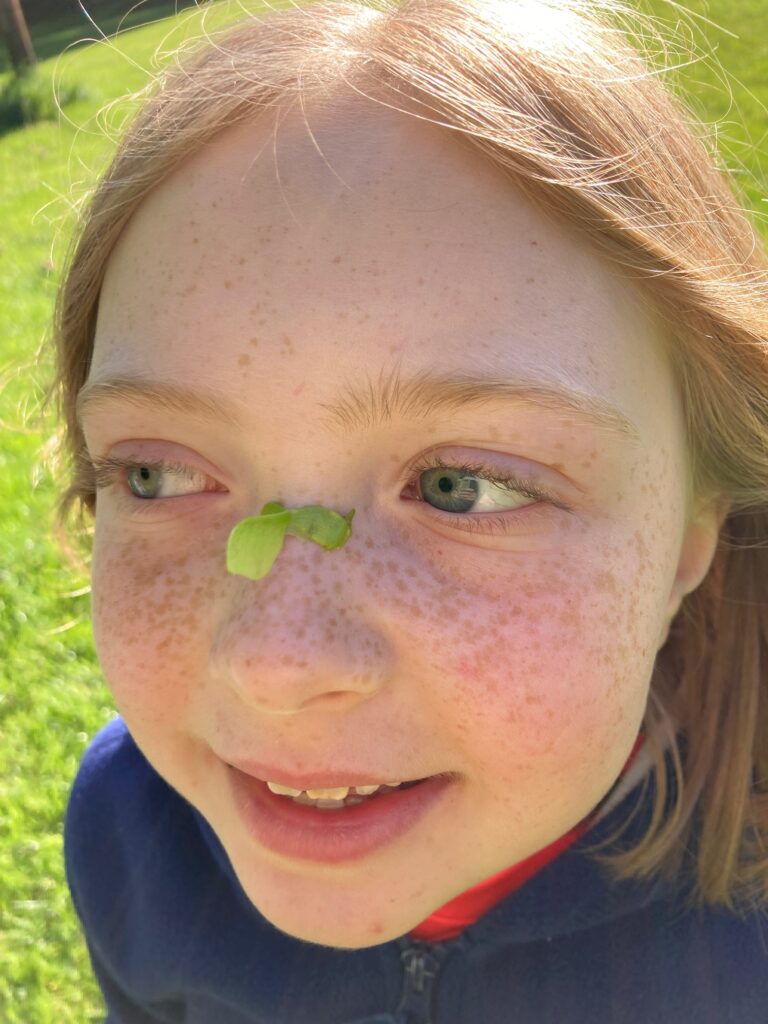
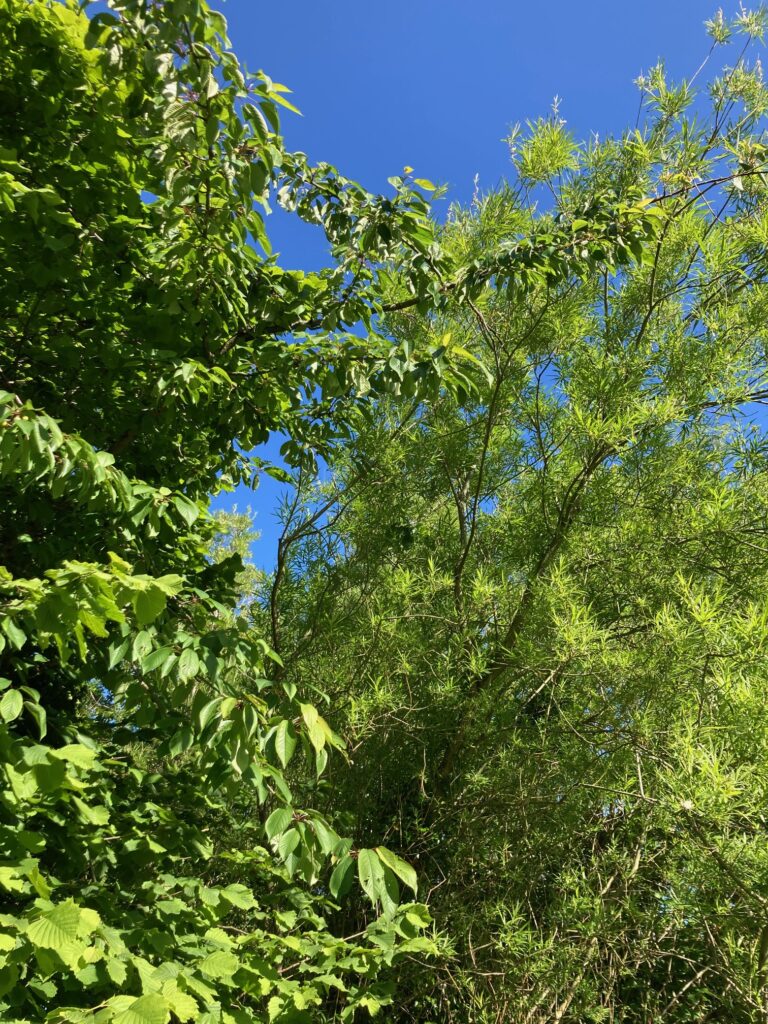

In the opening circle, many children wanted to share their news over the last week. One of the children shared that his parents had told him that the three-cornered leek originally came from England. Another child said that she had elder flower tea at home over the weekend. It is great to hear that the children bring forest school home, and share their discoveries and knowledge with their parents. We feel that forest school brings with it a sense of community.
After the opening circle, we checked the “Elder sitter tree”, and picked a flower which had the nicest smell to put it into today’s nature tea. The baby oak tree was getting even bigger under the baby-sitter tree. The teacher told them that oak is “Dair” in Irish, and that there are many place names in Ireland that incorporate “Dair”. The children came up with some place names such as “Kildare” and “Derry”. Through learning the language, children get the opportunity to realise how Irish culture used to be deeply connected with nature.
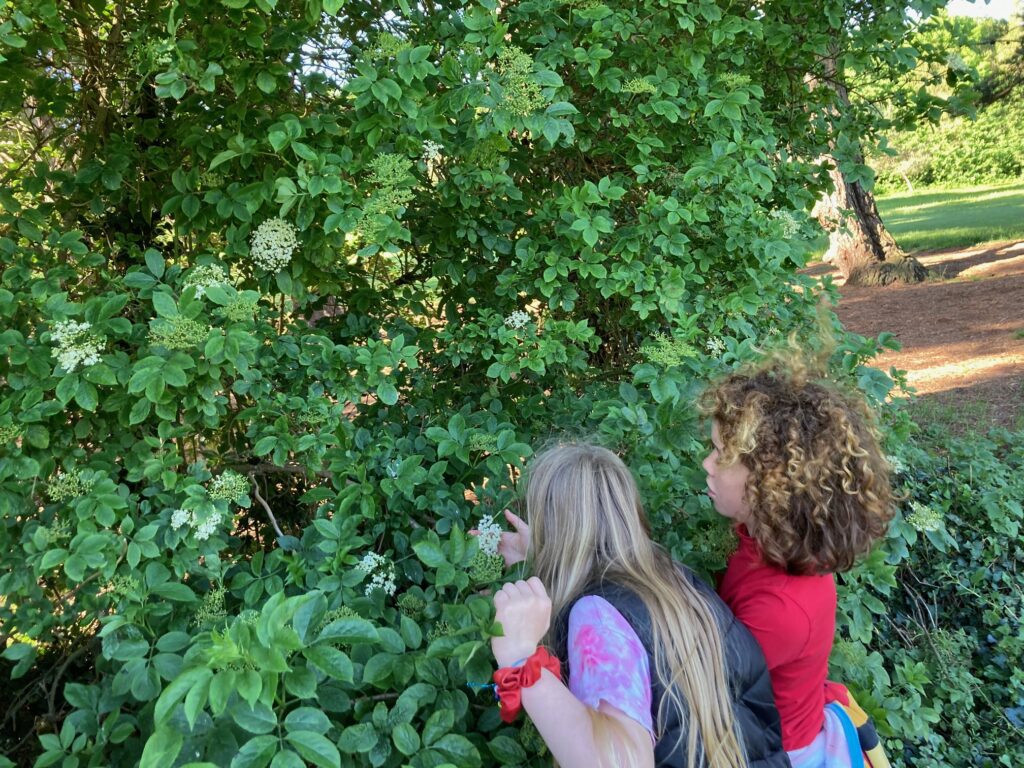
On the way up to the basecamp, one of the children shared her finding that the pattern of fern leaves is repetitive from a small scale to a coarser scale, which the teacher said was called a “fractal” in the natural world. The observations of children sometimes surprise adults. As they become accustomed to sharing their findings, they notice more things, which leads to a positive spiral of active learning.
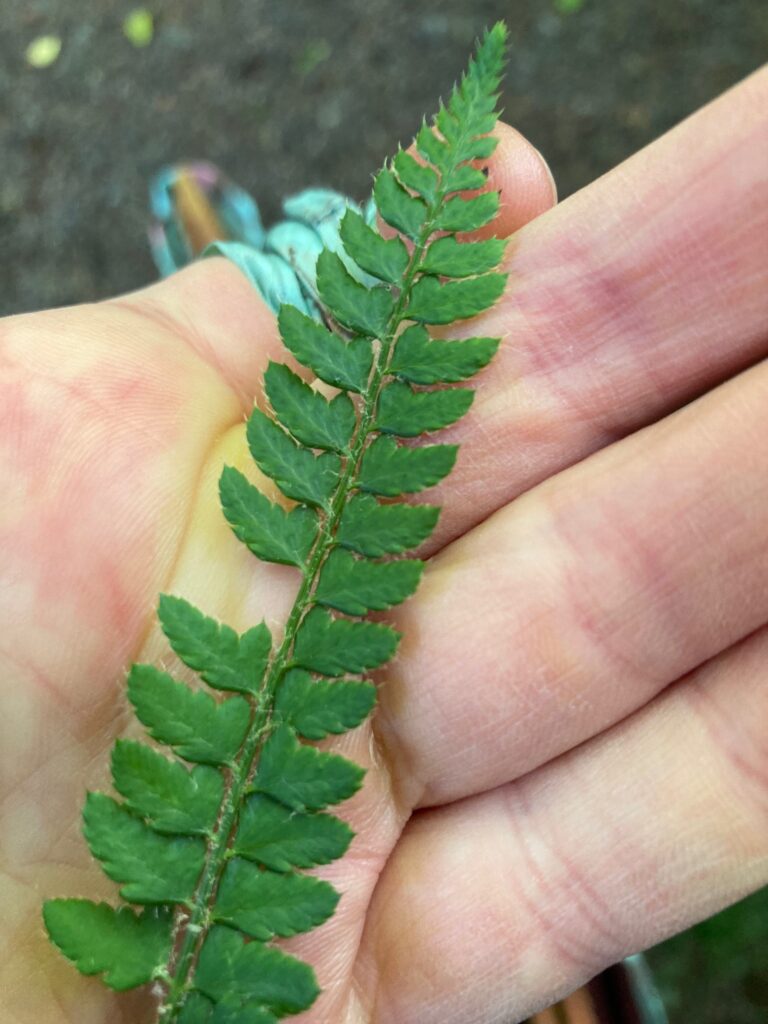
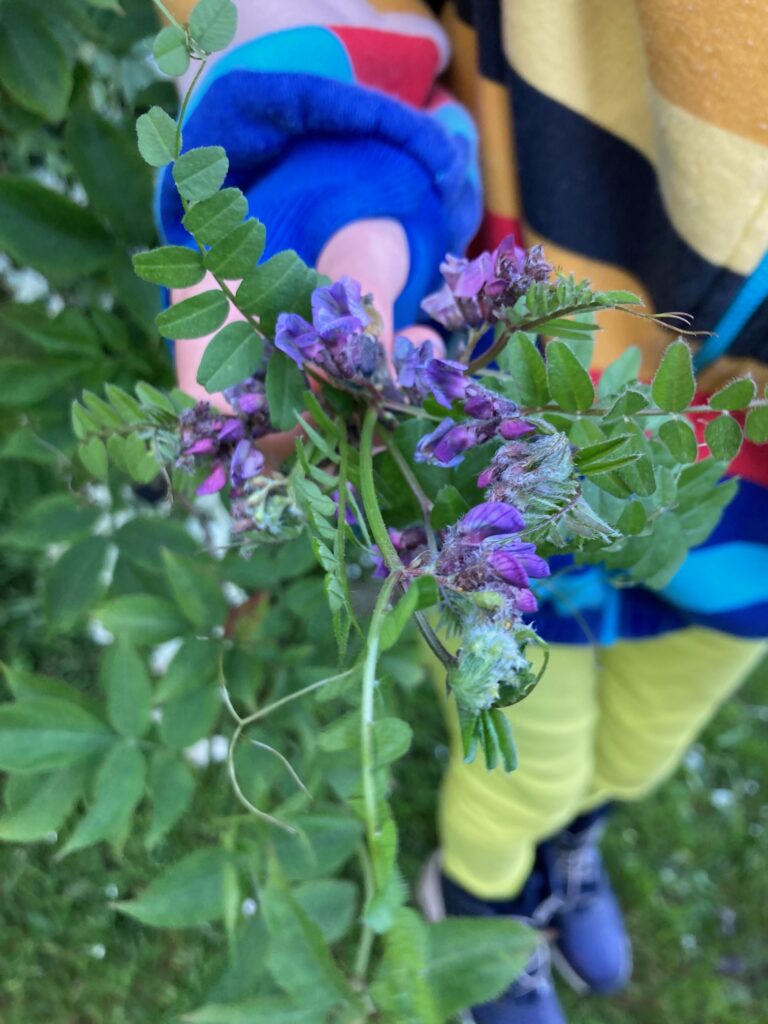
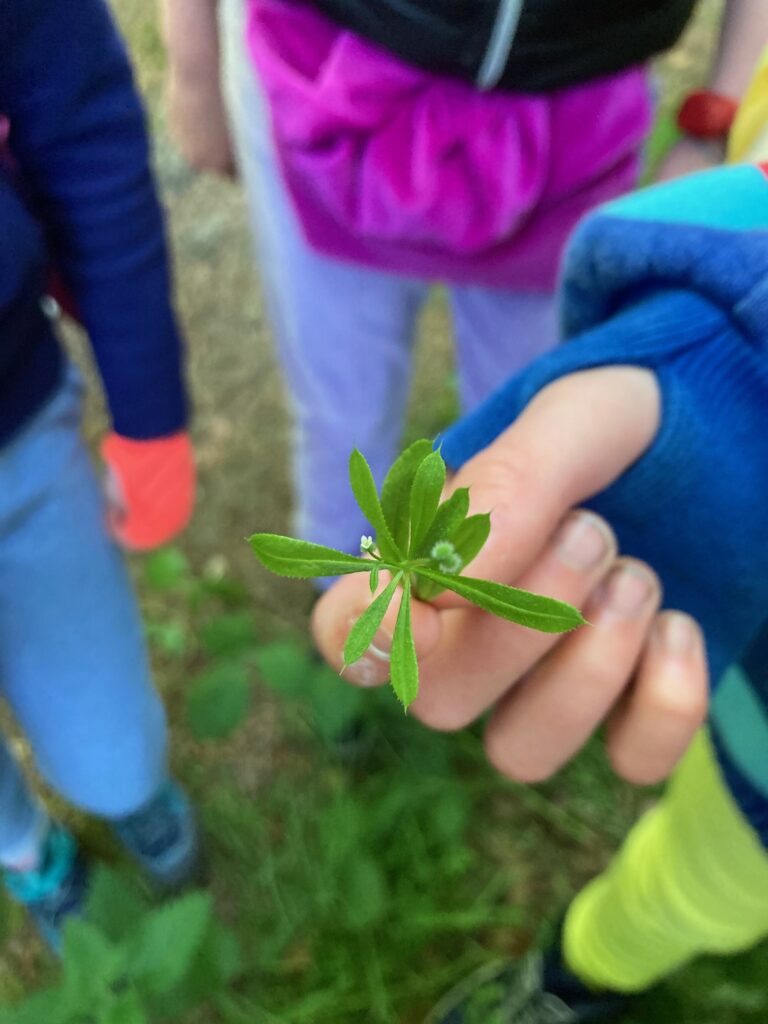
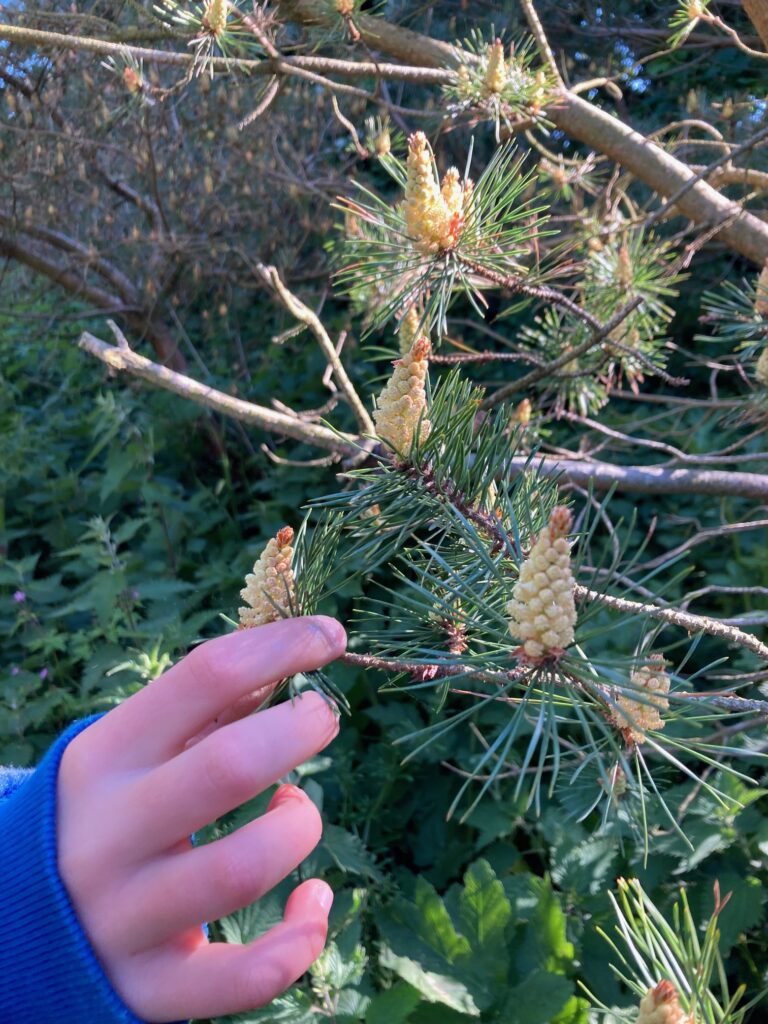
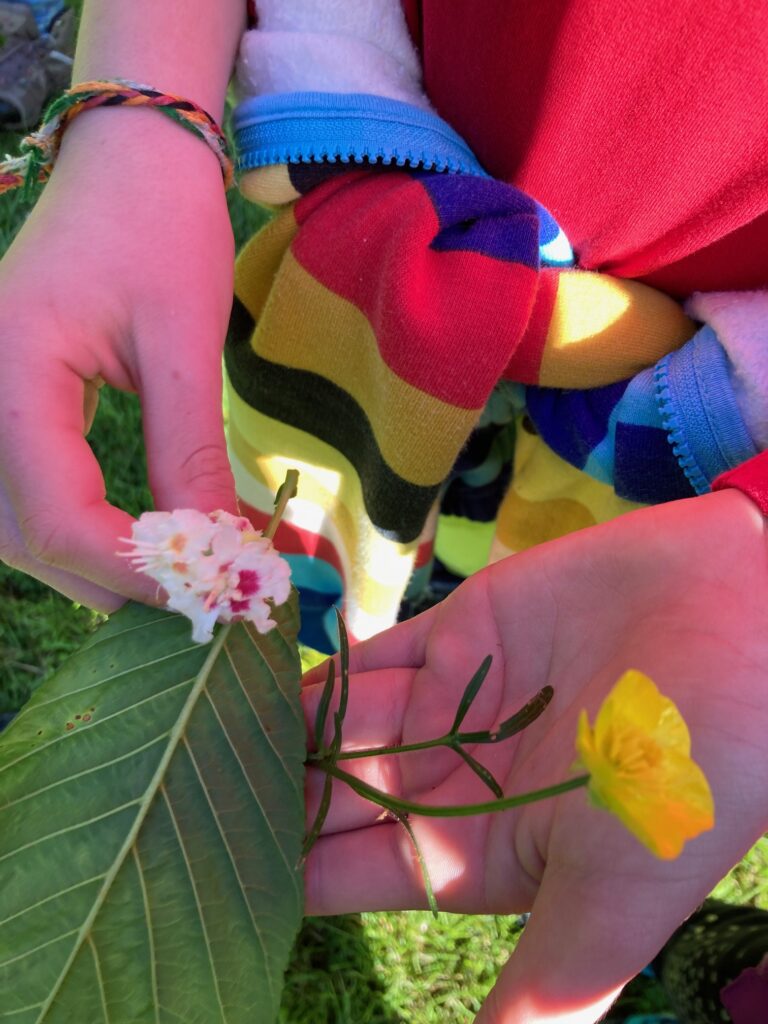
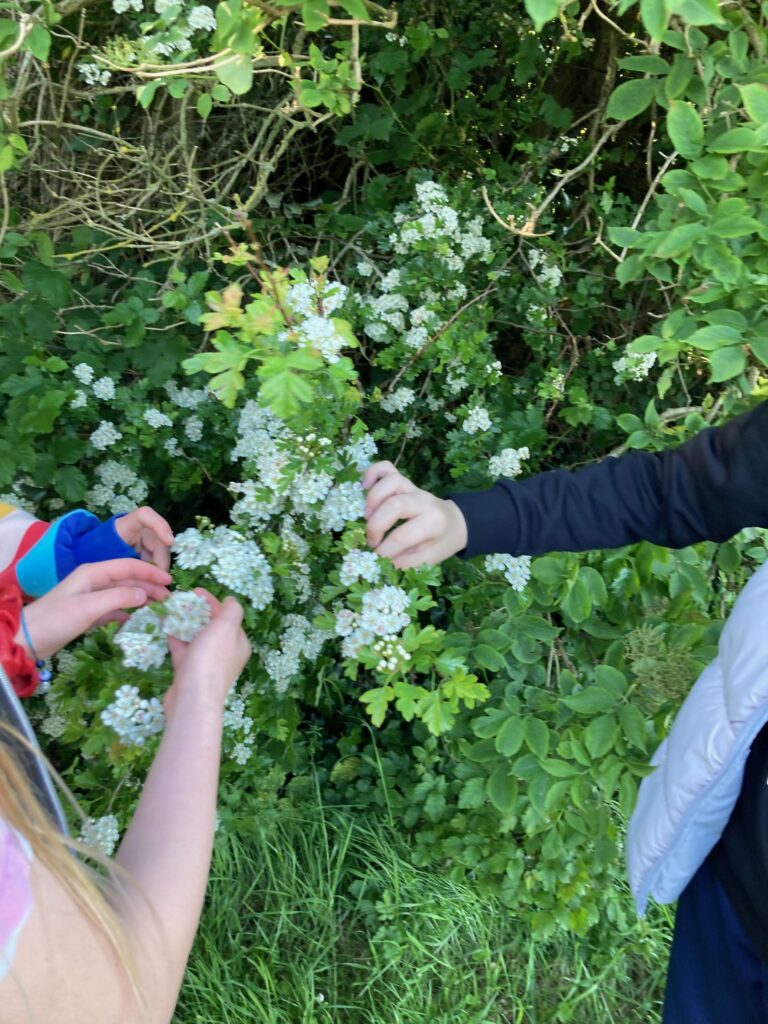
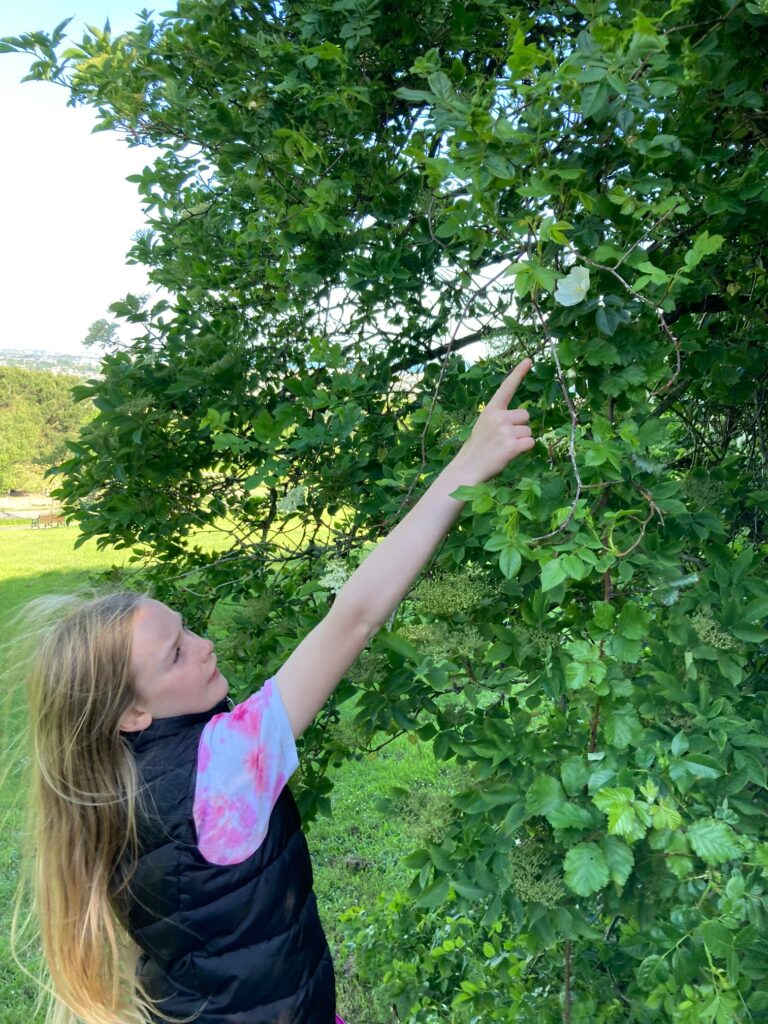
This week, one of the children’s idea became the theme for the group. She brought a string from home, and started to make a big arrow with a big stick. Then the other children started to ask her how she made it, and by the end of the session, most of them had their own bow on their shoulders. They also mixed charcoal and water to mark tribal symbols on their faces. They experimented until they were happy with the colour and consistency. Once again, we digressed from the plan the teacher had developed, and it was great to observe how the session was led by the initiative, enthusiasm and inspiration of the children.
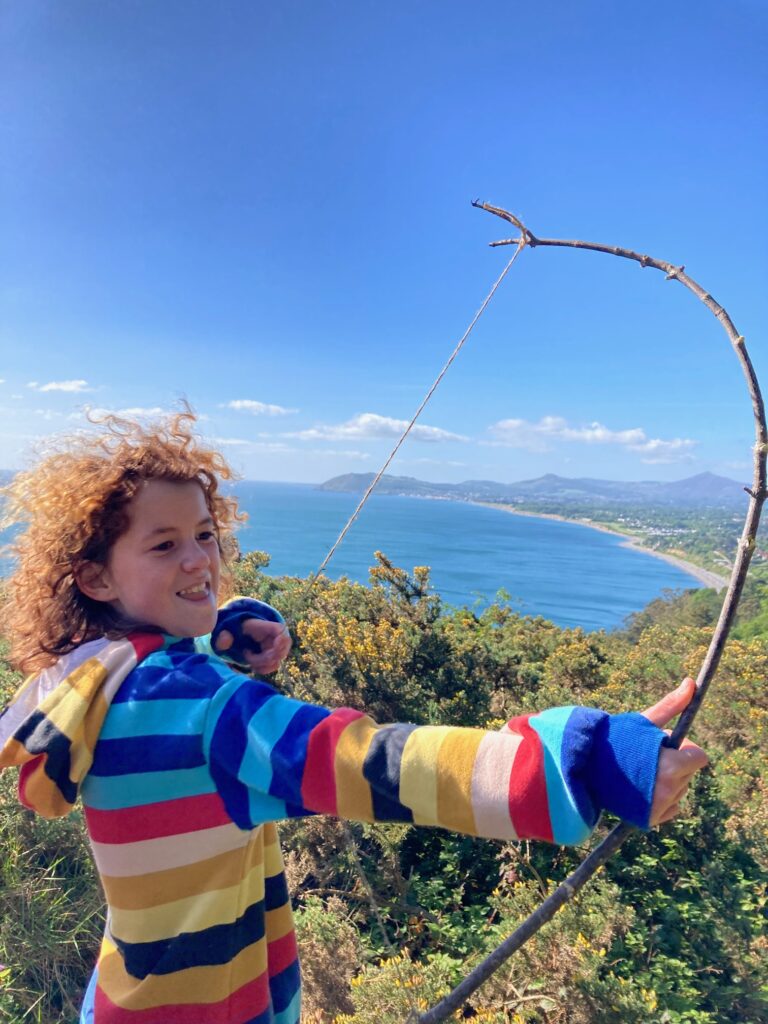
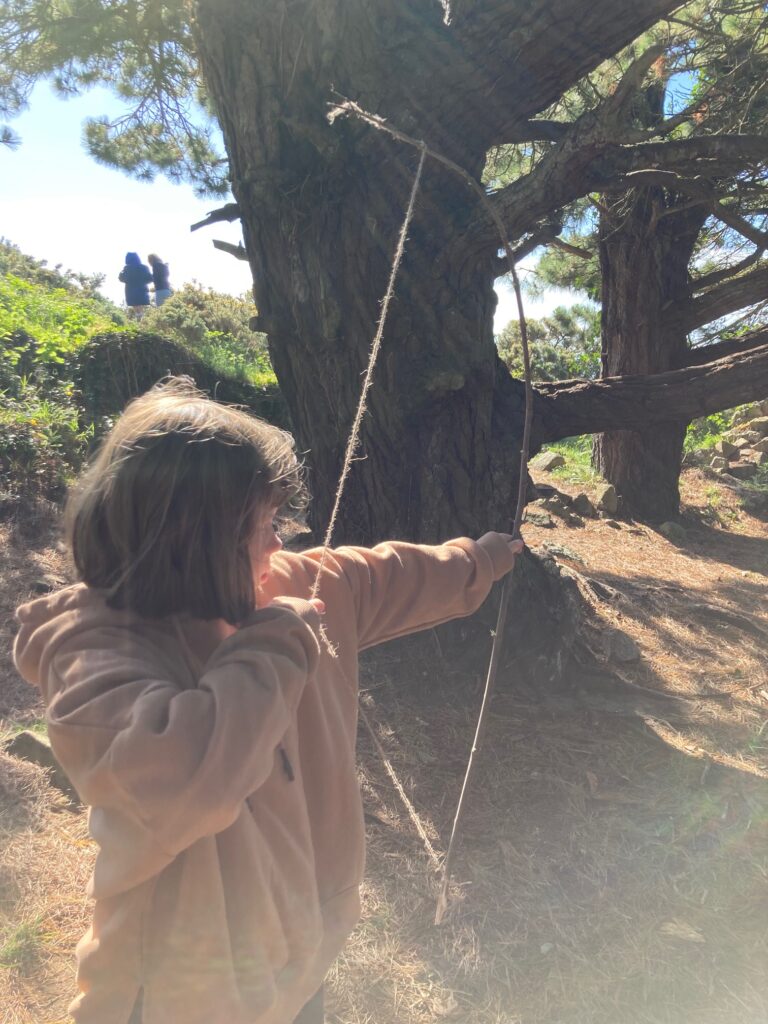
Another child brought a menu for her café from home. She wrote her very original cafe menu such as “Garlic toasties, leafy pancakes, gorse sandwich” and she even included reviews from customers such as “Heavenly” by red squirrels. The ideas and imagination of children are way beyond adults’ expectations, and what is actually happening in children’s minds while they are spending time in nature can’t be over-estimated. While other children were creating a restaurant as a team, this particular child liked to just spend her time, seriously thinking about how to make her own café even better. She was completely absorbed in her imaginary world.
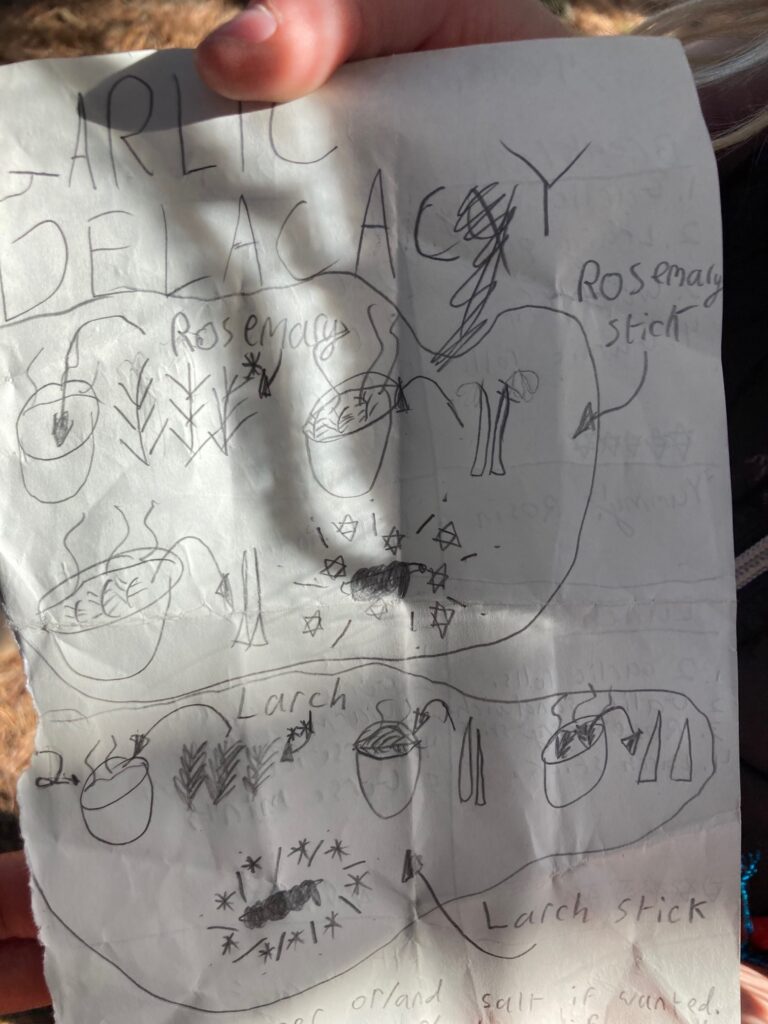
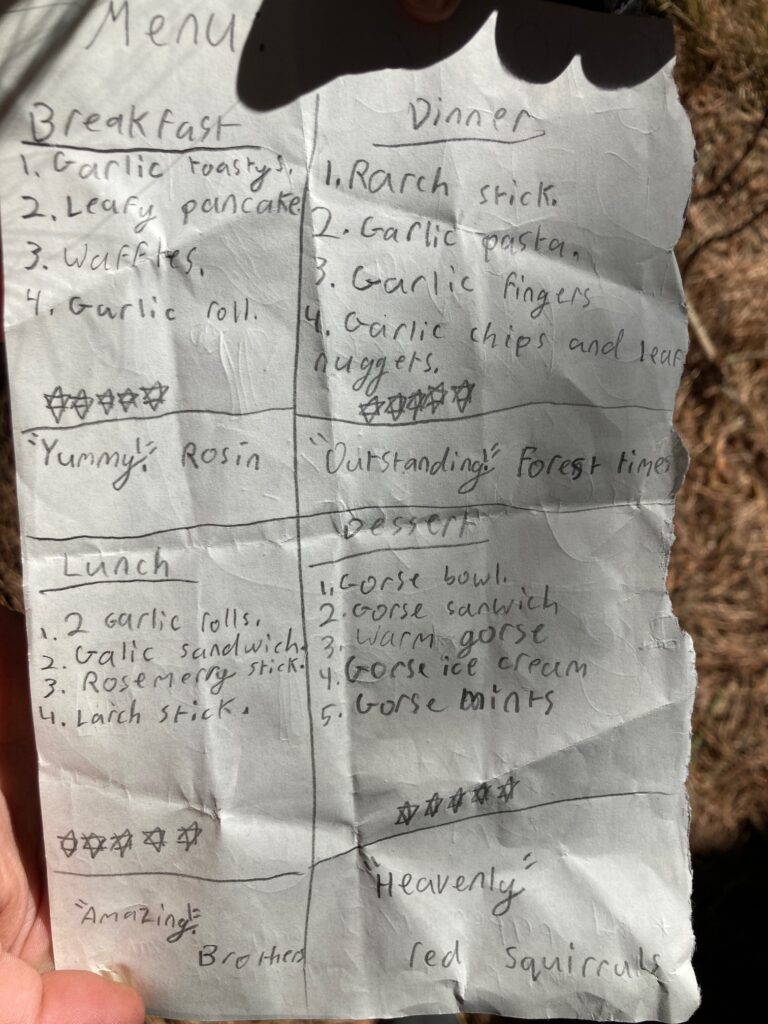
Free play in forest school means time free from any external impositions from adults in the form of games, cards, digital devices, toys, TVs, which might be the favourite things for the children when they are at home. However, in a space where there is nothing but nature, children seem to sharpen their own imagination, creativity, thinking, observations, judgements and their own senses. Children are able to cultivate their own selves and their relationships with each other, and I believe that it enriches and deepens their personal development.
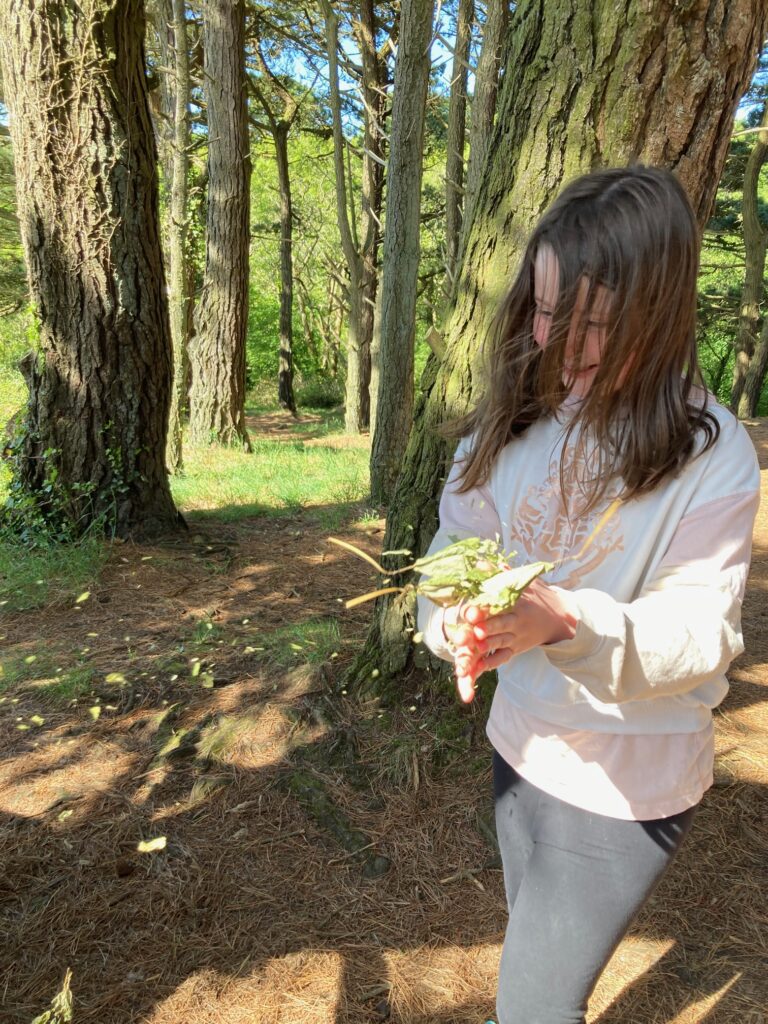
At lunch time, the teacher read a leaf fairy story, and looking at the different leaves we had collected on the way to the base camp. The children noticed that they had different textures, patterns, and shapes. Leaves can be spiky, hairy, wide, straight, tall, thorny etc. They learnt that they are all green, and that the chlorophyll of the green leaves is working to absorb energy from sunlight. Trees take in carbon dioxide which is exhaled by animals, and they discharge oxygen which we in turn breath in. The teacher encouraged the children to breath, and feel that we are connected to the trees by every breath we take.
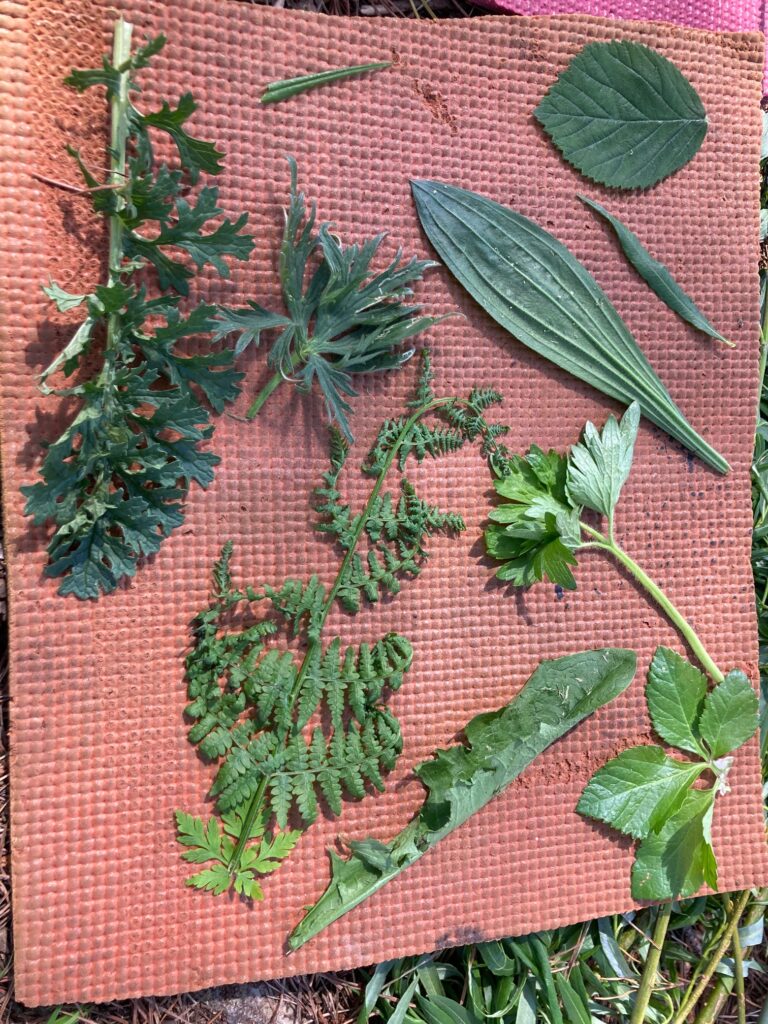
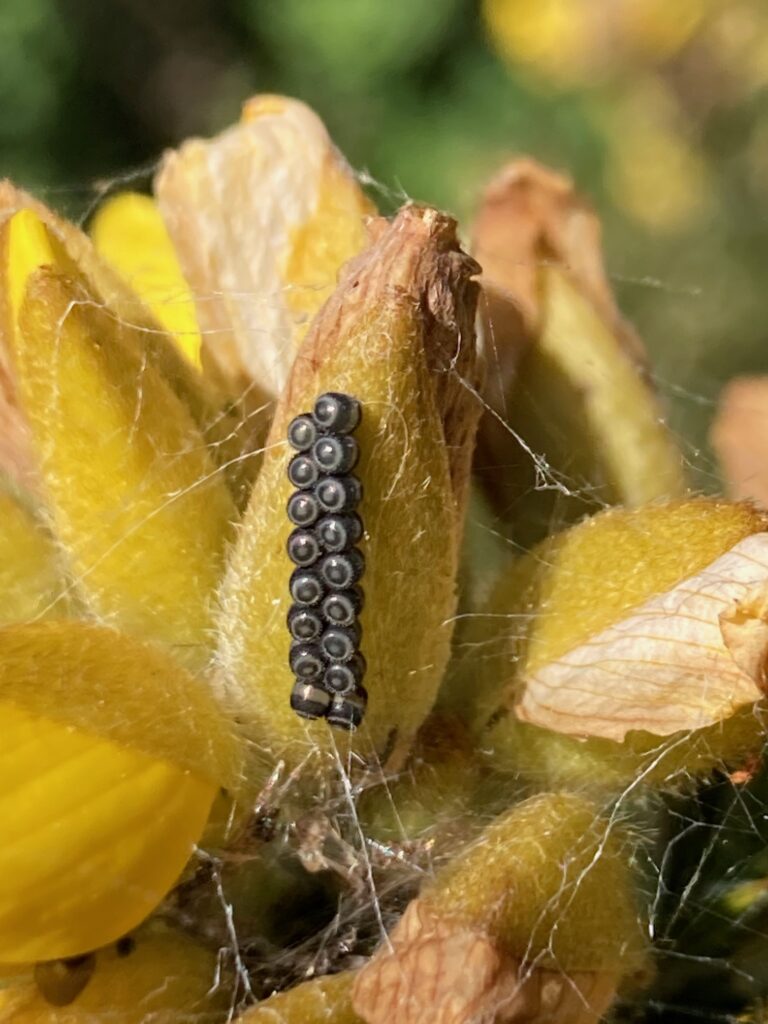
Session 6 – 10 June 2022
It was a sunny and warm day for our 6th session together. The first thing we noticed was that a dead branch was hanging high up on the ash tree at the meeting point. We observed it carefully, and conducted a risk assessment together. We agreed that the dead branch looked well supported by the other branches, but we wouldn’t go near it if it were a day with gusty wind. The leaves of the ash tree were fully grown, and some branches were hanging down, as the leaves got heavier. It was like a secret tent, and the children enjoyed camouflaging themselves with the leaves.
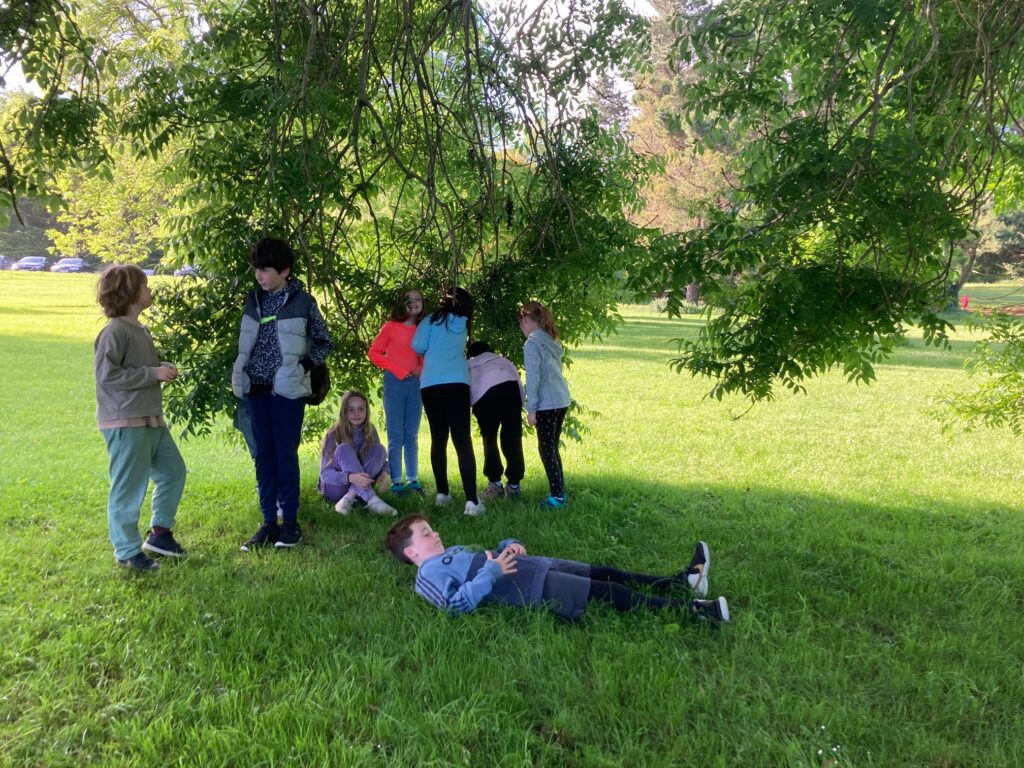
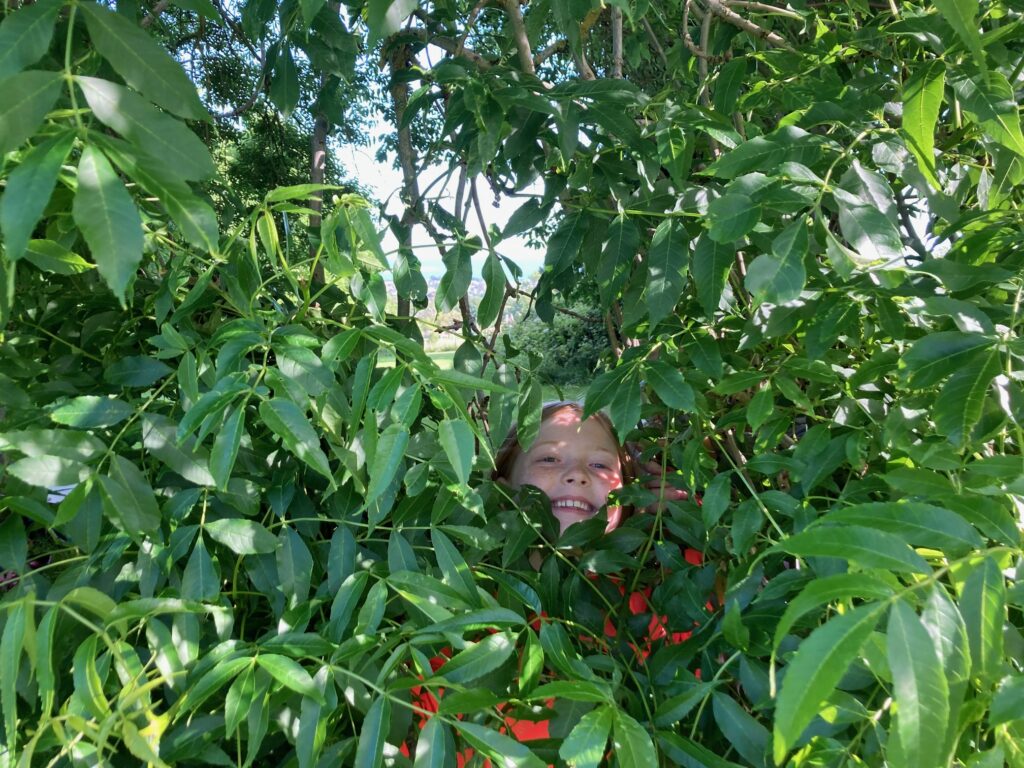
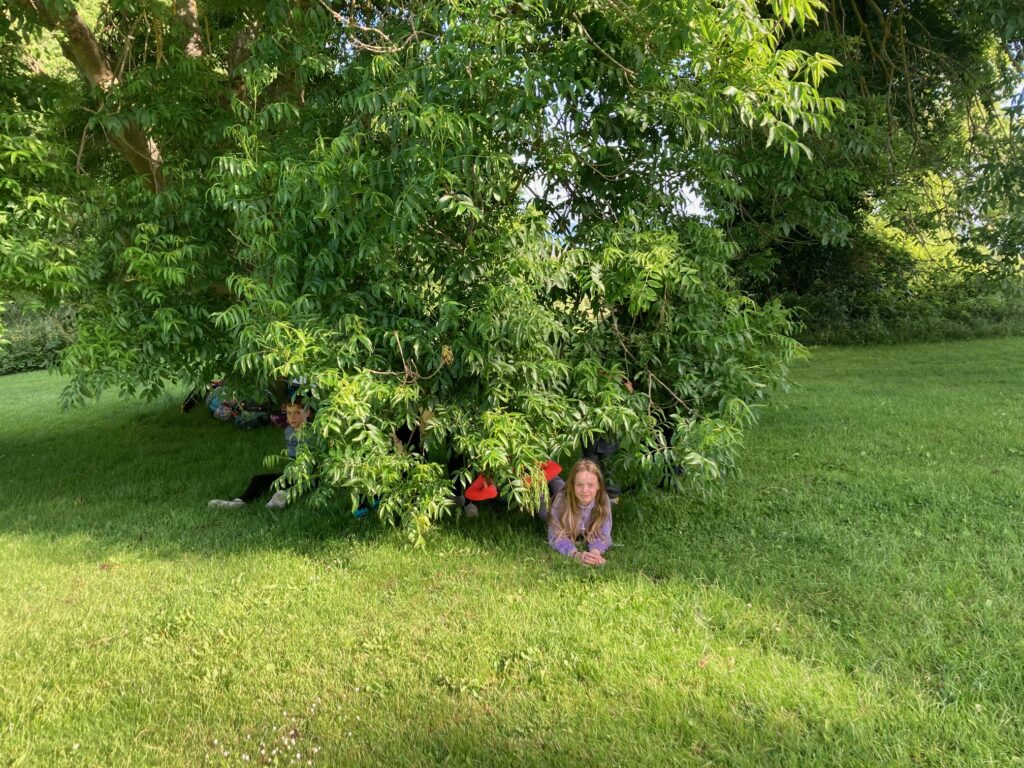
At the opening circle, we talked about the next session. The children can bring an adult with them to forest school! The teacher told them “You will be the forest school leader, so you need to make sure your adults are safe and happy.” They looked excited and came up with lots of ideas for activities to do with the adults such as “sticky back tag”, “the bird game”, “showing them special spots”, “making restaurants with the parents as customers!”
Then we went to the “elder sitter tree”. It had so many flowers blooming. We played the “I wonder game”. In pairs, the children took turns to look carefully at the elder leaves and flowers and started a sentence with “I wonder ….”. The challenge here was not to answer any of these wonderings even if we knew the answer except with another “I wonder…”.
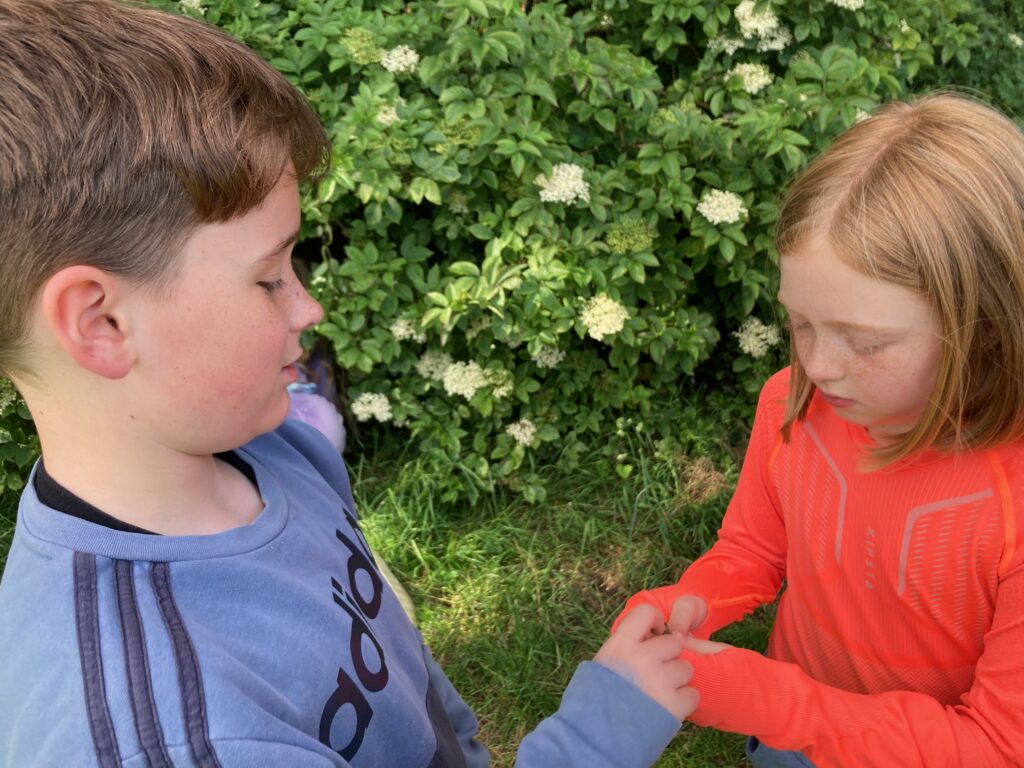
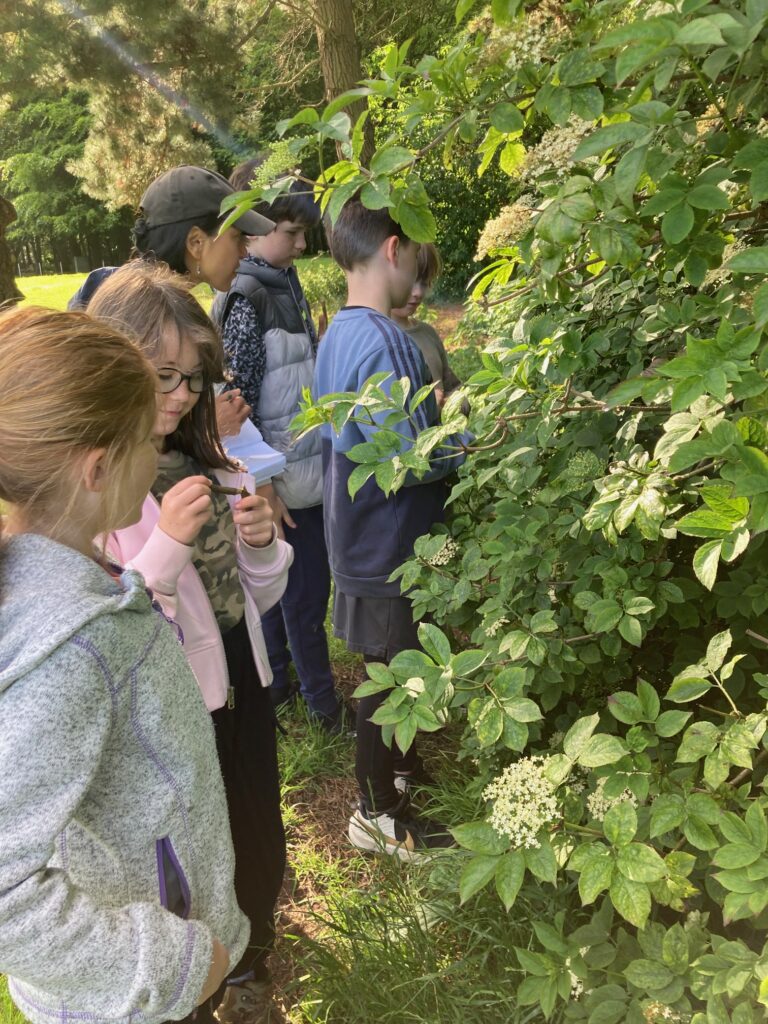
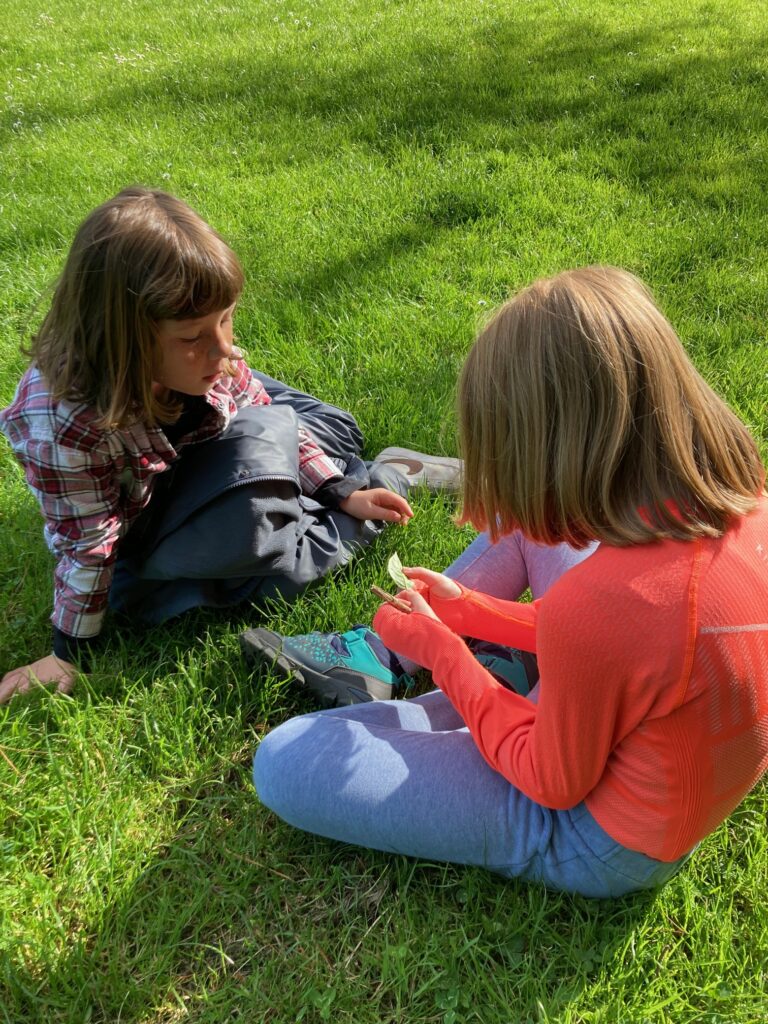
There were so many “wonders” exchanged between pairs, and their favourites were shared with the group. For example, I wonder; “why there are lines going throughout the leaves and some of them are pink”, “if the light and water get into the bushes”, “why leaves and stalks are in same colour”, “why there are spots on the leaves”, “why the back of leaves have lines like blood vessels”, “why some of the leaves have purple edges”, “why the leaves turn orange in the Autumn?” “if it is edible”.
The ability to muse over such things is precious in forest school, and this game helps them to develop their curiosity and their observation skills. In forest school, we hope that the children will develop a sense of wonder that will remain with them throughout their lives. This is sometimes more important than providing them with knowledge as facts. This is not only because it enriches their life experience, but also because it encourages children to seek explanations and solutions by themselves. In particular the ability to notice abnormalities in natural cycles is crucial in reacting to the unknown effects of Climate Change, pandemics etc. in the future.
The children also smelled the elder leaves, and noticed that the leaves had a strong smell. Some children described the smell as being like “cucumber” or “dandelions”. The teacher explained that it was to avoid being eaten by insects. When we observed again with this in mind, there were not many insect bites on the elder leaves. We also used the elder leaves as insect repellant for ourselves.
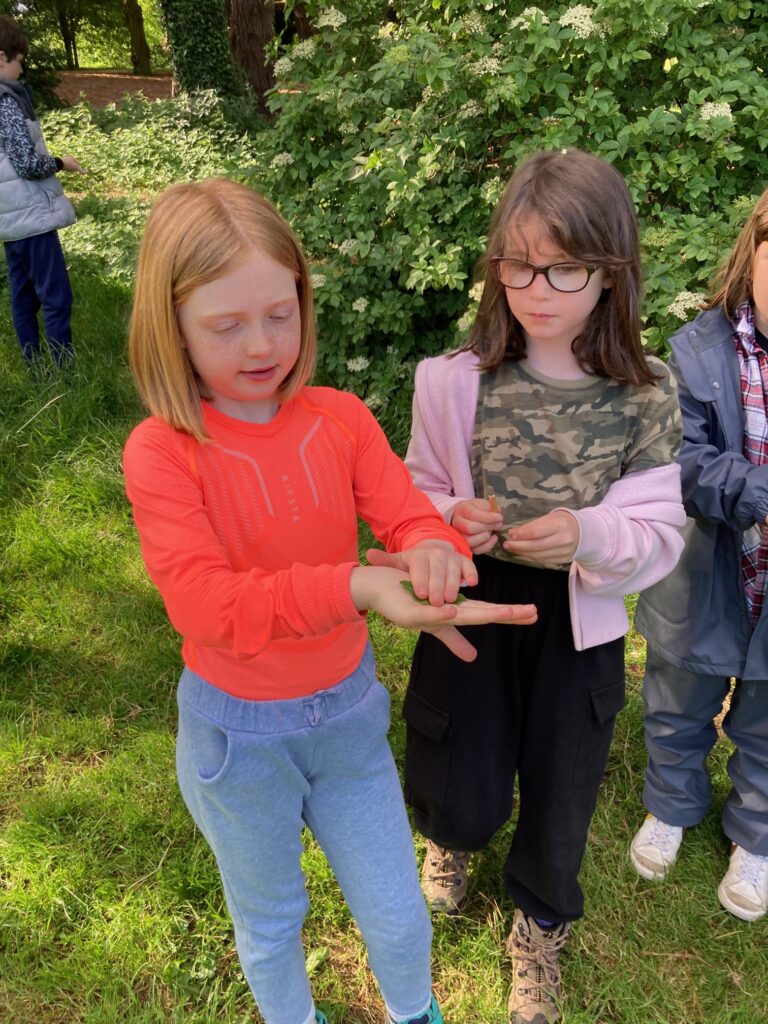
The leaves of horse chestnuts were greener and the berries were spikier. The children touched them carefully, and noticed that they were a bit harder compared to the previous weeks. This time, the children found many mushrooms on the ground. One of the children found a particularly big mushroom, and we all looked at it carefully. Half of the mushroom was eaten and we wondered what kinds of creatures had nibbled it.
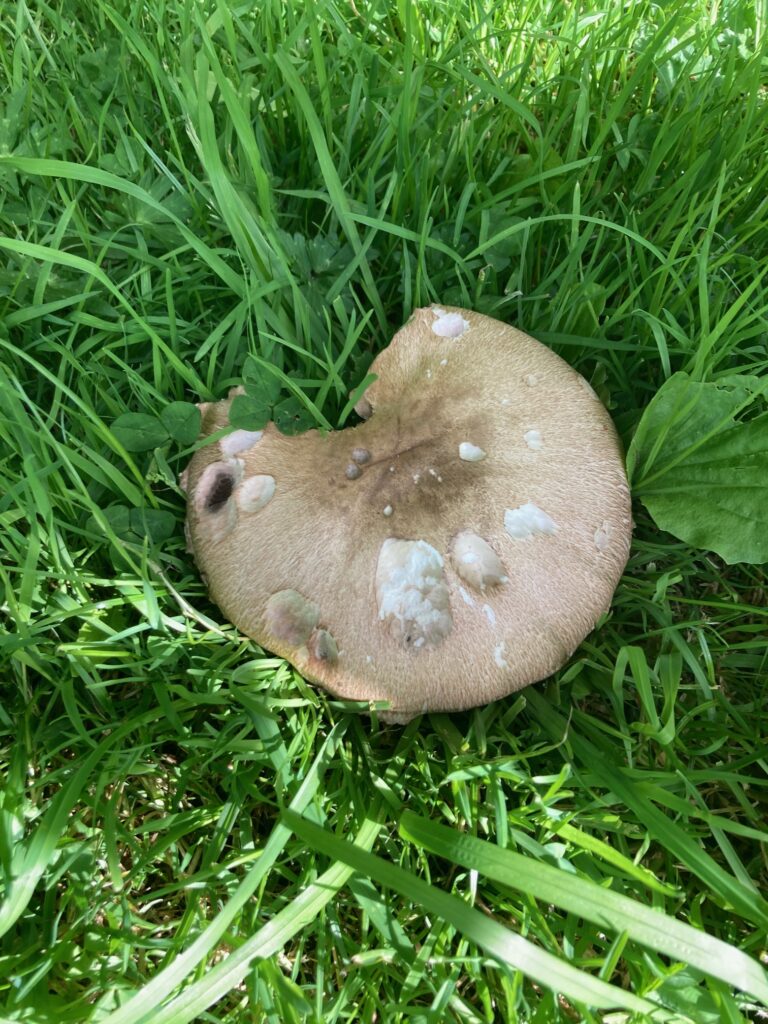
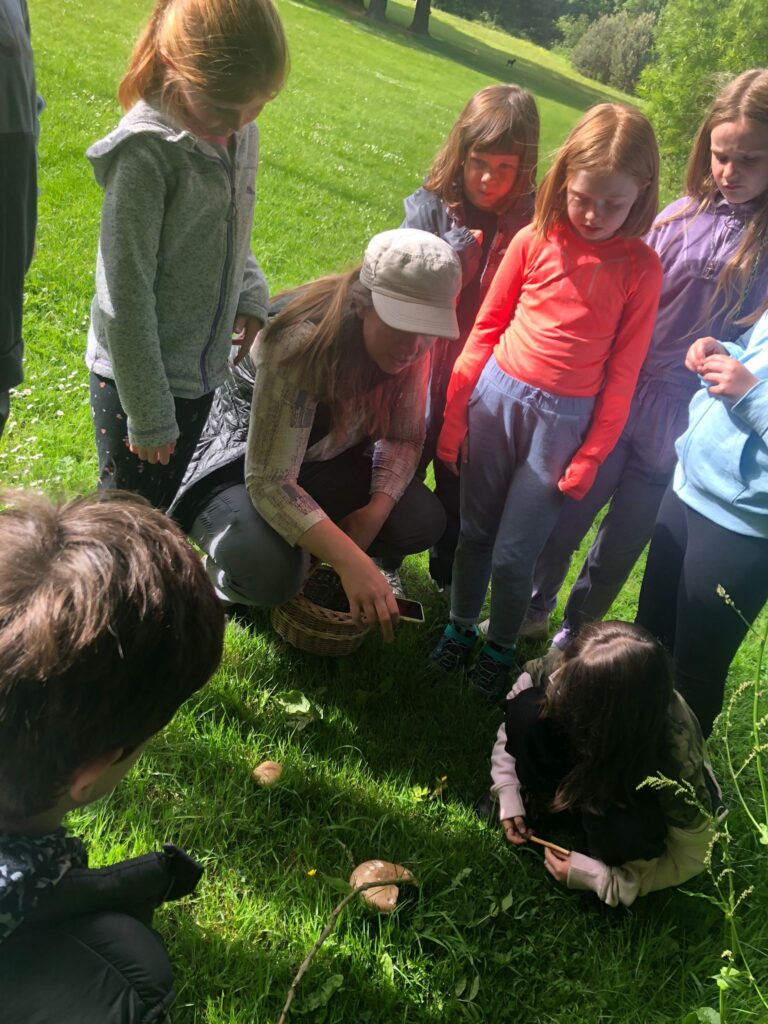
We also noticed that the cherries were bigger and more orange. The teacher asked the children why they would be tasty for birds and other animals. The children learnt that this is a way of spreading their seeds by animal’s pooping them out (!).
Then, one of the children found an eggshell beside a bush! It was white and approximately thumb-sized. We observed it carefully, and the teacher explained that a chick must have been successfully hatched, because the edge of the eggshell was clean. We looked up the tree where the eggshell was, but couldn’t see any birds nests. We learnt that birds normally drop their eggshells away from their nests to hide them from predators. For most of us, it was our first time to find an actual eggshell of a wild bird, and it was so special to be able to get a feel for the bird’s life cycle.
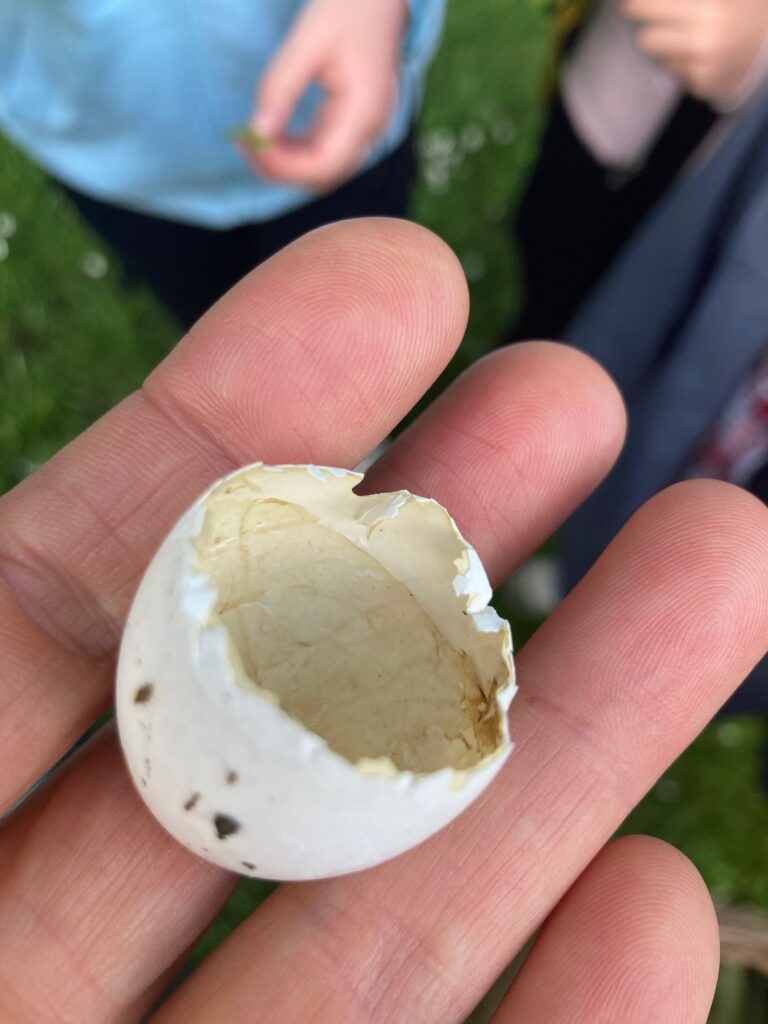
There were some sticky backs (garbhlus – rough herb) flowers blooming, so we looked for the tiny white flower. The children counted the petals, and looked for tiny green seeds. This is a wonderful plant to play tag with, because it sticks on clothes. This time, some of the children made crowns using it and adding in daisies and buttercups.
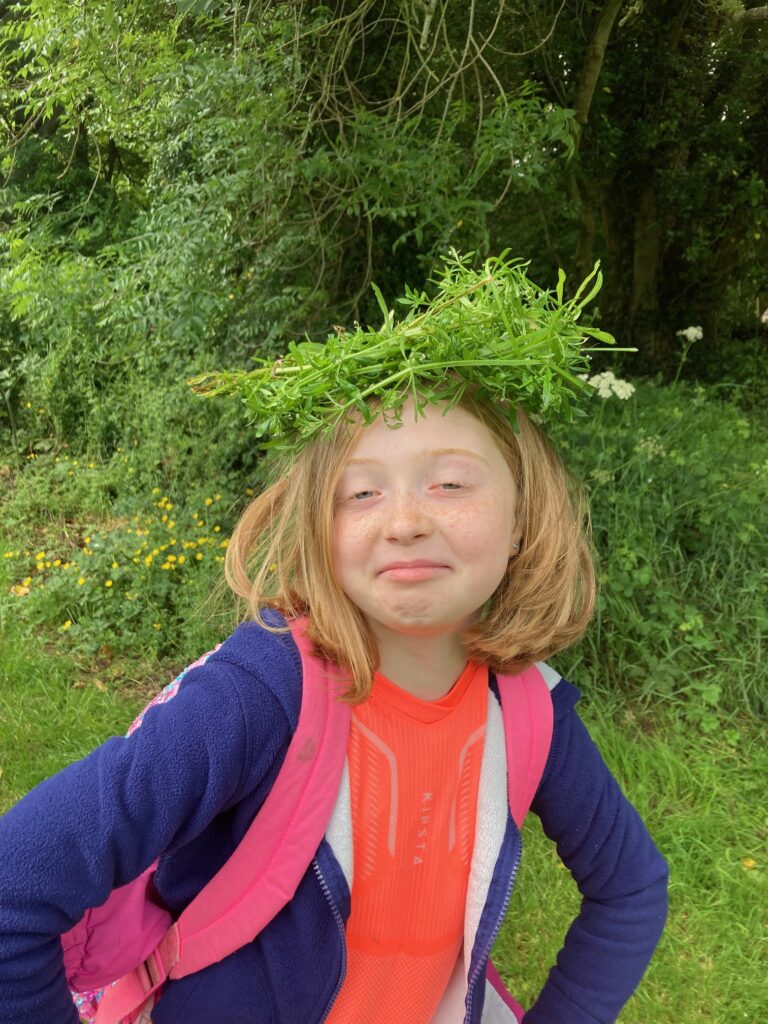
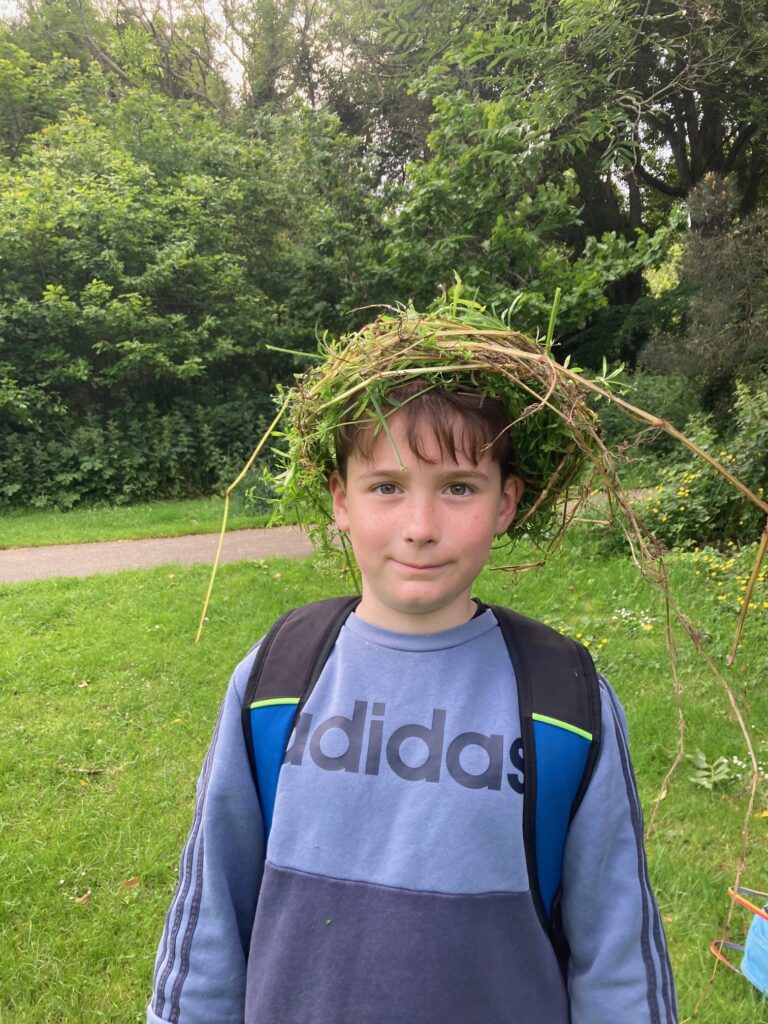
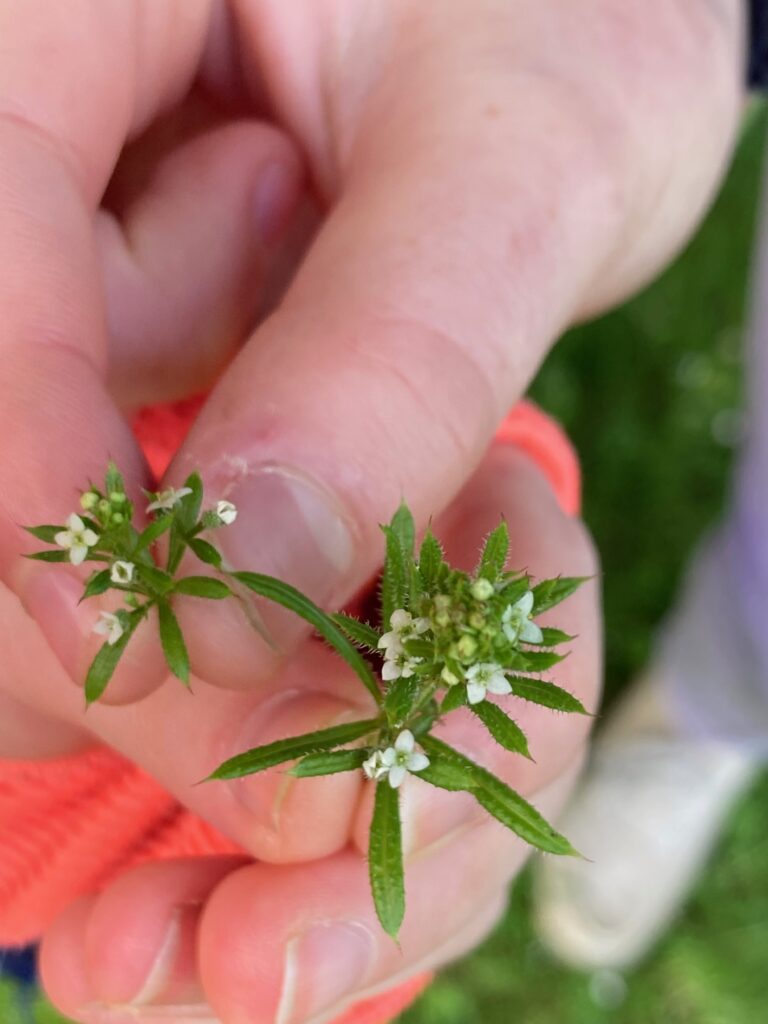
On the way to the basecamp, one of the children was telling other children her plan for the free play today. She wanted to be a doctor, and she asked the other children whether they wanted to be a nurse or receptionist. Forest school has a routine, and the children know what to expect from a session. In particular because they know that they have time for free play, they can plan in advance, just as other children brought string for a bow and arrow and a menu for the café.
As soon as we arrived at the basecamp, a couple of them started to choose the place for a doctor’s surgery, and crated a system; patients needed to book at the reception and wait at a waiting seat (a log). When they were called, they should come to the doctor’s room (a bush), and are able to have a doctor’s consultation. They are then given a prescription (a leaf), and the adjacent pharmacy (adjacent bush), can provide them with medicine (edible plants).
In forest school, children experience different forms of life such as those of animals and trees through games, activities or free play so that they develop empathy for other lives. Empathy is an important ability, which can help the children to build good relationships with people around them, and also to act responsibly in society and toward the natural environment.
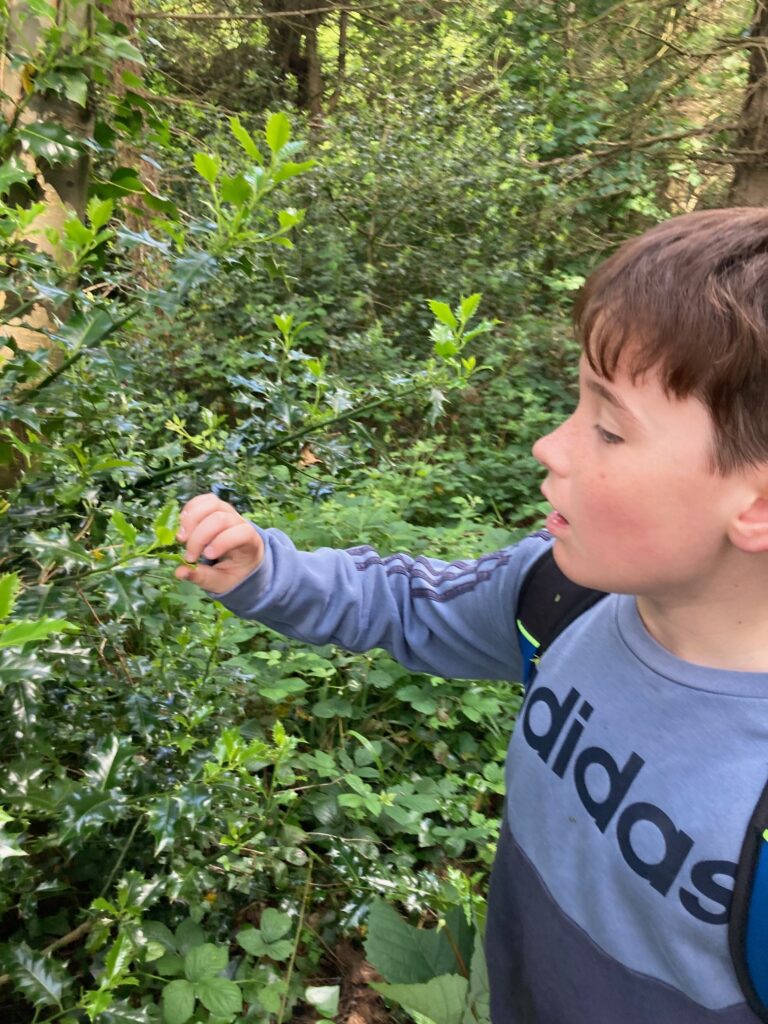
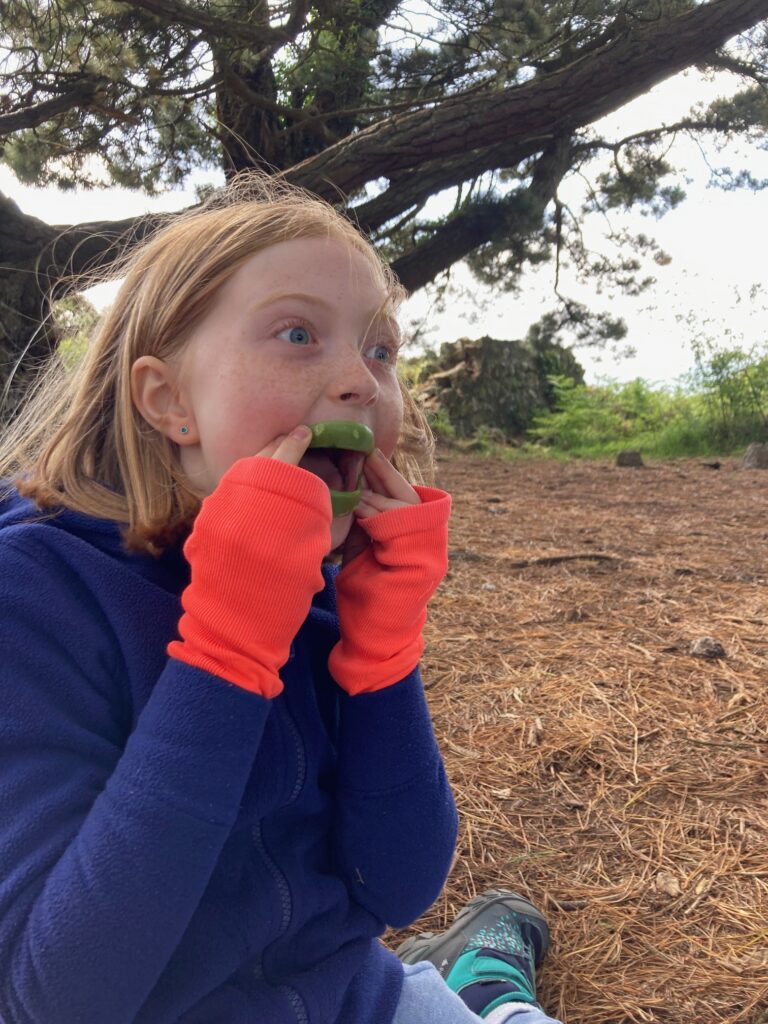
This time, the children chose to experience working as a medical team. In the end of the session, one of the children involved in this play mentioned that she was grateful for her medical team at the doctor surgery, and also grateful for the doctors and nurses in real life who worked hard throughout the covid-19 pandemic.
We also noticed that lots of living trees had been snapped and used to make a new den. As we felt a huge concern that other people who see it might start to do it, which could damage the ecosystem in Killiney Hill. We decided to write a letter to the council and to the park manager to share the children’s concern.
Session 7 – 17 June 2022
It was a summery day for the 7th session of the third class, and it was the parent’s session. Children brought their parents or older siblings to their forest school. At the meeting point, the children were showing off what they knew about the surrounding nature. It was already a nice atmosphere, in which adults were ready to have a great time with their children and to learn from them. The children looked proud and acted differently from how they were in the regular sessions. We welcomed everyone at the opening circle, and introduced our names with gestures. We played cuckoo bee game, and demonstrated what we have been observing throughout the sessions.
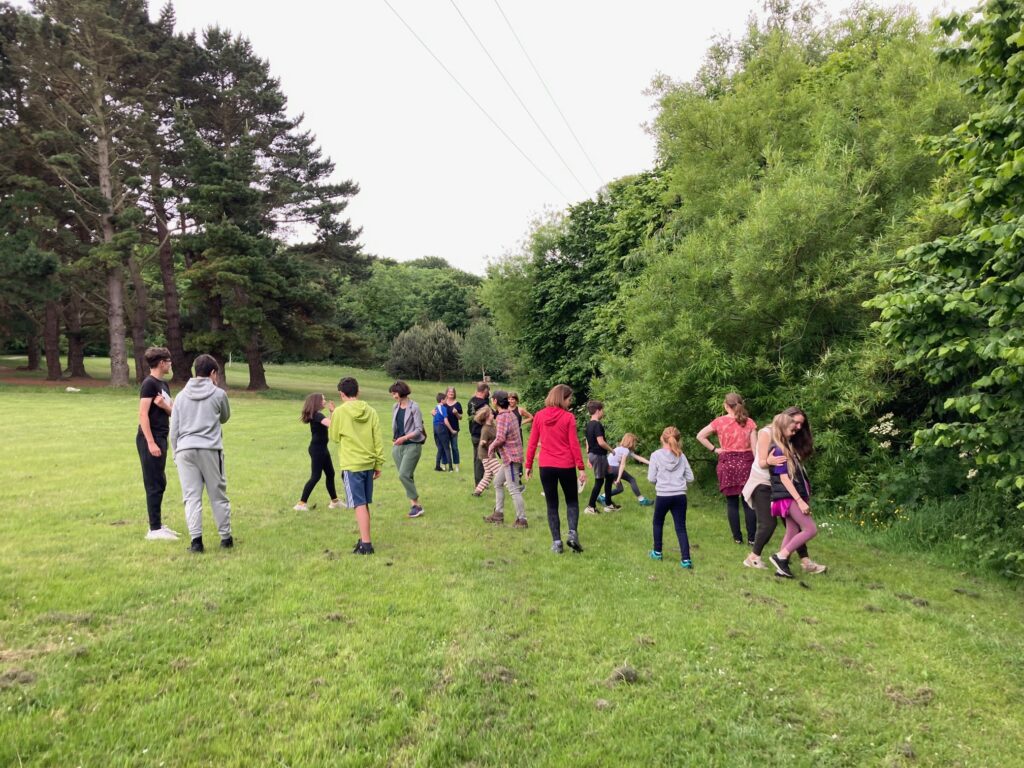
First of all, the children introduced their adults to the elder sitter tree, and showed them what they have been noticing about this plant over the weeks. Because of the “I wonder game” from the previous week, the children knew many features of this plant. The adults enjoyed the lovely scent of its flowers and the strong smell of its leaves, and were impressed by the detailed observations by the children. We moved around to show them different trees, and three older siblings started to play sticky back tag. They were former DSP students, and seemed to remember how they had played in the woods.
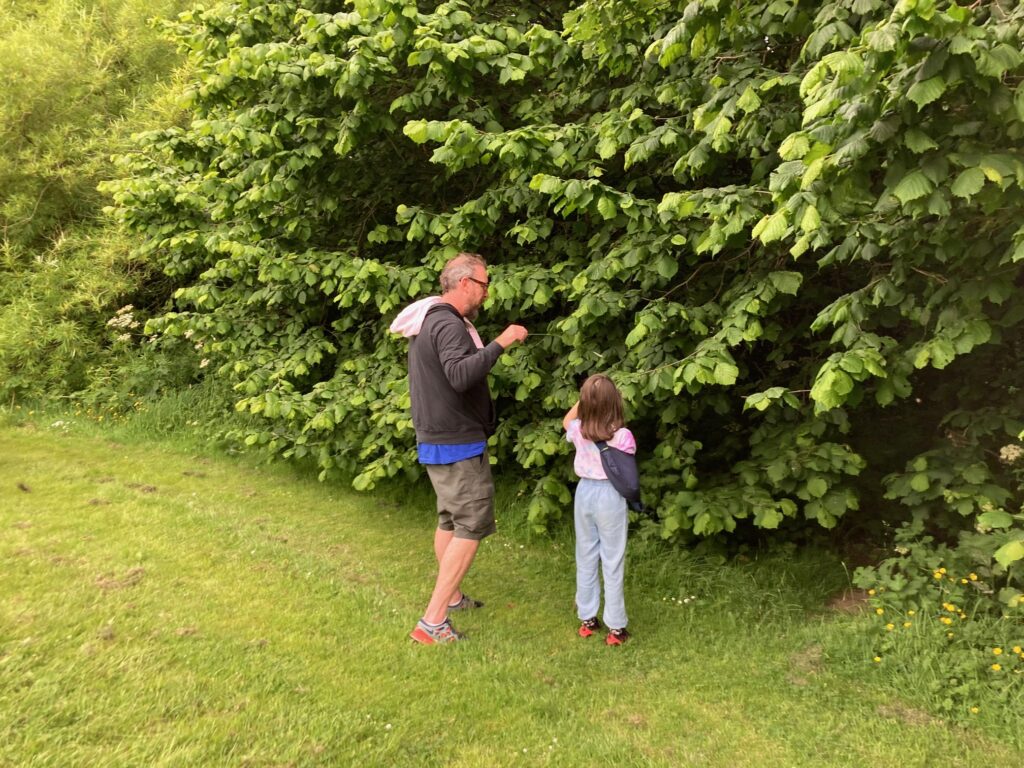
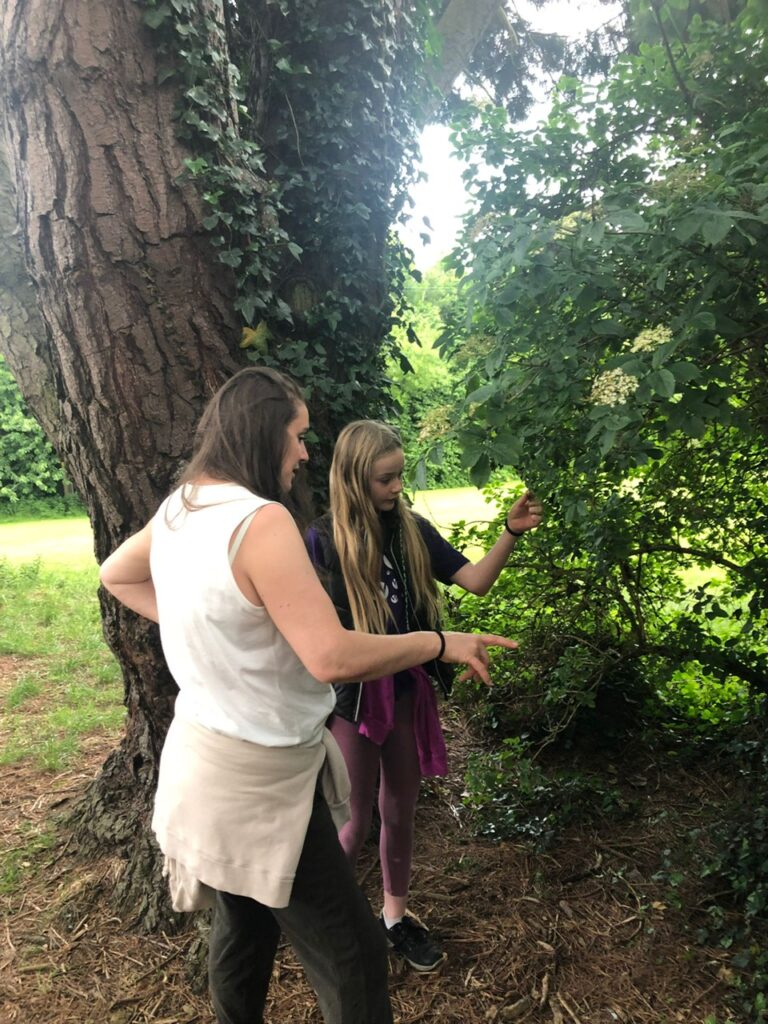
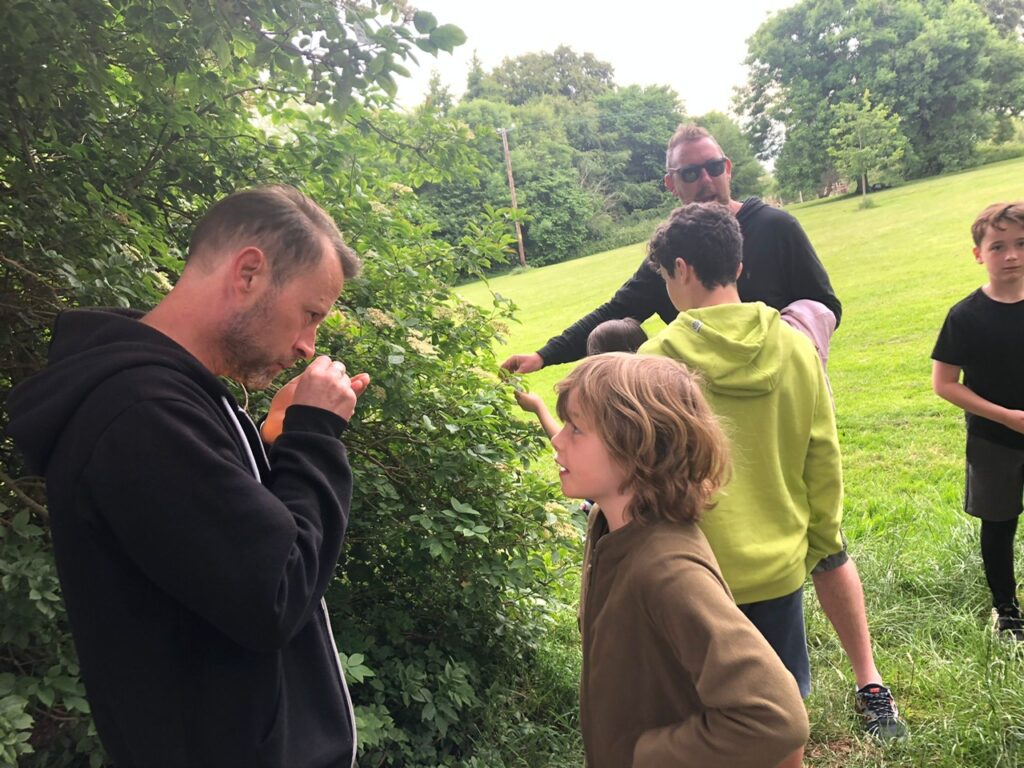
On the way to our basecamp, the children pointed out the site where we had found an eggshell, played sticky weed tag, showed the adults edible plants such as vetch and beech leaves, and picked flowers with their leaves for use later in the activities. At the basecamp, the children introduced their restaurant and started collecting edible plants from the surrounding environment. The parents were a bit suspicious but tried some of their restaurant food such as gorse seeds and flowers. In this way, the children were able to share their favourite spots and favourite things to do in the woods with their parents and siblings.
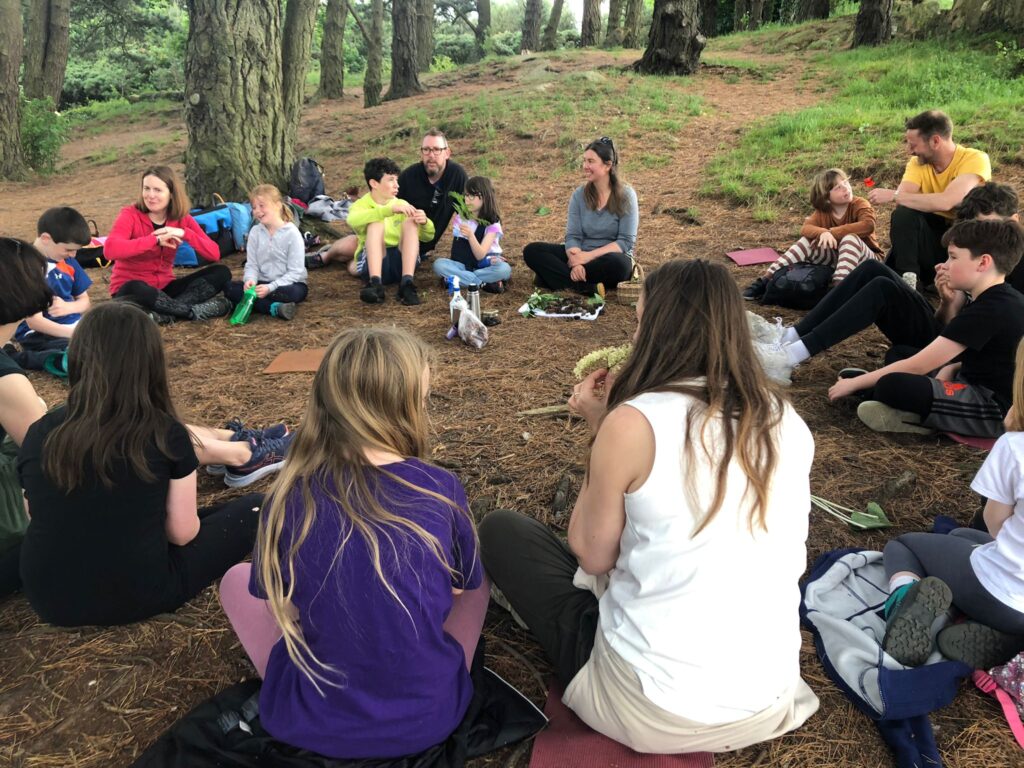
Then in the circle, we played the “I wonder game” in pairs or in family units. The adults also made detailed observations of plants and shared their “wonders” with their children. Then they chose either to make replicas of the plants out of clay, or draw them in charcoal, or make charcoal prints. Some families made charcoal prints as a team while others made clay flowers individually. The two brothers went to sit down in a quiet place together, and made clay flowers in silence. Adults were surprised by the children’s creativity, and also enjoyed making their own art works, which some of them found therapeutic.
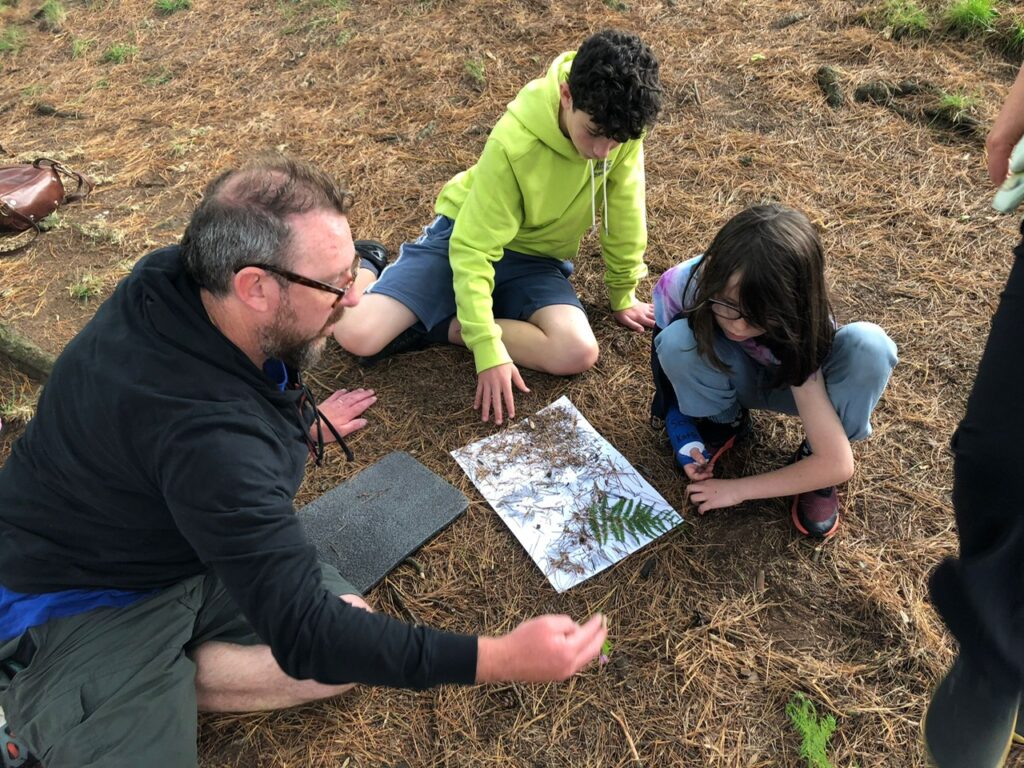
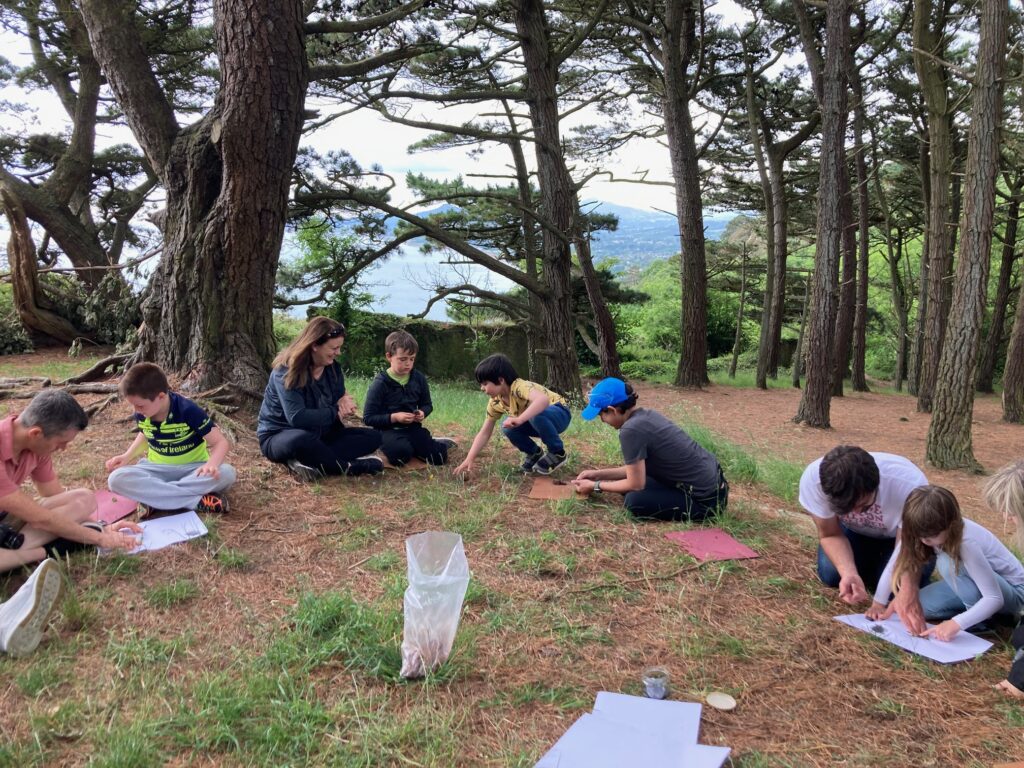
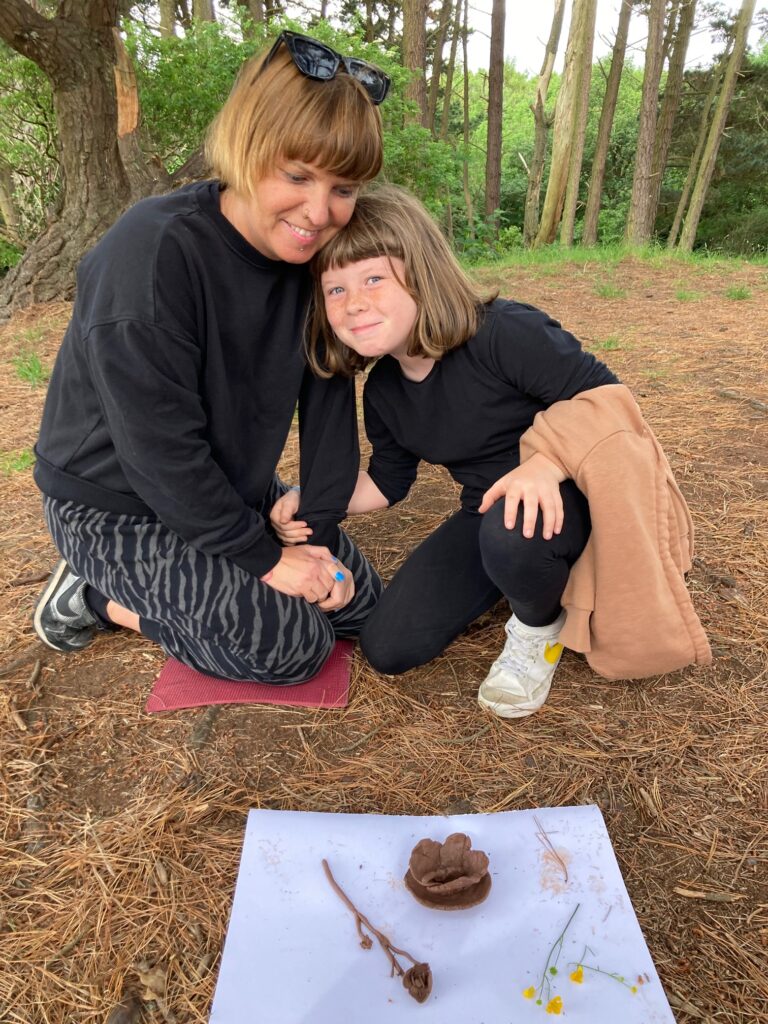
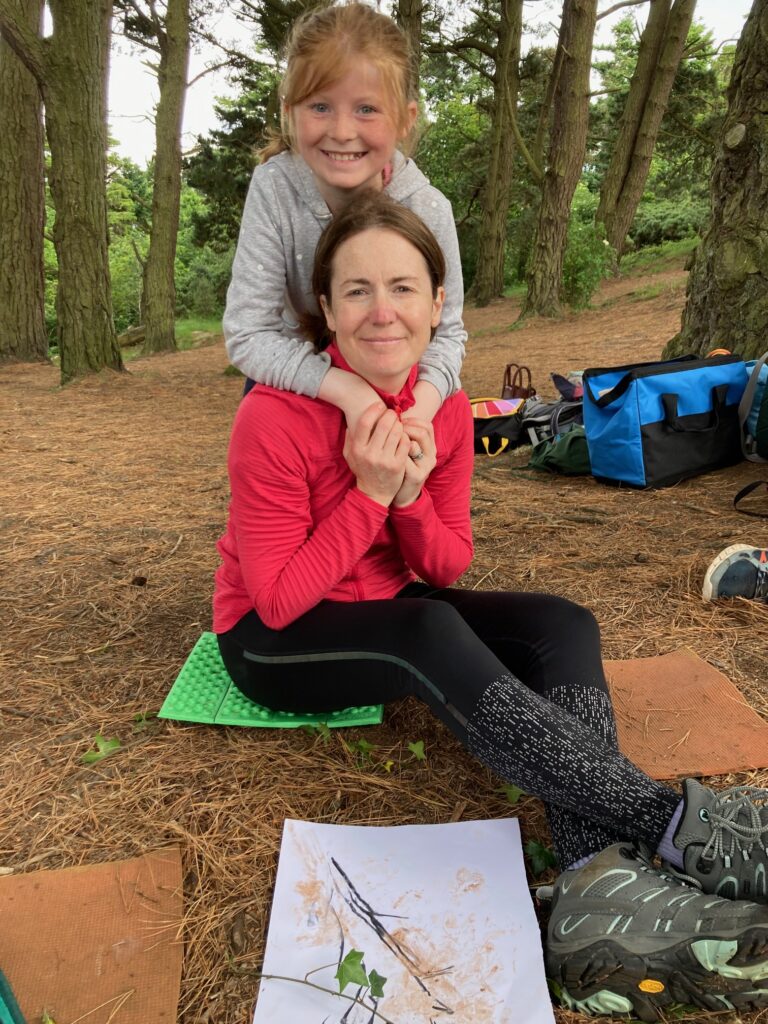
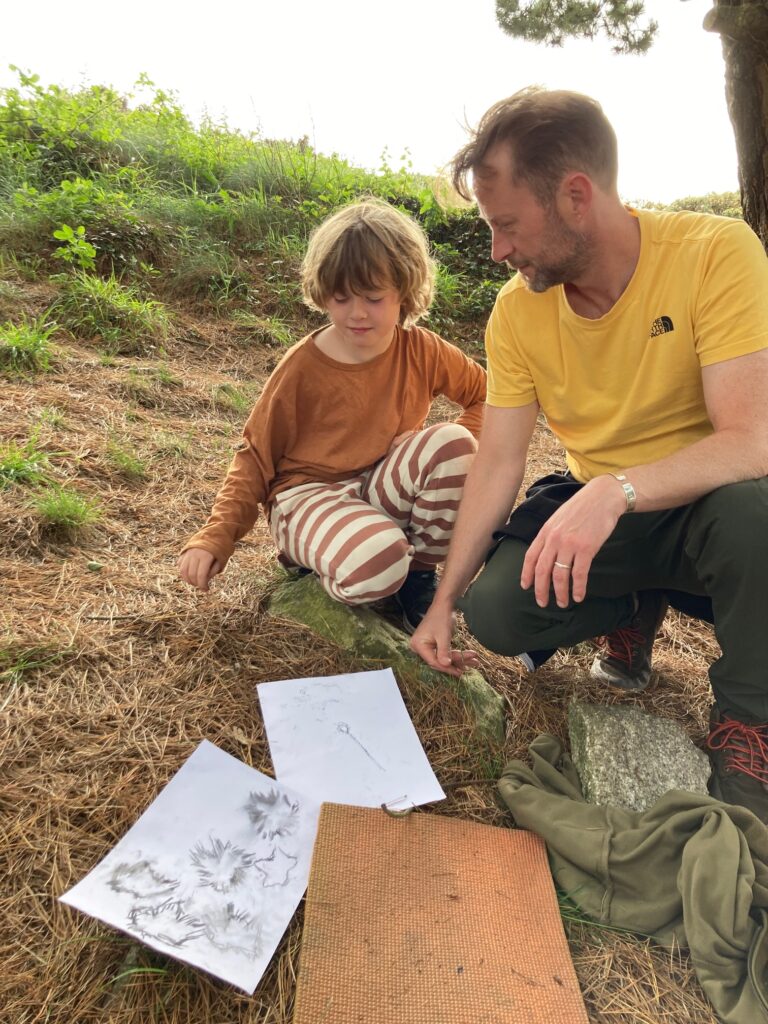
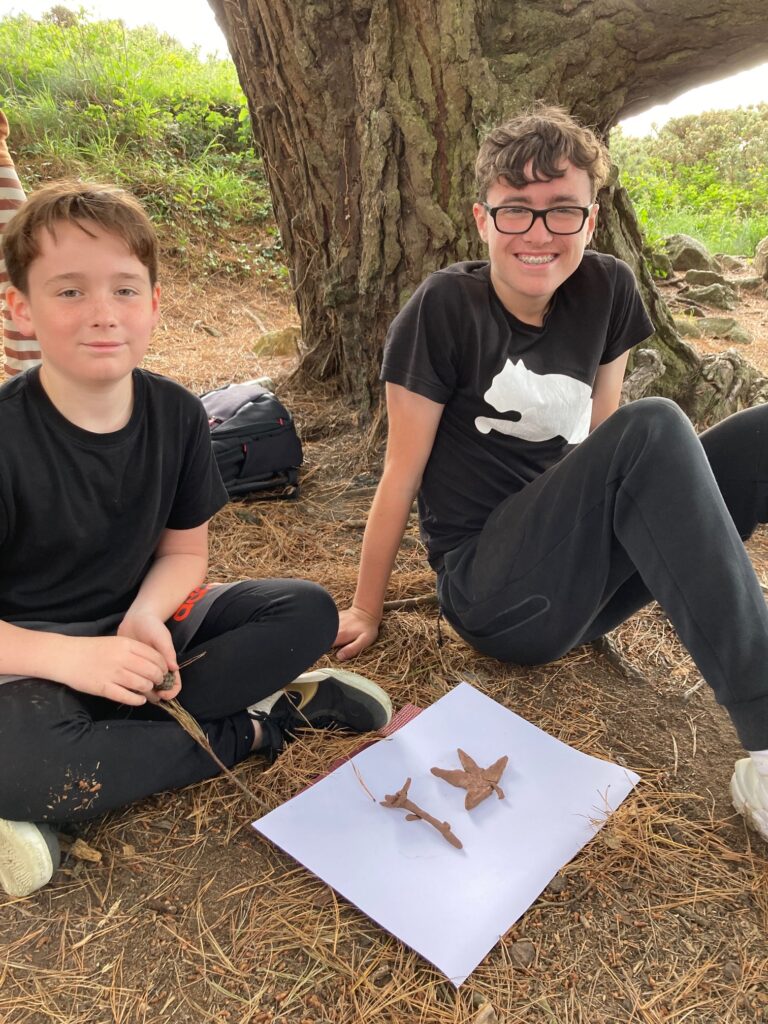
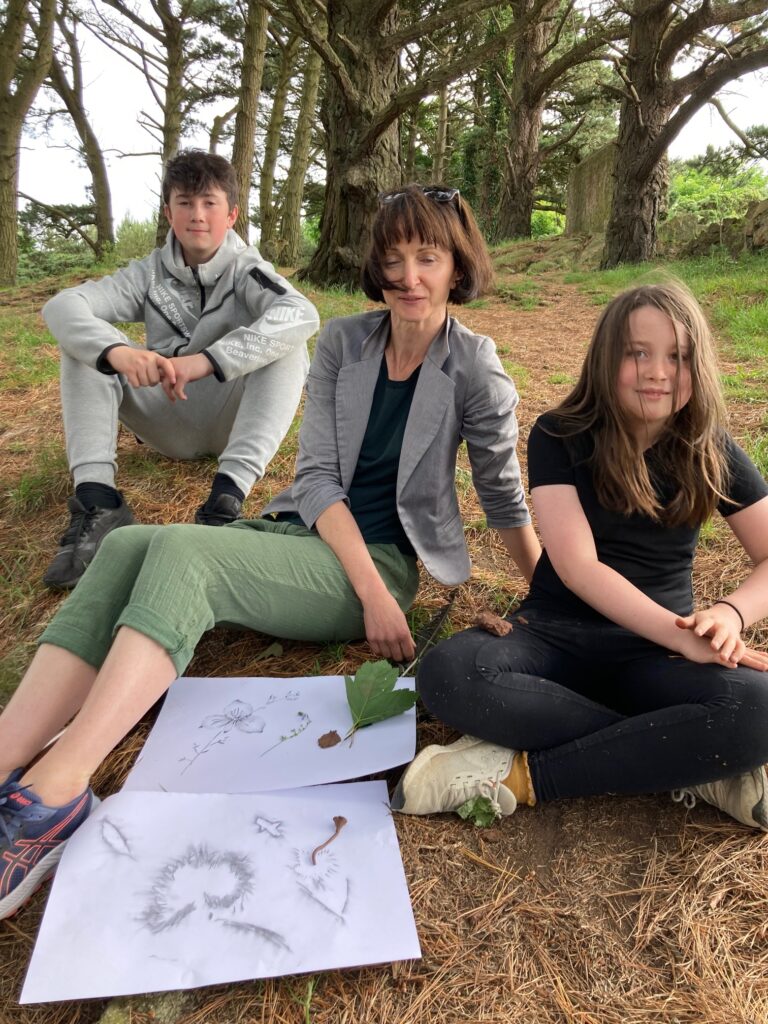
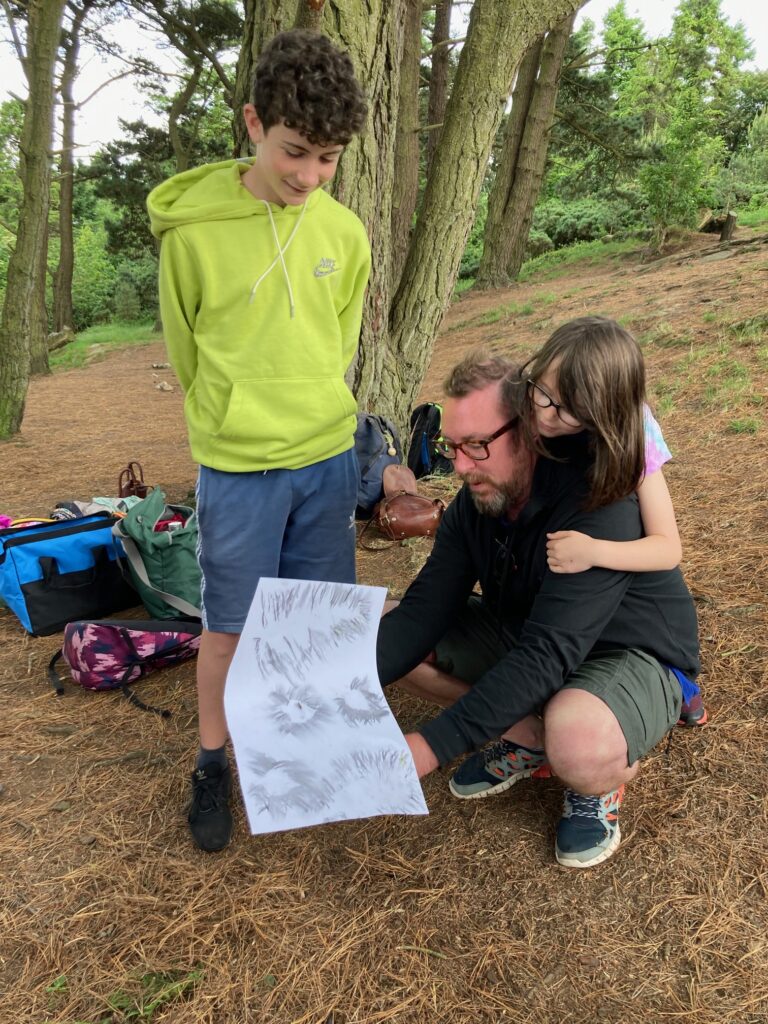
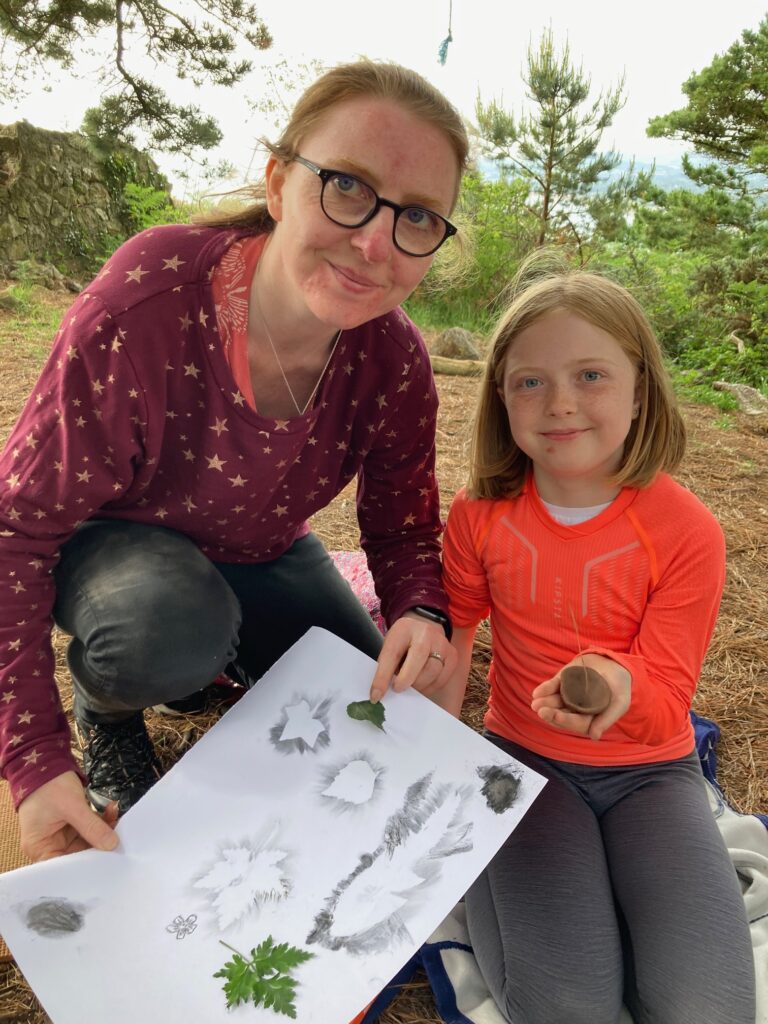
We played a bird game, through which adults also experienced the busy and challenging lives of birds. Then children took their adults to their favourite spot, sat down and had a quiet moment. The forest was silent, and the children and their close adults shared intimate time in nature. In the end, we had a tea ceremony and shared our gratitude from the day. Adults also live a busy life, and the session provided a great opportunity for them to spend time in nature with their children, see and understand what their children were seeing and feeling, and to notice their new abilities, knowledge and skills. It must have been a great gift for the children to play the leader and to be able to share what they love about forest school with their family.
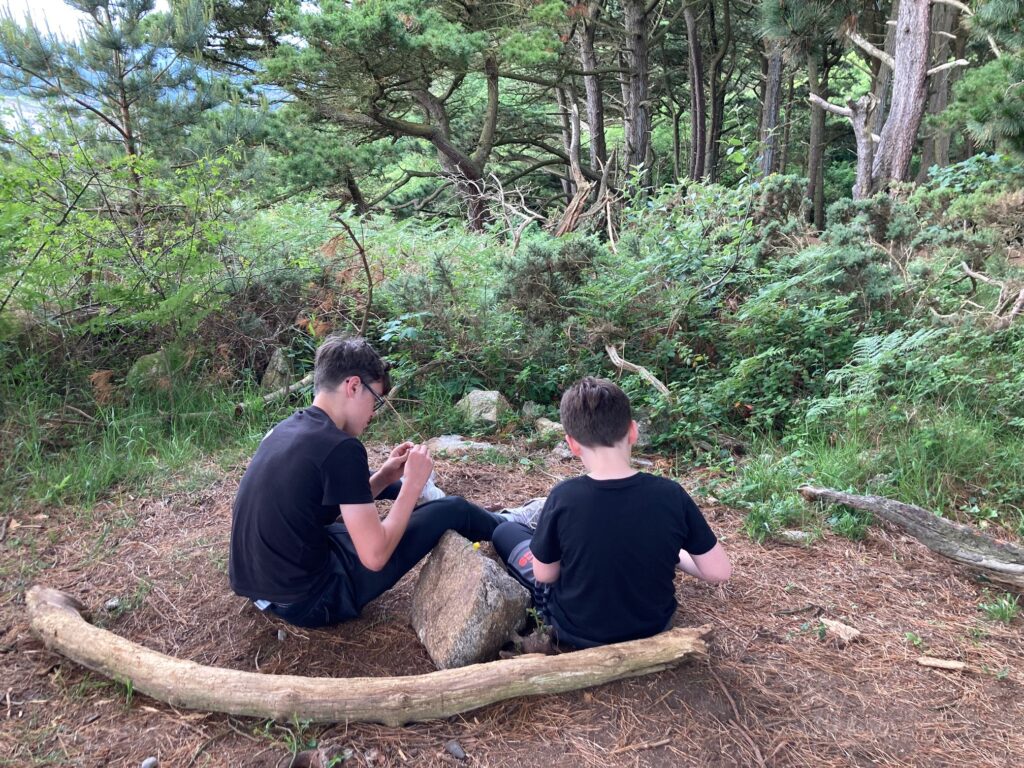
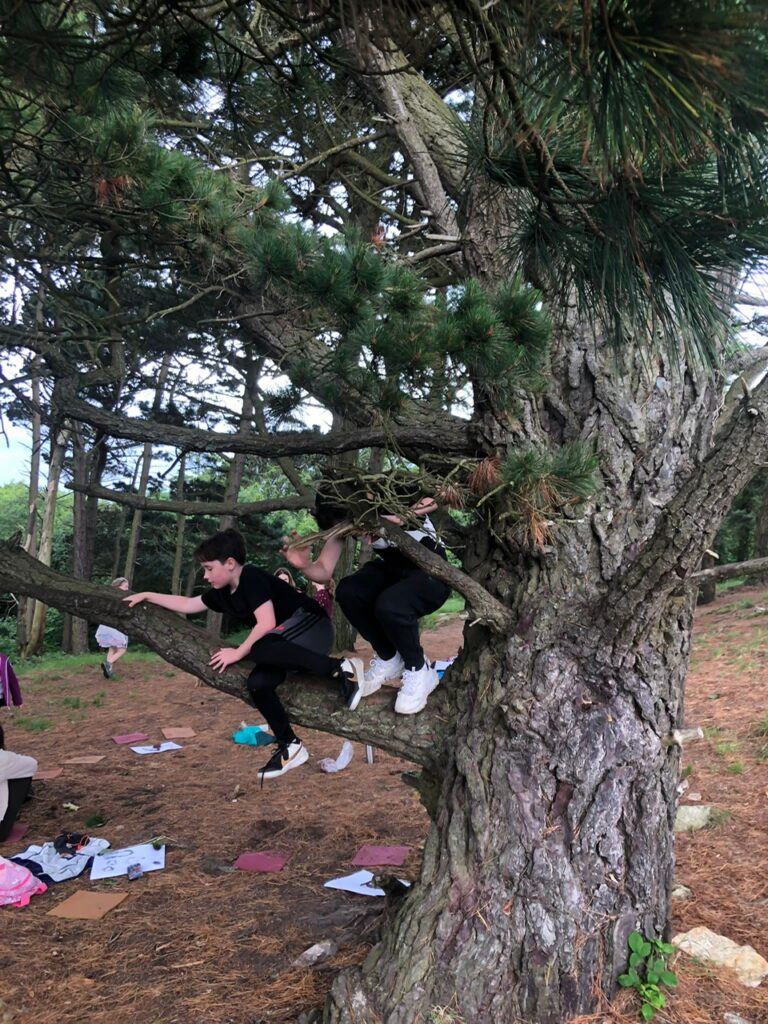
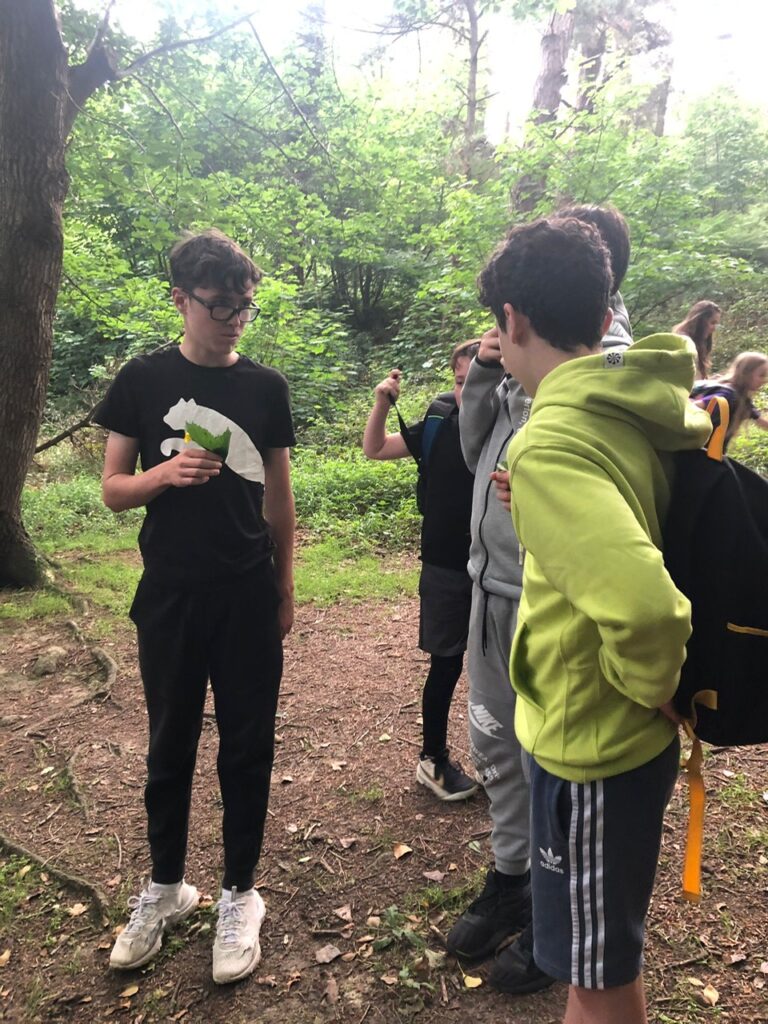
The teenage siblings also seemed to enjoy spending time in the woods, reminiscing about what they did when they were in DSP. One of the boys started to climb a tree, and the others said, “You’re climbing too high, remember the shoulder rule!” There was also a point when they had a challenging task in picking some nettles to make tea with. They tried pressing the leaves hard enough that they would not be stung, but it didn’t work. The third class children were delighted to help their brothers with medicinal plants to heal their pain. The teenagers are now in a different life stage. They are busy and might not have time to spend time and play in nature. However, we hope that the attachment and awe toward nature they once felt, and memories of exploring their curiosity and the imaginary world they occupied when they were small will stay somewhere deep inside them, and travel with them throughout the challenging years of adolescence and indeed, throughout their lives beyond.
Session 8 – 24 June 2022
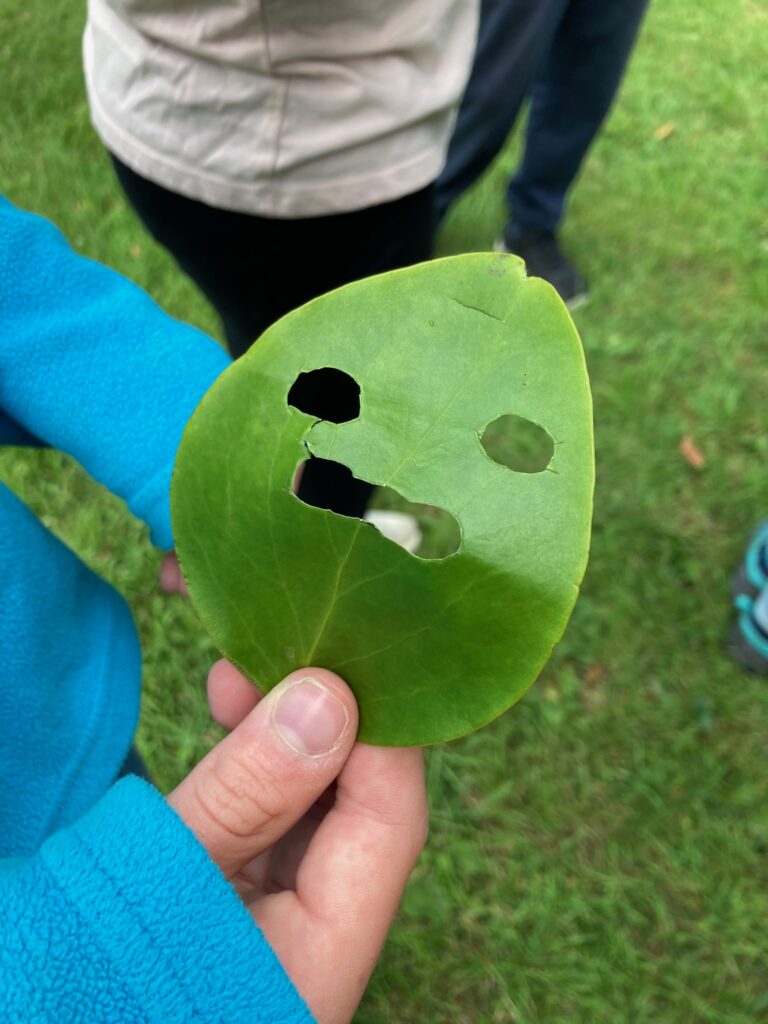
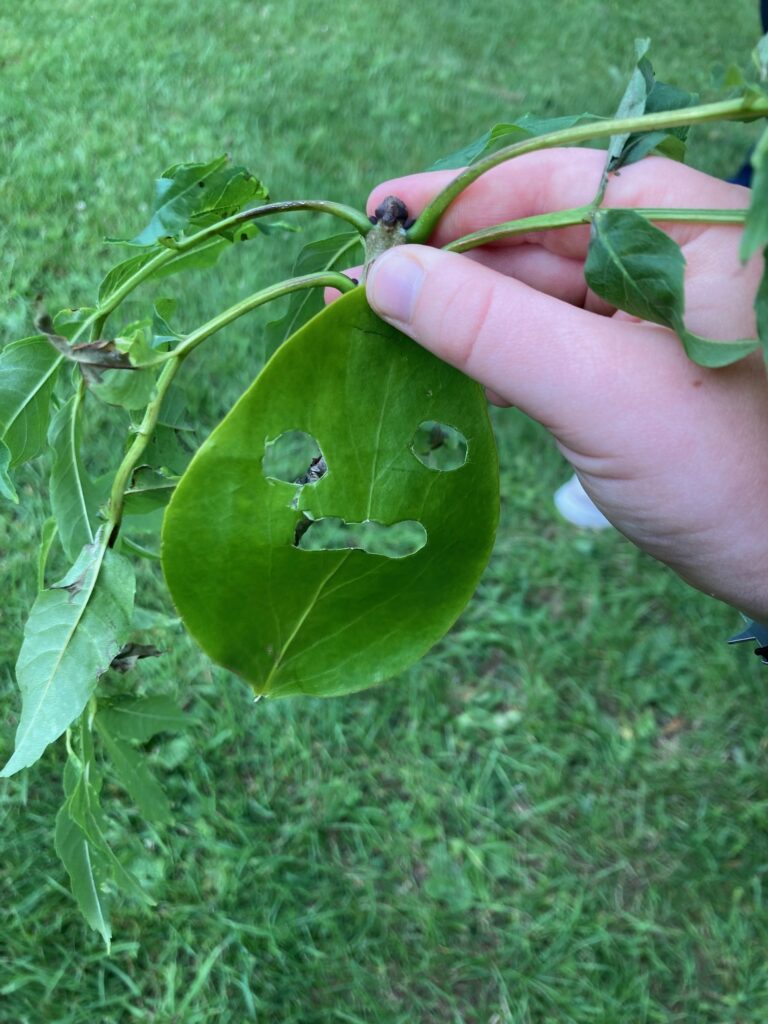
The last day of the third year forest school was windy, and the teacher decided to make the session completely child-led. The children shared what they wanted to do in the opening circle. As requested by one of the children, they played the cuckoo bee game to start, and then went straight up to their basecamp. On the way up, they marched while singing a song.
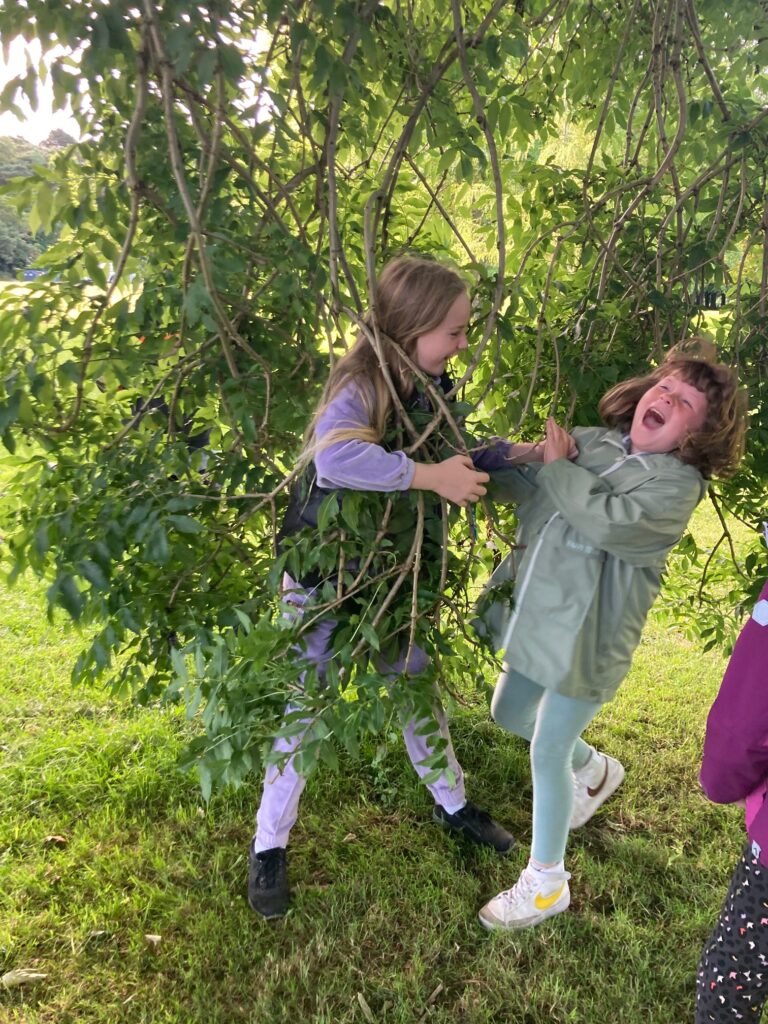
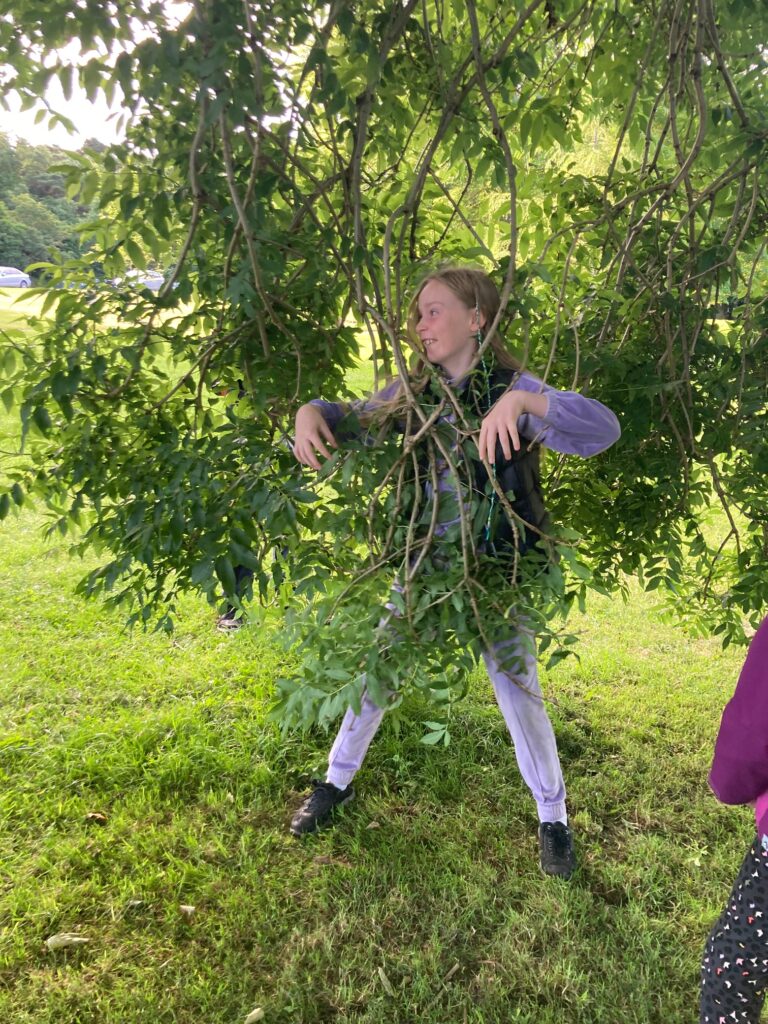
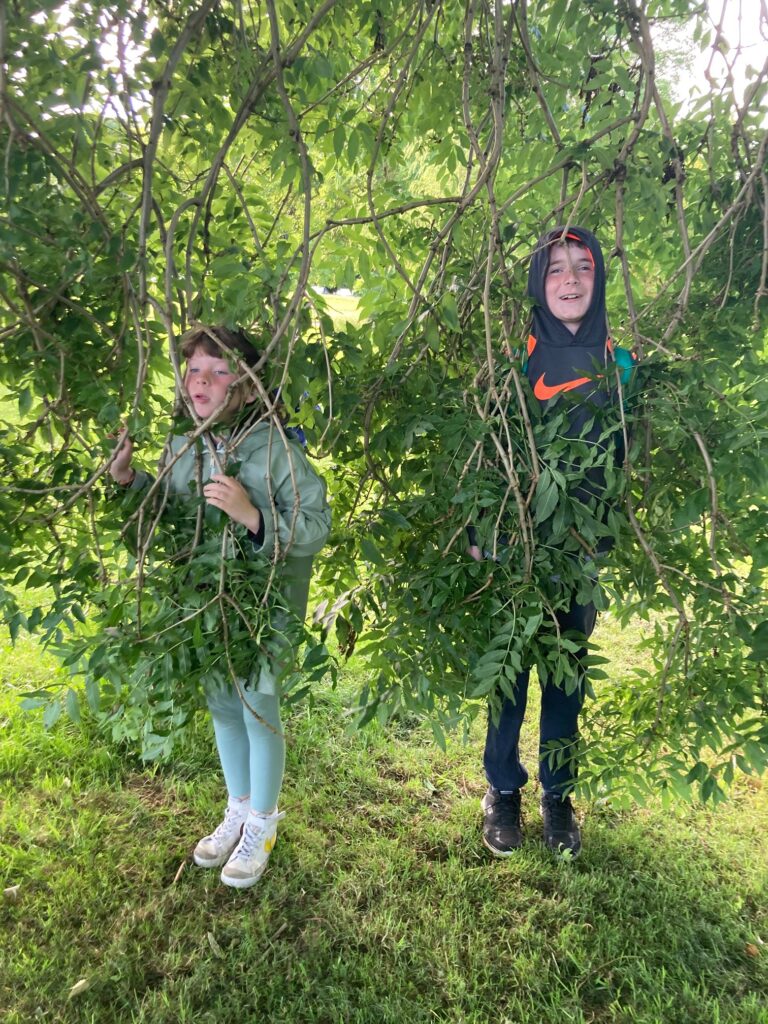
At the base camp, they started a free play. It was a windy day and everything surrounding them was moving dynamically, so that the mood of the children seemed to be affected, and their play was dynamic. Children were running around from one space to another, forming groups, separating, and forming other groups. Some children sat under bushes, pretending to have a drink with leaf cups, or using clay to make cups or mini creatures. Another group of children started to play a gambling game using leaves as money. One of the children said he was bored, but he also said that “sometimes boredom brings great ideas” and just enjoyed collecting sticks and putting them on a piece of dead bark.
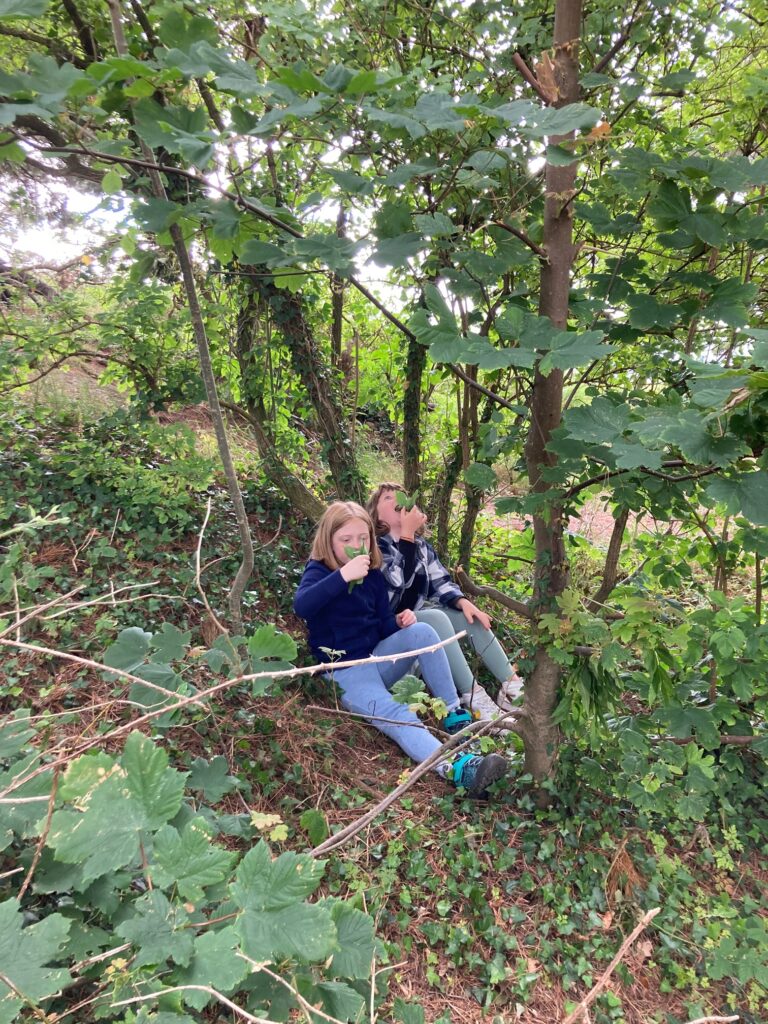
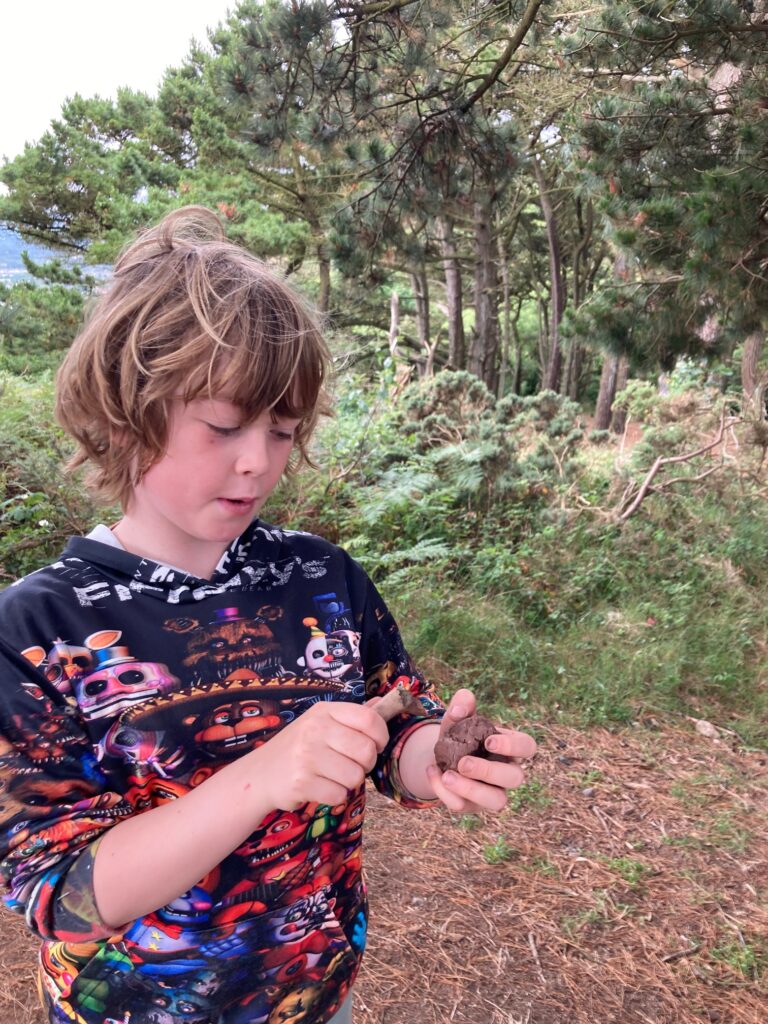
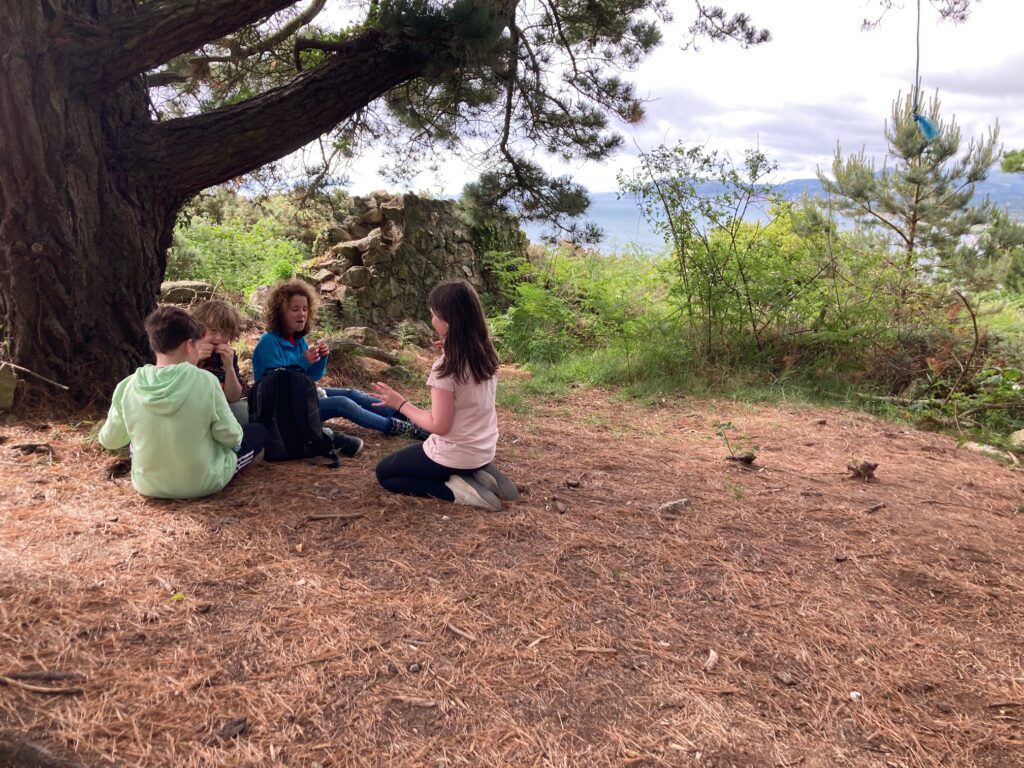
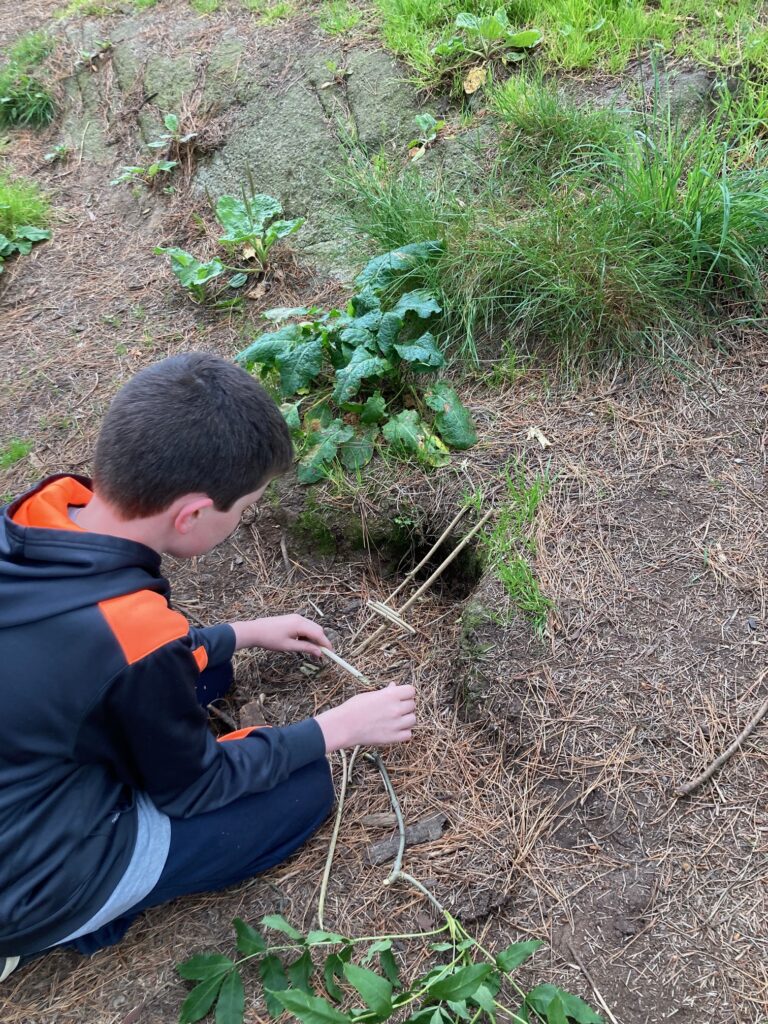
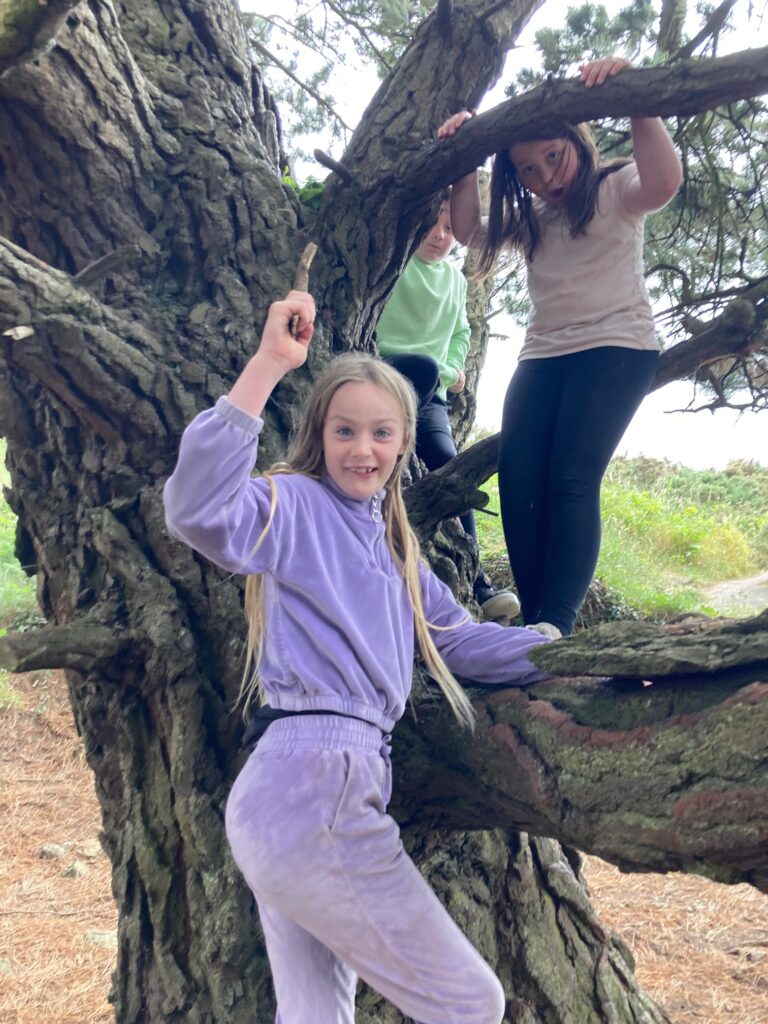
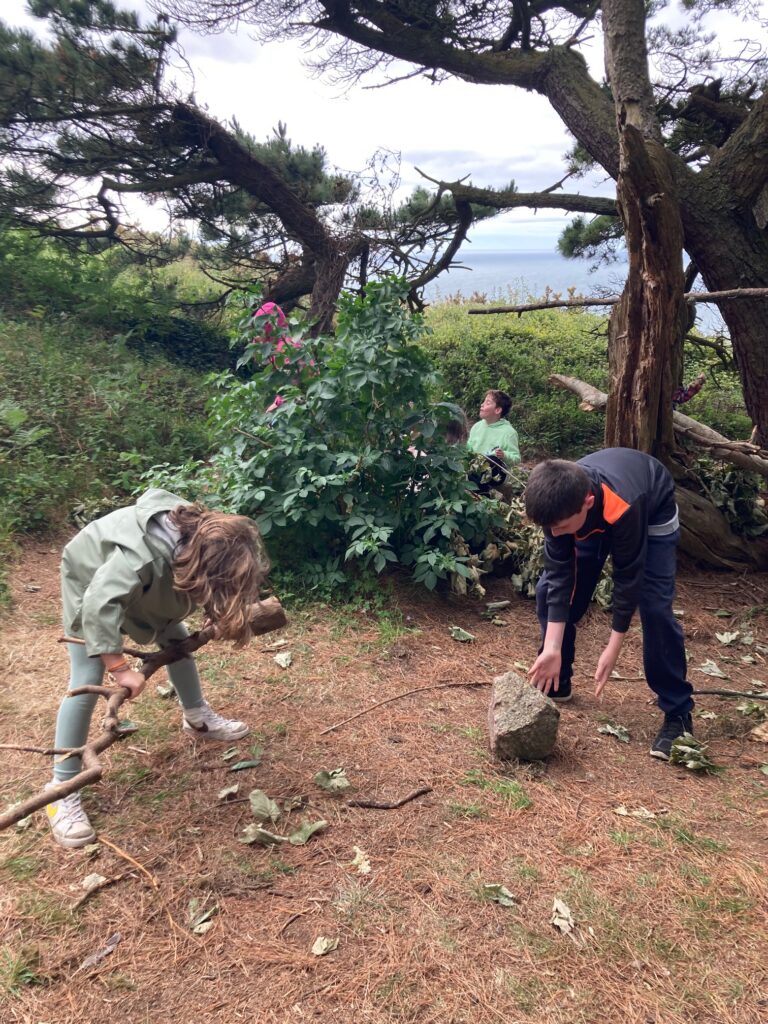
Children play to make sense of their world, and try to understand and digest what they have been observing in their everyday life by imitation. Even play in the woods is sometimes influenced by what they have been reading, seeing on TV, on the Internet or in the lifestyle and behaviour of the adults around them. In particular, this age group of children are becoming more aware of and engaged with the world around them. Nature provides a safe and healthy environment where children can explore the accumulative images they have been immersed in from these sources.
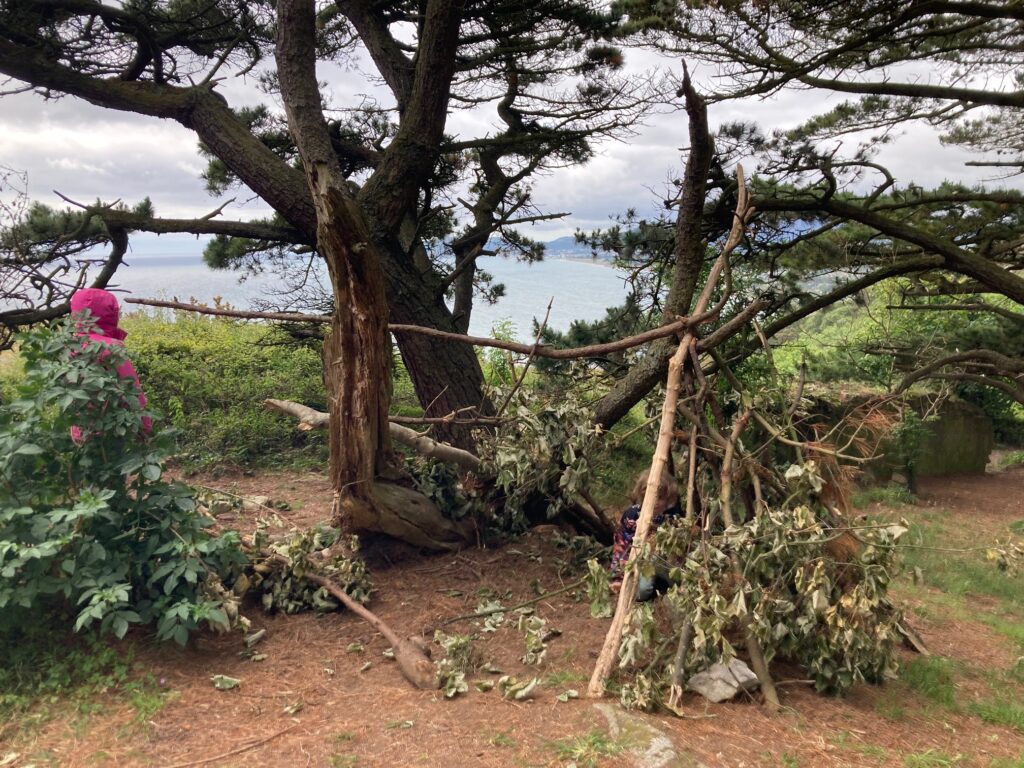
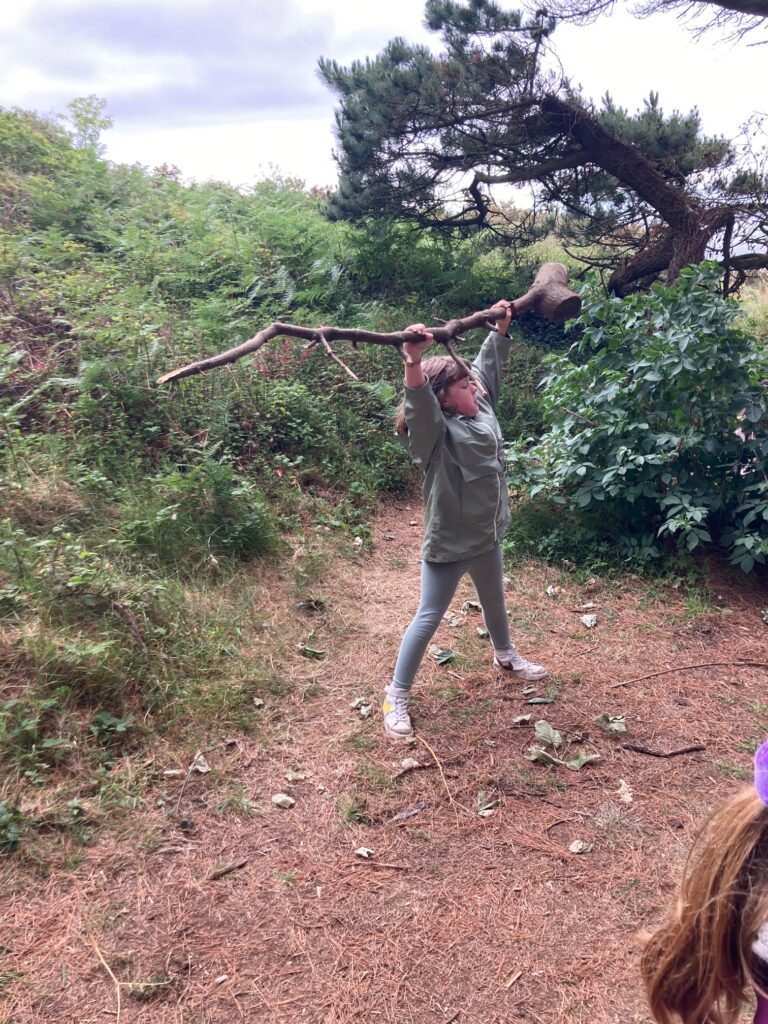
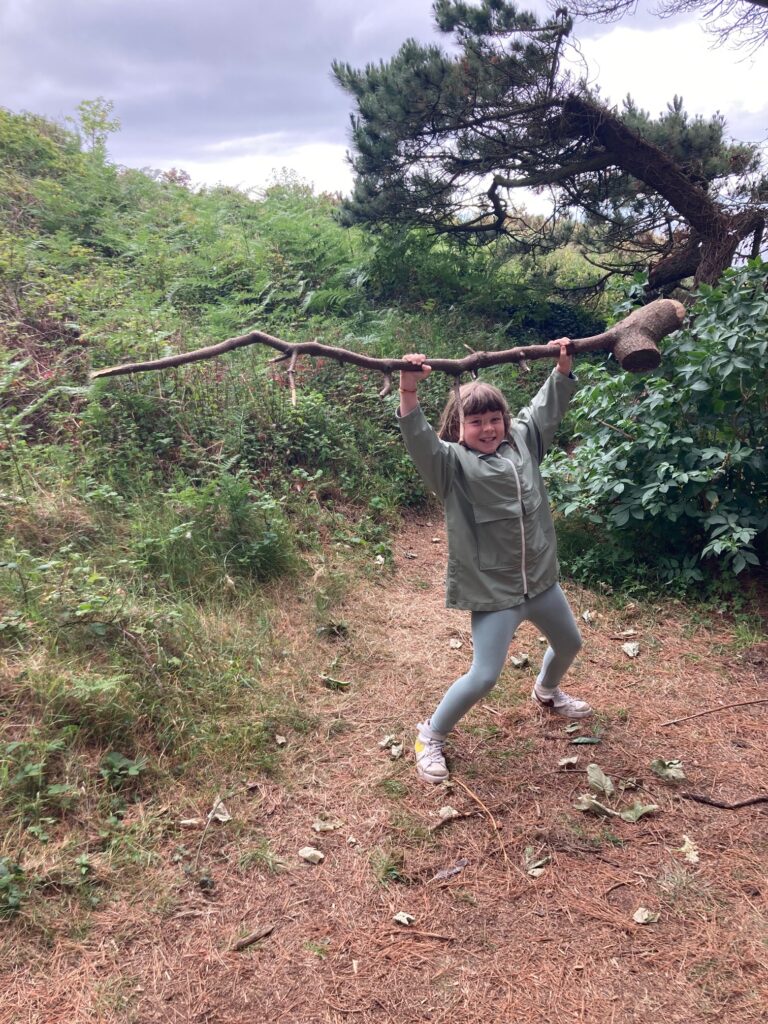
On the other hand, in forest school, there are opportunities to take in additional images that they might not be exposed to a lot in their everyday life, such as making tea from living flowers instead of from packs, or creating something from scratch instead of buying it in the shop, making a circle and having lunch with everyone together and listening to a story told in someone’s real voice, and having free time with nothing but nature and their friends.
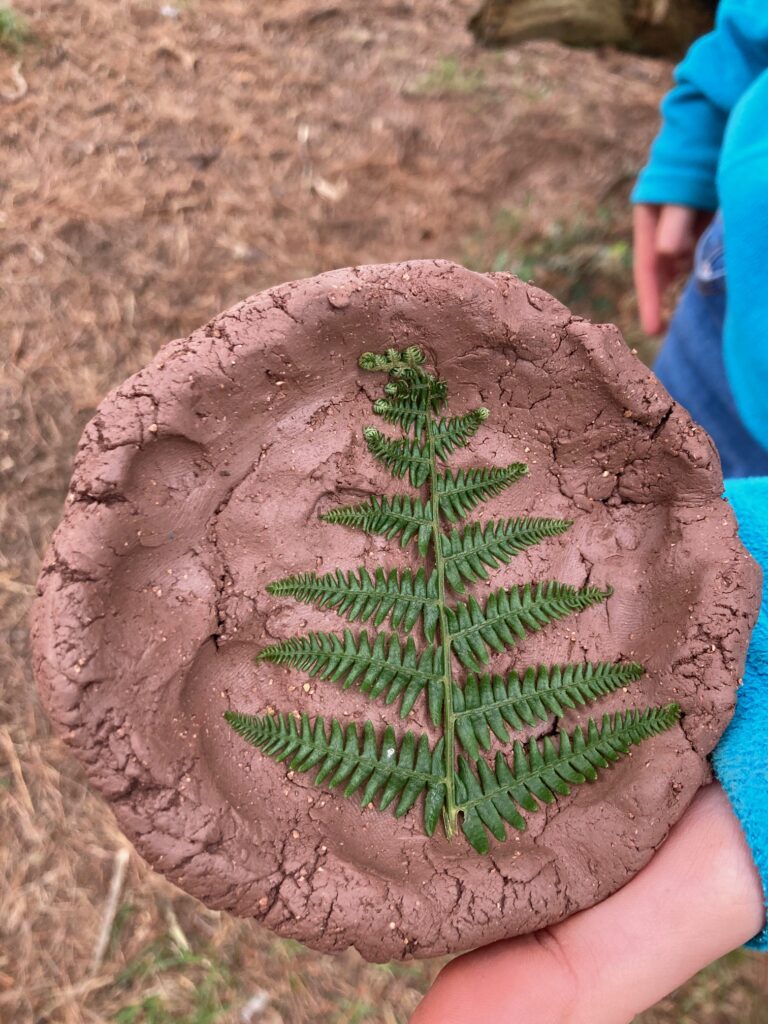
The children chose to play a tag game as a whole group, and after that, it was time for the sit spot, and we shared our gratitude from forest school. The children reflected that they were grateful for “playing the bird game, and making restaurants”, “happy memories”, “being in DSP and having forest school, building cafés, restaurants, a surgery and it was great that it changed every week, and we noticed so many things thanks to everyone”, “being here every Friday, and taking away every memory”, “playing here instead of doing maths” and “having the chance to make a café with my parents”. But I think they have gained more than they think themselves.
I have been observing the DSP forest school for a year, and I am grateful to have encountered several moments when the children’s eyes shined. These faces, full of excitement and joy, sometimes obvious and sometimes quiet, coming from their bottom of their hearts are stuck in my mind. These were the moments when they had the freedom to express themselves, concentrate on their own curiosity, thoughts, challenges and imaginary world, or where they achieved goals they had set themselves. I also loved watching the children gazing on nature, having a private moment.
In these moments, I saw the child’s inner strength, a young life striving to grow, just like any life forms seem to be programmed to strive for their survival and growth. And nature is so pure that it is able to facilitate that and give them freedom to do so.
I am grateful to have been able to be involved in such an inspirational project, which has been initiated by a passionate teacher and forest school leader and an artist who both have so much wisdom and charisma, with the efforts of many amazing teachers and supporters making it possible. The benefits that children are getting from it are enormous even if it might not be evident now. The world they see is the world of our future, and we adults have huge responsibility for that.